
Creating the Global Eco-renaissance – One Community Weekly Progress Update #575
One Community is committed to creating the global eco-renaissance through sustainable approaches to food, energy, housing, education, economics, and social architecture. Our all-volunteer team is dedicated to fulfilled living and global stewardship practices, all for “The Highest Good of All.” By open sourcing and free sharing the complete process, we’re not just regenerating our planet, but also creating a model that becomes self-replicating. Join us in evolving sustainability and creating a world that works for everyone.
- Here’s our project overview
- Here’s our world-change methodology
- Here’s how this becomes self-replicating
- Here’s how we are open source and free-sharing all the do-it-yourself designs
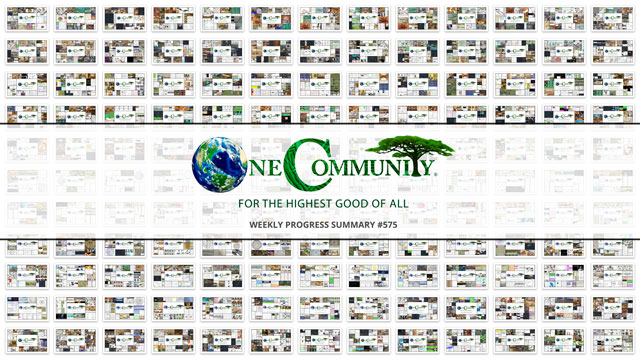
OUR MAIN OPEN SOURCE HUBS
Click on each icon to be taken to the corresponding Highest Good hub page.
One Community’s physical location will forward this movement for creating the global eco-renaissance as the first of many self-replicating teacher/demonstration communities, villages, and cities to be built around the world. This is the March 25th, 2024 edition (#575) of our weekly progress update detailing our team’s development and accomplishments:
Creating the Global Eco-renaissance
One Community Progress Update #575
DONATE | COLLABORATE | HELP WITH LARGE-SCALE FUNDING
CLICK HERE IF YOU’D LIKE TO RECEIVE AN EMAIL EACH WEEK WHEN WE RELEASE A NEW UPDATE
YOU CAN ALSO JOIN US THROUGH SOCIAL MEDIA
ONE COMMUNITY WEEKLY UPDATE DETAILS
HIGHEST GOOD HOUSING PROGRESS
 One Community is creating the global eco-renaissance through Highest Good housing that is artistic and beautiful, more affordable, more space efficient, lasts longer, DIY buildable, and constructed with healthy and sustainable materials:
One Community is creating the global eco-renaissance through Highest Good housing that is artistic and beautiful, more affordable, more space efficient, lasts longer, DIY buildable, and constructed with healthy and sustainable materials:
-
-
- Learn about creating the global eco-renaissance with Our Upcoming Crowdfunding Campaign
- Learn about creating the global eco-renaissance with the different village models: 7 Sustainable Village Models
- Visit the open source portals for the first two: Earthbag Village OS Hub | Straw Bale Village OS Hub
-
This week, Mithil Upadhyay (Mechanical Engineer) utilized CAD designs and accessed Solidworks to assess the advancement of the Vermiculture Toilet design project. He worked on determining the dimensions based on the CAD designs for the ideas submitted in the previous week. Mithil also focused on learning newly added points in the design intent from the vermiculture collaboration document. Safe and sustainable human waste processing systems are an important part of creating the global eco-renaissance with One Community’s open source plans. See below for some of the pictures.
DUPLICABLE CITY CENTER PROGRESS
 One Community is creating the global eco-renaissance through a Duplicable and Sustainable City Center that is LEED Platinum certified/Sustainable, can feed 200 people at a time, provide laundry for over 300 people, is beautiful, spacious, and saves resources, money, and space:
One Community is creating the global eco-renaissance through a Duplicable and Sustainable City Center that is LEED Platinum certified/Sustainable, can feed 200 people at a time, provide laundry for over 300 people, is beautiful, spacious, and saves resources, money, and space:
-
-
- Learn about this building and its teacher/demonstration hub function for creating the global eco-renaissance: Duplicable City Center Open Source Hub
-
This week, Julio Marín Bustillos (Mechanical Engineer) completed another week working on the hub connector. He created a different assembly comprising two stacked diamonds of the first four rows, aiming to design the windows for inclusion within the dome, with the interior design team responsible for this task. Julio also attempted to run the simulation on ANSYS, but the program froze when generating the meshes. The Duplicable City Center is an important part of creating the global eco-renaissance with One Community’s open source plans. See the pictures below for examples related to this work.
Nika Gavran (Industrial Designer) started her collaboration with One Community, completing her orientation and initiating her review of the progress of the Duplicable City Center along with its design and functionalities. She started by researching into the task specifics concerning the 1st and 2nd floor dormer windows, looking into the progress made by previous volunteers on this task. Then Nika imported the latest CAD files and began acquainting herself with the construction of dormer windows. The Duplicable City Center is an important part of creating the global eco-renaissance with One Community’s open source plans. The collage below shows her work for the week.
HIGHEST GOOD FOOD PROGRESS
 One Community is creating the global eco-renaissance through Highest Good food that is more diverse, more nutritious, locally grown and sustainable, and part of our open source botanical garden model to support and share bio-diversity:
One Community is creating the global eco-renaissance through Highest Good food that is more diverse, more nutritious, locally grown and sustainable, and part of our open source botanical garden model to support and share bio-diversity:
-
-
- Learn about the food structures we’re open sourcing for creating the global eco-renaissance: Hoop House Hub | Aquapini & Walipini Open Source Hub
- See what we’ll be growing for creating the global eco-renaissance: Gardens & Hoop Houses | Large-scale Structures | Food Forest | TA
-
This week, a core team member made further progress on the Highest Good Food Tools. They continued researching and compiling a list of necessary tools, including both hand tools and power equipment on the food growing aspect of the project. Additionally, they collaborated with Hayley on a call to discuss the integration of food growing initiatives within public schools. The conversation focused on potential methods for aligning these programs with the educational curriculum and fostering connections with local communities. Highest Good food is an important part of creating the global eco-renaissance with One Community’s open source plans. See their work in the collage below.
Charles Gooley (Web Designer) continued to work on the Vegan Rice Recipes page, developing a range of recipes including Vegan Waffles, Red Pepper Linguine, Crispy Smashed Potatoes, Chicken Thighs with Tomatoes, Easy Tofu Scramble with Pan Fried Potatoes, Jerk Sweet Potato & Black Bean Curry, Picadillo and Brown Rice, Whipped Porridge, Brown Rice with Sardine Stew, Potatoes and White Bean Chili, Sausage Casserole, Potato Salad with Crushed Tofu, Sweet Potato and Lentil Curry, Breakfast Scones with Egg Omelets, Stir Fried Rice with Mixed Veggies and Tofu, and Honey Roasted Chicken with Baked Sweet Potatoes. Placeholder images were utilized, awaiting replacement with final images upon availability. Highest Good Food is an important part of creating the global eco-renaissance with One Community’s open source plans. See his work in the collage below.
Hayley Rosario (Sustainability Research Assistant) completed the summary of the school and small organization plan, incorporating examples, links, and videos to provide comprehensive explanations. Additionally, she integrated the Highest Good Food list, including images and descriptions, into the Highest Good Food document for further review, instruction, and updates. Highest Good Food is an important part of creating the global eco-renaissance with One Community’s open source plans. See below for pictures related to her work.
HIGHEST GOOD EDUCATION PROGRESS
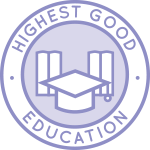 One Community is creating the global eco-renaissance through Highest Good education that is for all ages, applicable in any environment, adaptable to individual needs, far exceeds traditional education standards, and more fun for both the teachers and the students. This component of One Community is about 95% complete with only the Open Source School Licensing and Ultimate Classroom construction and assembly details remaining to be finished. We’ll report on the final two elements to be finished as we develop them.
One Community is creating the global eco-renaissance through Highest Good education that is for all ages, applicable in any environment, adaptable to individual needs, far exceeds traditional education standards, and more fun for both the teachers and the students. This component of One Community is about 95% complete with only the Open Source School Licensing and Ultimate Classroom construction and assembly details remaining to be finished. We’ll report on the final two elements to be finished as we develop them.
With over 8 years of work invested in the process, the sections below are all complete until we move onto the property and continue the development and open sourcing process with teachers and students – a development process that is built directly into the structure of the education program and everything else we’re creating too:
- Creating the global eco-renaissance with education, program overview: Education Open Source Hub
- How the components work together for creating the global eco-renaissance: How to use the Education for Life Program
- Lesson Plans for Life – Lesson Plans How-to
- Foundations of Outstanding Leaders, Teachers, and Communicators
- Curriculum for Life
- Teaching Strategies for Life
- Learning Tools and Toys for Life
- Evaluation and Evolution

Highest Good Education: All Subjects | All Learning Levels | Any Age – Click image for the open source hub
HIGHEST GOOD SOCIETY PROGRESS
 One Community is creating the global eco-renaissance through a Highest Good society approach to living that is founded on fulfilled living, the study of meeting human needs, Community, and making a difference in the world:
One Community is creating the global eco-renaissance through a Highest Good society approach to living that is founded on fulfilled living, the study of meeting human needs, Community, and making a difference in the world:
-
-
- Read how Highest Good society contributes to creating the global eco-renaissance: Highest Good Society
- Learn about the model for fulfilled living and sharing as part of creating the global eco-renaissance: A Day in the Life
- Learn about the 4 economic models for creating the global eco-renaissance: RBE | For-profit | Non-profit | Entrepreneurship
- Learn about our open source community collaboration and management software for creating the global eco-renaissance: The Highest Good Network
-
This week, the core team completed around 65 hours managing One Community volunteer-work review not included above, emails, social media accounts, web development, new bug identification and bug-fix integration for the Highest Good Network software and interviewing and getting set up new volunteer team members. We also shot and incorporated the video above that talks about creating the global eco-renaissance and how creating the global eco-renaissance is an important part of the bigger picture of everything One Community is doing. The pictures below show some of this work.
Aaron Wang (Fundraising Assistant) continued helping to research possible funding sources for One Community. He did extensive research to establish connections with Leonardo DiCaprio, focusing on locating emails and LinkedIn profiles of individuals who may have insights into DiCaprio and the narratives behind their funding. This initiative is part of a broader strategy aimed at facilitating connections with funders by establishing relationships with relevant individuals involved in those donations. Establishing win-win relationships like this are a big part of One Community’s model for creating the global eco-renaissance. See below to check his progress for the week.
Arun Chandar Ganesan (Volunteer Data Analyst And SEO And Social Media Assistant) focused on optimizing the first three web pages for SEO and awaited feedback. Simultaneously, he completed the social media takeover. Following this, Arun optimized the remaining pages for SEO and updated the scores accordingly in the designated sheet. Search engine optimization and an ongoing outreach program are important parts of One Community’s model for creating the global eco-renaissance. The pictures below show some of this work.
Cody Media Productions (Video Editing Company) worked on finalizing the intro video for the weekly progress update YouTube videos by incorporating titles and transitions. Their team reviewed the feedback video and made appropriate adjustments, including rearranging images and adding additional ones. These videos will showcase the open source components of One Community as the prototype for creating the global eco-renaissance. You can view this work in the collage below.
ADMINISTRATION TEAM
The Administration Team’s summary, covering their work administrating and managing most of One Community’s ongoing process for creating the global eco-renaissance was managed by Vriddhi Misra (Admin and Marketing Assistant) and includes Alyx Parr (Senior Support Specialist), Camilla Okello (Administrative Assistant), Charuvi Saxena (HR Specialist), Jiaxin Zheng (Data Analyst), Meenakshi Velayutham (Sustainability Associate), Olawunmi “Ola” Ijisesan (Administrative and Management Support), Ram Shrivatsav (Data Analyst and Admin assistant), Ratna Meena Shivakumar (Data Analyst and Admin), Ruiqi Liu (Administrative Assistant), Sai Divya Gudimella (Data Analytics Administrative Assistant), Sneka Vetriappan (Data Analyst), T R Samarth Urs (Data Analyst), Vibhav Chimatapu (Data Analyst/Admin Assistant) and Xiaolai Li (Administrative Assistant). This week Alyx reviewed the work of other Admins and converted videos into audio for the Podcast. Camilla managed administrative duties, reviewed peers’ work, and optimized assigned blogs. Charuvi learned administrative tasks, demonstrated processes through practice sessions, and compiled summaries of volunteers’ activities. Gokul focused on enhancing the website’s search engine optimization (SEO), increasing the SEO score, and rectifying errors within the SEO framework. Jiaxin completed PR reviews, updated team summaries and collages on the webpage, and incorporated feedback into blog content. Meenakshi performed admin tasks, including reviewing weekly blog pages, updating tracking sheets, and making bio announcements. Ram concentrated on mastering SEO techniques, optimizing blog posts, and beginning the initial steps in HGN front-end product testing. Ratna focused on improving the SEO score of multiple blogs through various optimizations. Ruiqi completed review processes for multiple teams, created collage images, generated SEO keywords, and provided assistance to new admins. Sai Divya participated in admin team training, collaborated on the hiring process, and worked on search engine optimization tasks. Sneka contributed to software development projects and administrative tasks, including reviewing feedback and editing SEO pages. Samarth managed the PR review team, applied SEO techniques to optimize blog posts, and received constructive feedback. Vriddhi optimized assigned peers’ blogs, reviewed SEO work, revised tracking spreadsheets, compiled summaries, proofread, and edited blog posts. Xiaolai completed weekly reports, reviewed training processes, and organized documents and summaries. One Community’s model for creating the global eco-renaissance includes developing and maintaining a huge administration team like this. You can see the work for the team in the image below.
GRAPHIC DESIGN TEAM
The Graphic Design Team’s summary was managed by Ruiqi Liu (Administrative Assistant) and included Ashlesha Navale (Graphic Designer), Tharanga Pathirana (Graphic Designer) and Nancy Mónchez (Graphic Designer). Ashlesha created a Volunteer Announcement and made bio and announcement images while updating web content for the announcement. Additionally, she created six Social Media Images and researched nature-based and theme-based images to enrich the platform’s visual content. Nancy focused on enhancing social media posts, experimenting with stylistic variations to maintain consistency while introducing diverse elements such as individuals, natural backgrounds, animals, and illustrations. Tharanga reviewed and refined a detailed Google document outlining the volunteer setup process, leveraging AI prompts for image generation, and collaborating with team members to ensure clarity and effectiveness across various web pages and links. See the Highest Good Society pages for more on how this relates to creating the global eco-renaissance. The collage below shows some of this work.
HIGHEST GOOD NETWORK PROGRESS
 One Community is creating the global eco-renaissance through open source Highest Good Network® software that is a web-based application for collaboration, time tracking, and objective data collection. The purpose of the Highest Good Network is to provide software for internal operations and external cooperation. It is being designed for global use in support of the different countries and communities replicating the One Community sustainable village models and related components.
One Community is creating the global eco-renaissance through open source Highest Good Network® software that is a web-based application for collaboration, time tracking, and objective data collection. The purpose of the Highest Good Network is to provide software for internal operations and external cooperation. It is being designed for global use in support of the different countries and communities replicating the One Community sustainable village models and related components.
This week, a core team member worked on Highest Good Network PRs testing, confirming the fixes for several PRs, including improving the Profile Page Teams Tab UX (PR #1927), resolving the issue with the “thank you” message not displaying when selecting the home country option on the profile initial setup page (PR #2056), and moving the “eye” icon on the Reset Password modal (PR #2066). However, several PRs remained unresolved, such as update of the tangible time process, default visible/invisible setting for the Mentor role, and the inability to prevent editing of Jae’s accounts despite PR #2026. Additionally, the Blue Square Scheduler still allows requests for time off for a week that has already passed (PR #1994). In addition to PR testing, a Volunteer account to test Tangible time updates and recorded a video for the Tangible time update task has been set up. The Highest Good Network software is how we’ll be managing and objectively measuring our process for creating the global eco-renaissance through our social architecture, construction, production, and maintenance processes. See below for pictures related to their work.
ALPHA SOFTWARE DEVELOPMENT TEAM
The Alpha Team’s summary, covering their work on the Highest Good Network software was managed by Sucheta Mukherjee (Software Developer) and includes Navya M (Full Stack Developer), and Shamim Rahman (Software Engineer). The Highest Good Network software is how we’ll be managing and objectively measuring our process for creating the global eco-renaissance through our social architecture, construction, production, and maintenance processes. This week, Navya encountered a version downgrade issue while working on a task, and sought assistance in the Slack channel. She then implemented some functionality for the task, proceeded with coding, completed implementation, and initiated testing. Additionally, Navya contributed their part to creating the global eco-renaissance as they reviewed pull requests #803, #804, and #805, and joined the testing team, participating in a Zoom meeting to gain insights into testing procedures and discuss related matters. Shamim reviewed seven different pull requests (PRs) numbered PR#2075, PR#2073, PR#2065, PR#1798, PR#1931, PR#2074, and PR#1862. He also handled functionality tests and provided feedback by commenting on the PRs with both screenshots and videos. PR#1862, PR#1798, and PR#2075 were found to not work as intended, so he shared the results. See the Highest Good Society and Highest Good Network pages for more on how this relates to creating the global eco-renaissance. View some of the team’s work in the collage below.
BADGES BUGS SOFTWARE DEVELOPMENT TEAM
This week, the Badges Bugs Team’s summary overseeing advancements in the Highest Good Network software, was managed by Shaofeng Li (Software Engineer). The team comprised Renan Luiz Santiago Martins César (Full-stack developer), Summit Kaushal (Backend Software Developer), Xiao Zhang (Software Engineer), and Xiaohan Meng (Software Engineer). The Highest Good Network software is how we’ll be managing and objectively measuring our process for creating the global eco-renaissance through our social architecture, construction, production, and maintenance processes. This week, Xiao made efforts to enhance their project by establishing a specific function aimed at efficiently allocating X hours across a single week. He improved code structure and readability by segregating the initial XHoursForXWeeks function into two separate components, making the code more concise and easier to navigate, which refined the process for time allocation in their software endeavors. Shaofeng worked on the HGN Software Development project, working on activities ranging from integration testing of new features to debugging and team meetings, aimed at enhancing software functionality and team efficiency. He also focused on optimizing workflow by merging tasks, aiding new team members, and investigating database discrepancies to unify development and production environments. Xiaohan contributed their part to creating the global eco-renaissance as they concentrated on testing the ‘Assign Badge’ permission feature, deploying applications, and discussing outcomes with her manager, leading to the preparation and testing of the feature’s Pull Request. Summit reviewed and debugged code for Part B, discarded an unworkable function, and formulated a plan for a new approach while also reviewing badge code and studying software management principles. Renan Luiz tested the backend using nodemon for badge implementation, addressing issues such as date inconsistencies in MongoDB and debugging the CheckXHrsForWeek function based on documentation to rectify functionality in the local HGN environment. Collectively, their work contributed to their projects through technical troubleshooting, code enhancement, team collaboration, and strategic planning. See the Highest Good Society and Highest Good Network pages for more on how this relates to creating the global eco-renaissance. View some of the team’s work in the collage below.
BLUE STEEL SOFTWARE DEVELOPMENT TEAM
This Blue Steel Team’s summary, covering their work on the Highest Good Network software was managed by Nathan Hoffman (Software Engineer, Team Manager) and includes Alex Brandt (Full Stack Developer), Bhuvan Dama (Full stack Developer), Jingyi Jia (Software Engineer), Shiqing Pan (Full-Stack Software Developer), Swathy Jayaseelan (Software Engineer), Tzu Ning “Leo” Chueh (Software Engineer) and Yaohong Xiang (Software Engineer). This week, Nathan examined Jay’s permissions PRs, uncovering peculiar logic and consulting Xiao for clarification, while also investigating MongoDB atomic updates for time entry adjustments and offering support on Slack. Jingyi created a frontend solution to bolster the badge management system, enhancing the togglePermission function within the PermissionListItem component to automatically grant “seeBadges” permission alongside badge management permissions, submitting pull request #2085 for review. Alex finalized the ChatGPT integration feature, submitting initial pull requests for both frontend and backend components, addressing requested changes on the backend and reviewing frontend pull request #2075. Bhuvan contributed their part to creating the global eco-renaissance as they focused on enhancing test coverage for the Notes section, achieving 73.91% coverage for ToogleSwitch.jsx and complete coverage for TriStateToggleSwitch while encountering difficulties with TableFilter.js. Shiqing handled formatting issues on the weekly summaries submission page and managed PR reviews for multiple submissions, including offering feedback and solutions for bug rectification. Yaohong advanced the “Quick Setup Modal” feature, resolving rendering issues from PR 1673 but facing challenges with data storage mechanisms. Swathy finalized PR-2035 for submission, reviewed PR 804, and tackled unit test issues with the Projects component. Meanwhile, Tzu Ning refined the teamCodeChange method, optimizing the tracking and updating of team code counts while implementing logic to manage state variables. See the image below to view some of their work.
CODECRAFTERS SOFTWARE DEVELOPMENT TEAM
The Code Crafters Team’s summary, covering their work on the Highest Good Network software, was managed by Anirudh Ghildiyal (Software Engineer) and includes Anirudh Dutt (Software Developer), Ramya Ramasamy (Software Engineer), Nahiyan Ahmed (Full Stack Software Developer), Shantanu Kumar (Software Developer), Shengjie Mao (Software Engineer), Sophie Lei (Software Engineer), Weiyao Li (Software Engineer) and Tapan Pathak (Software Engineer). The Highest Good Network software is how we’ll be managing and objectively measuring our process for creating the global eco-renaissance throughout our social architecture, construction, production, and maintenance processes. Anirudh D created a permissions constants file in the utils of the front end to avoid hardcoding the permissions. He addressed an issue with the branch, realizing it was related to the development branch, fixed his issues, pushed his branch, and raised a PR. He also joined the unit testing team with Diego and learned more about unit testing. And Anirudh G reviewed the feedback on the raised PR and proceeded to make necessary changes and commit updates. He also reviewed tasks sent for review by teammates Anirudh D, Nahiyan, and Weiyo, finding the work satisfactory. Additionally, he completed writing most of the unit test cases, with two failing and requiring attention, intending to resolve them and raise a PR for review. He led the weekly standup and had follow-ups with teammates regarding their work for the week, making final changes and updates to the code. Lastly, Anirudh G reviewed teammates’ summaries, pictures, and weekly videos, finding everything satisfactory. Nahiyan addressed several issues in his development tasks, focusing on enhancing the user experience by fixing the Basic Information tab on the User Profile page and investigating and resolving a critical bug causing crashes in the time log and dashboard pages when a user is deleted from a project with assigned tasks. Shantanu carried out pull request reviews and spent time debugging issues in the repository, providing feedback, and contributing to code improvements. Shengjie contributed their part to creating the global eco-renaissance as they focused on developing unit tests for the TagSent component in the WBS and engaged in discussions with fellow developers regarding challenges encountered while writing unit tests for the BMLogin component. Sophie improved the tasks and contributed a section of report #2005 for Yixiao, making the table mobile-friendly and adjusting the header component to only appear on desktop devices. Tapan addressed the task of fixing the Pagination UI in the Members table and resolving memory leaks observed on the user profile page. Weiyao began his first week with the Development team, primarily engaging in the study of React/Redux. He also familiarized himself with an assigned feature related to creating new users, reviewed React/Redux concepts through a practical demo project and got familiar with the existing codebase pertinent to the feature. See the Highest Good Society and Highest Good Network pages for more on how this relates to creating the global eco-renaissance. The collage below shows some of this work.
EXPRESSERS SOFTWARE DEVELOPMENT TEAM
The Expressers Team’s summary, covering their work on the Highest Good Network software, was managed by Demi Zayas (Full Stack Software Engineer) and includes Christy Guo (Software Engineer), Ilya Flaks (Software Engineer), Shereen Punnassery (Full Stack Software Engineer), Tareq Mia (Software Engineer), and Mohammad Abbas (Software Engineer). The Highest Good Network software is how we’ll be managing our process of creating the global eco-renaissance throughout our social architecture, construction, production, and maintenance processes. Christy implemented a 3D bar chart into the project’s reporting page and provided support to the unit testing team, aiding in the addition of missing unit tests to the backend. Demi focused on reviewing documentation, expanding her understanding of unit testing, and advancing ongoing tasks related to the Tools List and Login rerouting function. She also compiled the team summary and reviewed her team’s work. Ilya continued his work on Phase II’s “4.5.4 Add routing, controllers for Log Tool request” task, enhancing backend functionality to handle multiple tool items and testing “check out” and “check-in” features on the front end. He refined previous work based on feedback received for PR#2010, integrating additional validation measures into the “edit consumables” form. Mohammad completed 8 PR reviews, unit and feature testing, and ensured codebase integrity across various frontend and backend functionalities. Shereen focused on unit testing the WeeklySummaryModal component and addressed Redux mock store issues to enable correct thunk middleware configuration for store dispatching. Tareq continued refining the aesthetics and functionality of the Team Locations map component, addressing styling issues, implementing sticky headers, ensuring responsiveness across screen sizes, and integrating sorting functionality into table columns. See the Highest Good Society and Highest Good Network pages for more on how this relates to creating the global eco-renaissance. The collage below shows some of this work.
GIT-R-DONE SOFTWARE DEVELOPMENT TEAM
The Git-R-Done Team’s summary, covering their work on the Highest Good Network software, was managed by Sai Deepak Dogiparthi (Software Developer) and includes Chris Chen (Software Engineer Intern), Miguelcloid Reniva (Software Developer), Nidhi Galgali (Software Developer), Rhea Wu (Software Engineer), and Shuhua Liu (Full-Stack Developer). The Highest Good Network software is how we’ll be managing our process of creating the global eco-renaissance throughout our social architecture, construction, production, and maintenance processes. Chris developed and integrated both backend and frontend functionalities for an equipment detail page in a building management dashboard. Leveraging Mongoose with Node.js on the backend, he implemented a controller function to fetch tool information by ID, facilitating seamless data flow and improving user interaction. On the frontend, utilizing React and Redux, Chris designed the EquipmentDetail component to dynamically display fetched data, such as project name and current usage, while ensuring smooth navigation and user interaction. Miguel collaborated with Ilya to optimize the backend component of the Tools Log form, ensuring optimal properties and addressing animation and alignment issues for enhanced user experience. Nidhi worked on MongoDB querying for the BMdashboard, laying the groundwork for backend development and schema drafting for the Equipment detail page. Rhea focused on advancing pull requests, enhancing her skills through tutorials and articles. Deepak concentrated on completing the equipment details page and discussed additional fields and database connectivity during team meetings. Shuhua streamlined communication between frontend and backend systems, integrating Manager Icons into the tasks tab and developing new components to display manager information effectively. See the Highest Good Society and Highest Good Network pages for more on how this relates to creating the global eco-renaissance. The collage below shows some of this work.
MOONFALL’S SOFTWARE DEVELOPMENT TEAM
Moonfall Team’s summary, covering their work on the Highest Good Network software, was managed by Navneeth Krishna (Software Engineer) and includes Abdelmounaim “Abdel” Lallouache (Software Developer), Cheng-Yun Chuang (Software Engineer), Haoji Bian (Software Engineer), Jiadong Zhang (Software Engineer), Lu Wang (Software Engineer) and Malav Patel (Software developer). The Highest Good Network software is how we’ll be managing and objectively measuring our process for creating the global eco-renaissance throughout our social architecture, construction, production, and maintenance processes. Abdelmounaim updated the format and style of the blue square notification email, making PR #801 for this update. Additionally, he addressed the issue of the invalid date in the blue square description and submitted PR #2080 for these fixes. Furthermore, he improved the functionality of the time off indicator on the leaderboard, ensuring its visibility whenever a user has scheduled time off. Cheng-Yun focused on implementing a function to delete a member in the task and project if the member has been removed from the user profile. Haoji’s focus was on improving the loading time of the user management page within the application. Previously, the page required 26 seconds to fully load, which was identified as a performance bottleneck. After optimization efforts, the loading time has been reduced to less than 4 seconds, reflecting an 80% reduction. Jiadong focused on enhancing the dashboard by updating the badge display and improving the timelog section of the frontend. His work involved refactoring the tab contents to ensure they are more readable and easier to maintain, enhancing overall code quality and user experience. Lu focused on debugging test functions for critical components, including the AddTaskModal, EditTaskModal, and ImportModal files. She checked and used different ways for debugging, including checking Redux Action Dispatch to verify that the updateTask action creator in the EditTaskModal component is correctly defined and dispatched as a plain object. Malav developed DELETE_TIME_ENTRY_OWN feature and posted a Malav_Delete_Time_Entry_Own PR (#2087) with detailed documentation. Navneeth addressed a critical review on one of his pull requests, focusing on code cleanup and adding necessary functionality to enhance user experience. He responded to reviewer feedback and ensured that the PR was marked as a high-priority item for re-review. Additionally, Navneeth played a pivotal role in the ongoing development of the “Permissions Management: View and Interact with Task “✓ ”” feature, addressing implementation bugs and preparing the pull request for review with a “High Priority – Please Review First” tag. See the Highest Good Society and Highest Good Network pages for more on how this relates to creating the global eco-renaissance. Look below for a collage of their work.
REACTONAUTS’ SOFTWARE DEVELOPMENT TEAM
Reactonauts’ Team’s summary, covering their work on the Highest Good Network software, was managed by Masasa Thapelo (Software Engineer) and includes Abi Liu (Software Engineer), Changhao Li (Software Engineer), Dhairya Mehta (Software Engineer), Peterson Rodrigues (Full-Stack MERN Stack Developer), Shengwei Peng (Software Engineer), Shiwani Rajagopalan (Software Engineer), Vikram Badhan (Software Engineer), Yi Feng (Full-Stack Software Engineer) and Yixiao Jiang (Software Engineer). The Highest Good Network software is how we’ll be managing and objectively measuring our process for creating the global eco-renaissance throughout our social architecture, construction, production, and maintenance processes. Abi reviewed Pull Requests, assessing functionality and code cleanliness across 21 pull requests. Changhao developed unit tests for the TimeEntryForm, set up a folder for weekly team pictures, and reported progress to the team manager. Dhairya focused on 10 Pull Requests, testing and verifying the test cases as per the requirements of each pull request. Masasa managed the summary and hosted the weekly meeting, then continued work on permission functionality for enabling access to different capabilities in the user management page. Peterson finalized team filters for administrators, core team members, and owners, creating a pull request for review. Shengwei completed code implementation, created PRs, and provided a demo video for a task. Shiwani created 7 test cases for the WBSTasks unit test, focusing on aspects like WBS name display, link integrity, button functionality, permission display, and button behavior. Vikram focused on unit testing for WeeklySummaryOptions.jsx and ToggleSwitchContainer.jsx files, alongside completing pull request reviews. Yi worked on backend APIs for a high-priority task, submitted one PR, and developed crucial APIs for visualization. Yixiao completed remaining test cases for the header file, creating a branch for the Weekly Summary file unit test. See the Highest Good Society and Highest Good Network pages for more on how this relates to creating the global eco-renaissance. Look below for pictures of this work.
SKYE’S SOFTWARE DEVELOPMENT TEAM
Skye’s summary, covering their work on the Highest Good Network software, was managed by Luis Arevalo (Front End Developer) and includes John Mumbi (Developer), Sameer (Full stack developer) and Yao Wang (Software Engineer). The Highest Good Network software is how we’ll be managing and objectively measuring our process for creating the global eco-renaissance throughout our social architecture, construction, production, and maintenance processes. John addressed feedback on the pagination component, engaging in collaborative discussions with reviewers to understand necessary adjustments and incorporating corrections, and implemented requested changes. Luis finalized his work on adding a warning description, completing the function, and initiating testing to identify any potential bugs. He generated a PR for the feature and concentrated on reviewing his PR and addressing comments, providing feedback to users on their issues and ensuring proper functionality. Sameer spent his second week working on reviewing PR, going through previous reviews and code base to analyze coding structure. Yao completed final testing on multiple pull requests, including PRs 2065, 2047, 2074, 2075, 2030, 2031, 2032, 2034, 2067, 2022, 1960, and 1941. Among these PRs, a mix of front-end and back-end aspects were involved, although the majority leaned towards front-end orientation. See the Highest Good Society and Highest Good Network pages for more on how this relates to creating the global eco-renaissance. See the collage below for some of their work.
SOFTWARE PR REVIEW TEAM A-L
The PR Review Team’s summaries for team members names starting with A-L and covering their work on the Highest Good Network software was managed by Olawunmi “Ola” Ijisesan (Administrative and Management Support) and Jiaxin Zheng (Data Analyst). The Highest Good Network software is a foundation of what we’ll be using to measure our results of creating the global eco-renaissance. This week’s active members of this team were: Aaron Persaud (Software Developer), Anand Seshadri (Software Engineer), Gayathridevi Chithambaram (Full Stack Developer), Harsh Bodgal (Software Engineer), Hetvi Patel (Full Stack Developer), Hoang Pham (Software Developer), Imran Issa (Software Developer), Iven Chih Ken Yao (Software Developer), Jaiwin Thumber (Front-End Develolper), KaiKane Lacno (Software Developer and Team Manager), Kurtis Ivey (Software Engineer), Lin Khant Htel (Frontend Software Developer). They reviewed all the Highest Good Network PRs (Pull Requests) shared in this week’s update. Learn more about how the Highest Good Network will measure and assist in creating the global eco-renaissance in the Highest Good Network open source hub. The collage below shows a compilation of the work from this team.
SOFTWARE PR REVIEW TEAM M-Z
The PR Review Team’s summaries for team members names starting with M-Z and covering their work on the Highest Good Network software was managed by Olawunmi Ijisesan (Administrative and Management Support) and Samarth Urs (Administrative Assistant and Data Analyst). The Highest Good Network software is a foundation of what we’ll be using to measure our results of creating the global eco-renaissance. This week’s active members of this team were: Meet Padhiar (Software Engineer), Mengtian Chen (Software Engineer), Mingqian Chen (Software Engineer), Moe Khalaf (Full Stack Developer), Olga Yudkin (Software Engineer), Priyanka Sharma (Software Engineer), Raj Nada (Software Developer), Sameer Deshpande (Software Engineer), Sanket Kaware (Full stack developer), Sarthak Jaiswal (Full Stack Developer), Tim Kent (Full Stack Software Engineer) and Zijie “Cyril” Yu (Software Engineer). They reviewed all the Highest Good Network PRs (Pull Requests) shared in this week’s update. Learn more about how the Highest Good Network will measure and assist in creating the global eco-renaissance in the Highest Good Network open source hub. The collage below shows a compilation of the work from this team.
AND WE PRODUCED THIS WEEKLY UPDATES BLOG – CLICK HERE TO SUBSCRIBE
FOLLOW ONE COMMUNITY’S PROGRESS (click icons for our pages)
INVESTOR PAGES
GET INVOLVED
A Better Way of Life Through Eco-Communities – One Community Weekly Progress Update #574
One Community is dedicated to creating a better way of life through eco-communities. Our all-volunteer team is working towards sustainable approaches in food, energy, housing, education, economics, and social architecture. Our vision extends beyond individual communities; it’s about creating a model that becomes self-replicating. Our efforts are guided by the principle of doing this for “The Highest Good of All,” ensuring that everything we create is open source and freely-shared. With a focus on evolving sustainability and regenerating our planet, we aim to create a world that works for everyone.
- Here’s our project overview
- Here’s our world-change methodology
- Here’s how this becomes self-replicating
- Here’s how we are open source and free-sharing all the do-it-yourself designs

OUR MAIN OPEN SOURCE HUBS
Click on each icon to be taken to the corresponding Highest Good hub page.
One Community’s physical location will forward this movement of a better way of life through eco-communities as the first of many self-replicating teacher/demonstration communities, villages, and cities to be built around the world. This is the March 18th, 2024 edition (#574) of our weekly progress update detailing our team’s development and accomplishments:
A Better Way of Life Through Eco-communities
One Community Progress Update #574
DONATE | COLLABORATE | HELP WITH LARGE-SCALE FUNDING
CLICK HERE IF YOU’D LIKE TO RECEIVE AN EMAIL EACH WEEK WHEN WE RELEASE A NEW UPDATE
YOU CAN ALSO JOIN US THROUGH SOCIAL MEDIA
ONE COMMUNITY WEEKLY UPDATE DETAILS
HIGHEST GOOD HOUSING PROGRESS
 One Community is creating a better way of life through eco-communities through Highest Good housing that is artistic and beautiful, more affordable, more space efficient, lasts longer, DIY buildable, and constructed with healthy and sustainable materials:
One Community is creating a better way of life through eco-communities through Highest Good housing that is artistic and beautiful, more affordable, more space efficient, lasts longer, DIY buildable, and constructed with healthy and sustainable materials:
-
-
- Learn about Our Upcoming Crowdfunding Campaign as a pathway to a better way of life through eco-communities
- Learn about the 7 Sustainable Village Models as a better way of life through eco-communities
- Visit the open source portals for the first two: Earthbag Village OS Hub | Straw Bale Village OS Hub
-
This week, Mithil Upadhayay (Mechanical Engineer) began working on the Vermiculture Toilet designs within the Earthbag Village (Pod 1). He addressed the design intent outlined in the Google Docs regarding separating the bottom and top chambers. The proposed solution involves implementing a parallel blade design/mechanism, as depicted in the images. These blades will remain open and can be closed when separation is required, as demonstrated. To streamline the process and minimize costs, the suggestion was to utilize or repurpose large metal oil drums instead of manufacturing separate boxes for the bottom chamber. However, further consideration is necessary to determine the optimal mounting method for these drums with the top chamber. One Community’s model for a better way of life through eco-communities includes sustainable waste processing like this. See below for some of the pictures.
DUPLICABLE CITY CENTER PROGRESS
 One Community is creating a better way of life through eco-communities through a Duplicable and Sustainable City Center that is LEED Platinum certified/Sustainable, can feed 200 people at a time, provide laundry for over 300 people, is beautiful, spacious, and saves resources, money, and space:
One Community is creating a better way of life through eco-communities through a Duplicable and Sustainable City Center that is LEED Platinum certified/Sustainable, can feed 200 people at a time, provide laundry for over 300 people, is beautiful, spacious, and saves resources, money, and space:
-
-
- Learn about this building and its function within a better way of life through eco-communities: Duplicable City Center Open Source Hub
-
This week, Julio Marín Bustillos (Mechanical Engineer) completed another week working on the hub connector. He focused on setting up ANSYS on his computer, a specialized software platform designed for Finite Element Analysis (FEA). He navigated through the installation process, ensuring that all necessary components were correctly integrated into his system. Once ANSYS was up and running, Julio proceeded to import the model into the software environment, an important step in laying the foundation for the simulation. He then assigned materials to the various components of the model, considering their physical properties and behavior under different conditions. Then he started on the task of creating meshes, refining the mesh density to strike the delicate balance between computational efficiency and accuracy of results. One Community’s model for a better way of life through eco-communities includes City Center designs like this. See the pictures below for examples related to this work.
HIGHEST GOOD FOOD PROGRESS
 One Community is creating a better way of life through eco-communities through Highest Good food that is more diverse, more nutritious, locally grown and sustainable, and part of our open source botanical garden model to support and share bio-diversity:
One Community is creating a better way of life through eco-communities through Highest Good food that is more diverse, more nutritious, locally grown and sustainable, and part of our open source botanical garden model to support and share bio-diversity:
-
-
- Learn about the food structures creating a better way of life through eco-communities: Hoop House Hub | Aquapini & Walipini Open Source Hub
- See what we’ll be growing as part of creating a better way of life through eco-communities: Gardens & Hoop Houses | Large-scale Structures | Food Forest | TA
-
This week, a core team member made further progress on the Highest Good Food Tools and Equipment document. This week they updated information on the chipper and other tractor attachments. They also continued writing detailed descriptions for individual tools and equipment within the document. They concluded the week with a phone call to the team, suggesting tasks to help them complete their work. Food production improvements are a significant part of creating a better way of life through eco-communities with One Community. See their work in the collage below.
Charles Gooley (Web Designer) focused on the development of the Vegan Rice Recipes page, creating a variety of recipes including Baked Potato and Curried Red Lentil Soup, Brown Rice with Coconut Curried Golden Lentils, Quick BBQ Chicken and Spanish Potatoes, Baked Oatmeal, Chipotle Lime Chicken and Rice, Lemon Pepper Chicken with Orzo, Cornbread, Smoky Lentil Stuffed Sweet Potatoes, One Pot Roasted Red Pepper Pasta, Braised Beef with Ginger and Japanese-Style Brown Rice, Beef Chili with Baked Potatoes, Hearty Breakfast Skillet, Quick Salmon, Preserved Lemon & Olive Pilaf, and Vegan Potato and Corn Chowder. Placeholder images were utilized until final images become available for replacement. Diverse food menus are a significant part of how One Community is designed for creating a better way of life through eco-communities. See his work in the collage below.
Hayley Rosario (Sustainability Research Assistant) finished updating the Highest Good Food list and wrote a summary detailing examples and methods for integrating the Highest Good Food Network (HGF) into small-scale organizations. Her summary included insights that organizations, communities, and schools might be interested in, which adopt HGF practices. She researched articles and watched instructional videos to gather examples and insights, which she then formatted and incorporated the links into her summary. Hayley documented her activities and time spent collaborating with One Community, providing a write up account of her contributions. Food improvements are a significant part of how One Community is designed for creating a better way of life through eco-communities. See below for pictures related to her work.
HIGHEST GOOD EDUCATION PROGRESS
 One Community is creating a better way of life through eco-communities through Highest Good education that is for all ages, applicable in any environment, adaptable to individual needs, far exceeds traditional education standards, and more fun for both the teachers and the students. This component of One Community is about 95% complete with only the Open Source School Licensing and Ultimate Classroom construction and assembly details remaining to be finished. We’ll report on the final two elements to be finished as we develop them.
One Community is creating a better way of life through eco-communities through Highest Good education that is for all ages, applicable in any environment, adaptable to individual needs, far exceeds traditional education standards, and more fun for both the teachers and the students. This component of One Community is about 95% complete with only the Open Source School Licensing and Ultimate Classroom construction and assembly details remaining to be finished. We’ll report on the final two elements to be finished as we develop them.
With over 8 years of work invested in the process, the sections below are all complete until we move onto the property and continue the development and open sourcing process with teachers and students – a development process that is built directly into the structure of the education program and everything else we’re creating too:
- Education Open Source Hub for creating a better way of life through eco-communities
- How the components work together for creating a better way of life through eco-communities: How to use the Education for Life Program
- Lesson Plans for Life as part of creating a better way of life through eco-communities: Lesson Plans How-to
- Foundations of Outstanding Leaders, Teachers, and Communicators within creating a better way of life through eco-communities
- Planned Curriculum for Life as part of creating a better way of life through eco-communities
- Teaching Strategies for Life as part of our creating a better way of life through eco-communities
- Learning Tools and Toys for Life as part of creating a better way of life through eco-communities
- Evaluation and Evolution as part of creating a better way of life through eco-communities

Highest Good Education: All Subjects | All Learning Levels | Any Age – Click image for the open source hub
HIGHEST GOOD SOCIETY PROGRESS
 One Community is creating a better way of life through eco-communities through a Highest Good society approach to living that is founded on fulfilled living, the study of meeting human needs, Community, and making a difference in the world:
One Community is creating a better way of life through eco-communities through a Highest Good society approach to living that is founded on fulfilled living, the study of meeting human needs, Community, and making a difference in the world:
-
-
- Read the Highest Good society overview: Highest Good Society as part of part of creating a better way of life through eco-communities
- Learn about the model for fulfilled living and sharing as part of part of creating a better way of life through eco-communities: A Day in the Life
- Learn about the 4 economic models as part of part of creating a better way of life through eco-communities: RBE | For-profit | Non-profit | Entrepreneurship
- Learn about our open source community collaboration and management software for creating a better way of life through eco-communities: The Highest Good Network
-
This week, the core team completed 56 hours managing One Community volunteer-work review not included above, emails, social media accounts, web development, new bug identification and bug-fix integration for the Highest Good Network software, and interviewing and getting set up new volunteer team members. We also shot and incorporated the video above that talks about creating the a better way of life through eco-communities and how creating a better way of life through eco-communities is a foundation of the bigger picture of everything One Community is doing. The pictures below show some of this work. See below for pictures related to this.
Aaron Wang (Fundraising Assistant) continued helping researching possible funding sources for One Community. Full funding is needed to begin construction of One Community’s model for creating a better way of life through eco-communities. Aaron advanced his in-depth research into connections with Robert Downey Jr., identifying emails and LinkedIn profiles of individuals who may have links to Robert Downey Jr. and his philanthropic contributions. This targeted effort aims to improve the process of engaging with funders by nurturing relationships with pertinent individuals involved in these donations. Aaron’s detailed and strategic approach emphasizes his dedication to effective networking and establishing meaningful connections within the philanthropic sector. One Community’s model for a better way of life through eco-communities includes a huge outreach program. You can view this work in the collage below.
Ray Lee (Graphic Designer, Video Editor) helped this week by creating images for updating our the One Community website header to celebrate and acknowledge Black History Month. One Community’s model for a better way of life through eco-communities includes honoring and celebrating key holidays like this. See the collage image below.
Arun Chandar Ganesan (Volunteer Data Analyst And SEO And Social Media Assistant) began creating social media posts and helping further evolve our open source social media strategy. This week, he focused on creating a written tutorial on adding administrators to manage the Facebook page. Additionally, after obtaining posting access to the One Community Facebook page through Sara, Arun scheduled content from the Open Source Media Design Google Sheet and incorporated several images shared by Jae. Given Meta’s scheduling limitations of posts from 20 minutes to 29 days in advance, Arun has scheduled posts up to April 14th. One Community’s model for a better way of life through eco-communities includes developing and like this. Furthermore, he received access for website editing, which he plans to commence next week.
ADMINISTRATION TEAM
The Administration Team’s summary, covering their work administrating and managing most of One Community’s ongoing process for creating a better way of life through eco-communities was managed by Vriddhi Misra (Admin and Marketing Assistant) and includes Alyx Parr (Senior Support Specialist), Camilla Okello (Administrative Assistant), Jiaxin Zheng (Data Analyst), Meenakshi Velayutham (Sustainability Associate), Olawunmi “Ola” Ijisesan (Administrative and Management Support), Ram Shrivatsav (Data Analyst and Admin assistant), Ratna Meena Shivakumar (Data Analyst and Admin), Ruiqi Liu (Administrative Assistant), Sneka Vetriappan (Data Analyst), T R Samarth Urs (Data Analyst), Vibhav Chimatapu (Data Analyst/Admin Assistant) and Xiaolai Li (Administrative Assistant). This week, Alyx reviewed Purva’s work on her designated page. She combed through Purva’s work, looking at each element for potential errors or inconsistencies. After reviewing Sneka’s work, she provided constructive feedback on the mistakes she noticed, highlighting areas for improvement while acknowledging Sneka’s efforts. Alyx aimed to create a supportive environment for Sneka as a new team member, encouraging her growth in the role. With Sneka engaged in her task, she moved on to her responsibilities, converting and downloading audio files for an upcoming blog post. She ensured the files were correctly formatted and met quality standards. Camilla began her week with Sunday administrative tasks before reviewing and providing feedback to other administrators while attending to her own corrections. Later, she focused on SEO assignments, adjusting and optimizing assigned blogs. Jiaxin concentrated on tasks to enhance team productivity and review processes. She reviewed SOC team reports, PR review team dry runs, reviewed admin teamwork and learned SEO tutorials. Jiaxin completed the PR review training steps and integrated feedback into the process. Meenakshi continued admin tasks, verifying the weekly summary page, tracking contributors, and creating bio announcements. She analyzed and suggested content updates for infographics and proofread social media web images for accuracy. Ola collaborated with administrative teams, provided training to new volunteers, and reviewed completed tasks. She also worked on PR reviews, organized Google Doc workspace, and provided feedback to admins. Ram focused on studying SEO, analyzing articles, and implementing strategies to boost optimization. Ratna completed training, performed weekly summary reviews, and engaged in SEO learning sessions. Ruiqi completed review processes, created collages, updated SEO keywords, and supported new admins. Sneka worked on orientation tasks, integrated keywords, edited SEO pages, and progressed through training steps. Samarth completed PR review team training, managed team members, applied SEO techniques to blog posts, and received constructive feedback. Vibhav completed administrative tasks, reviewed work, edited web pages, and engaged in SEO activities. Vriddhi oversaw OC administration for the Administration, Alpha, Blue Steel, and Badges Bugs teams, refined SEO strategies, delegated tasks, and enhanced tracking spreadsheets. Xiaolai completed weekly reports, reviewed training processes, updated web pages, and organized documents for reports. One Community’s model for a better way of life through eco-communities includes developing and maintaining huge administration team like this. You can see the work for the team in the image below.
GRAPHIC DESIGN TEAM
The Graphic Design Team’s summary was managed by Ruiqi Liu (Administrative Assistant) and included Ashlesha Navale (Graphic Designer) and Nancy Mónchez (Graphic Designer). Ashlesha created nine Social Media Images focused on themes such as Cooperation-Implementing global change, Cooperation-Improving life on earth, and Cooperation-Increased peace and happiness, among others. In addition, she curated nature-based and theme-based images to complement these designs. Nancy concentrated on completing tasks for week 20, particularly refining the designs of Excel lists, and ensuring consistency in style elements to maintain unity and quality standards across the project. She continued efforts to adjust the intensity of the blue tone to meet project requirements. See the Highest Good Society pages for more on how this relates to a better way of life through eco-communities. The collage below shows some of this work.
HIGHEST GOOD NETWORK PROGRESS
 One Community creating a better way of life through eco-communities through open source Highest Good Network® software that is a web-based application for collaboration, time tracking, and objective data collection. The purpose of the Highest Good Network is to provide software for internal operations and external cooperation. It is being designed for global use in support of the different countries and communities replicating the One Community sustainable village models and related components.
One Community creating a better way of life through eco-communities through open source Highest Good Network® software that is a web-based application for collaboration, time tracking, and objective data collection. The purpose of the Highest Good Network is to provide software for internal operations and external cooperation. It is being designed for global use in support of the different countries and communities replicating the One Community sustainable village models and related components.
This week, a core team member worked on the Highest Good Network confirming fixes for several PRs. This included confirming the fix for a recurring issue related to working week dates. However, several PRs remained unresolved, including issues with the default setting for new or converted mentors, the implementation of editing tangible time for non-Admin/Owner roles, and PR1471 regarding the Blue Square Reason Scheduler. They identified a problem where a volunteer user failed to receive a blue square after editing their time entry multiple times. PRs 1218+532, which grants users permission to manage individual user permissions, require clarification on which permission to use. They also engaged in various other activities, including commenting on requests to improve the loading speed of the Weekly Summaries Reports page, fixing the team code dropdown list to display 15 items, addressing a request to add a popup message for invalid team codes, and providing feedback on horizontal scrolling issues on the team page. The Highest Good Network software is how we’ll be managing and objectively measuring our process for a better way of life through eco-communities throughout our social architecture, construction, production, and maintenance processes. See below for pictures related to their work.
ALPHA SOFTWARE DEVELOPMENT TEAM
The Alpha Team’s summary, covering their work on the Highest Good Network software was managed by Sucheta Mukherjee (Software Developer) and includes Chengyan Wang (Software Engineer), Gabriele Canova (Frontend Developer), Navya M (Full Stack Developer), Pratima Singh (Software Developer), Shamim Rahman (Software Engineer), and Yongjian Pan (Software Engineer). The Highest Good Network software is how we’ll be managing and objectively measuring our process for a better way of life through eco-communities throughout our social architecture, construction, production, and maintenance processes. This week, Sucheta focused on addressing a hot fix related to scroll functionality within the timelog section on PR2057 and refactored PR2006 to remove redundancy, particularly concerning password prompts upon clicking the weeklySummaryRecipient button. Additionally, modifications were made to ensure that the weeklySummaryRecipient button rendered exclusively for authorized users, following Jae’s directive, with the implementation including the storage of Jae and Sara’s email addresses as environment variables in both frontend and backend applications for user authorization checks. These tasks were successfully completed and merged into PR2061+792. Navya reviewed the Phase1 bugs document and the permission management Excel, identifying issues and requesting further details from Jae. She also conducted peer reviews for PR #2011 and PR #782, while initiating work on enabling users to change status in the dashboard page. Yongjian decided to redo PR# 842 to create a dark mode for the application due to difficulties in debugging the original PR, aiming to break it into smaller files for easier management. Gabriele, starting work from Wednesday evening due to personal reasons, faced productivity challenges but successfully completed their first pull request (#2065) after several attempts, though encountering lingering issues. Despite time constraints, they conducted pull request reviews, contributing to pull request #2016. Pratima tested various dashboard-related pull requests, providing feedback and suggestions for improvements. Shamim diligently reviewed 10 pull requests (PR#1850, PR#707, PR#1922, PR#735, PR#2010, PR#780, PR#2016, PR#2023, PR#781, PR#1987), conducting functionality tests and offering detailed feedback with accompanying screenshots and videos, particularly highlighting issues with PR#1850, PR#1922, and PR#2016. See the Highest Good Society and Highest Good Network pages for more on how this relates to a better way of life through eco-communities. View some of the team’s work in the collage below.
BADGES BUGS SOFTWARE DEVELOPMENT TEAM
The Badges Bugs Team’s summary this week, overseeing advancements in the Highest Good Network software, was managed by Shaofeng Li (Software Engineer). The team comprised Renan Luiz Santiago Martins César (Full-stack developer), Summit Kaushal (Backend Software Developer), Xiao Zhang (Software Engineer), and Xiaohan Meng (Software Engineer). The Highest Good Network software is how we’ll be managing and objectively measuring our process for a better way of life through eco-communities throughout our social architecture, construction, production, and maintenance processes. This week, Renan spent most of the week identifying and addressing issues with badges, focusing on testing the backend system for potential problems and understanding how to effectively test badges on their machine. He also explored the integration of intangible time into account ownership to evaluate badge visibility, persisting in troubleshooting potential badge-related issues. Xiao focused on refining their project through the development of a specialized function designed to effectively distribute hours over the span of one week, dividing the previously combined function into two distinct parts to streamline and clarify the code. Shaofeng Li engaged in various tasks for the HGN Software Development project, including discussing badge functionality, assisting teammates, reviewing pull requests, and addressing coding challenges. Efforts also included troubleshooting, setting up Postman for backend operations, and fixing bugs related to badge awarding. Xiaohan addressed an issue with the ‘Assign Badge’ permission feature, examining frontend and backend code discrepancies and debugging to resolve critical faults. She plans to conduct detailed tests to ensure system reliability. Summit reviewed necessary files and set up MongoDB to test PR 619, analyzing the codebase and identifying completed and pending tasks. After identifying a potential solution for an obstacle in part B, Summit implemented the feature and planned to initiate work on part C, acknowledging the need for further refinement. See the Highest Good Society and Highest Good Network pages for more on how this relates to a better way of life through eco-communities. Look below for pictures of the team’s work.
BLUE STEEL SOFTWARE DEVELOPMENT TEAM
The Blue Steel Team’s summary, covering their work on the Highest Good Network software, was managed by Nathan Hoffman (Software Engineer, Team Manager) and includes Alex Brandt (Full Stack Developer), Bhuvan Dama (Full stack Developer), Jingyi Jia (Software Engineer), Tzu Ning “Leo” Chueh (Software Engineer) and Yaohong Xiang (Software Engineer). The Highest Good Network software is how we’ll be managing and objectively measuring our process for a better way of life through eco-communities throughout our social architecture, construction, production, and maintenance processes. This week, Nathan encountered a white screen error on the dashboard upon logging in and worked diligently to resolve it promptly. Additionally, he reviewed Jay’s invisibility permission, noting continued non-compliance with instructions for separating permissions. Responding to Slack messages, Nathan offered assistance with coding problems and assigned tasks to team members, while also engaging in bug exploration. Meanwhile, Jingyi initiated work on the permission management system related to the badge management feature, identifying an inconsistency regarding the “see Badge” permission’s impact on user actions. To address this, Jingyi proposed and implemented a frontend solution to ensure automatic inclusion of the “seeBadges” permission whenever badge management permissions are activated for a user. Alex focused on advancing the ChatGPT summary generator by configuring the OpenAI API for front-end summaries and implementing pre-processing to remove hyperlinks from user-provided timelogs. Bhuvan spend time improving code coverage in specific components within the sharedComponents/ReportPage directory, achieving full coverage for several files and increasing coverage for others. Tzu Ning concentrated on refining the edit team code functionality in the WeeklySummariesReport.jsx file, conducting rigorous testing and adjusting permission checks to ensure a seamless user experience for Admin users. See the Highest Good Society and Highest Good Network pages for more on how this relates to a better way of life through eco-communities. The collage below shows some of this work.
CODECRAFTERS SOFTWARE DEVELOPMENT TEAM
The Code Crafters Team’s summary, covering their work on the Highest Good Network software, was managed by Anirudh Ghildiyal (Software Engineer) and includes Anirudh Dutt (Software Developer), Ramya Ramasamy (Software Engineer), Nahiyan Ahmed (Full Stack Software Developer), Shantanu Kumar (Software Developer), Shengjie Mao (Software Engineer), Sophie Lei (Software Engineer), Weiyao Li (Software Engineer) and Tapan Pathak (Software Engineer). The Highest Good Network software is how we’ll be managing and objectively measuring our process for a better way of life through eco-communities throughout our social architecture, construction, production, and maintenance processes. Anirudh D continued working on his tasks for the week, focusing on creating a permissions constants file in the frontend utils to avoid hardcoding permissions. He also collaborated with Diego on a new task, addressing issues stemming from development branches. Anirudh G compiled his weekly work, submitted summaries and pictures to Dropbox, reviewed feedback on raised PRs, persisted in resolving a persistent bug despite encountering new challenges, and held the weekly standup, ensuring teammates’ work met expectations. Nahiyan completed two PRs, one adding an eye icon to the password input and another addressing UI issues on the Badge Development page. Ramya focused on PR reviews and refining unit test cases. Shantanu reviewed pull requests and debug issues related to resource loading failures in the repository. Shengjie shifted focus to working on a unit test file for a different component, revising code based on feedback, and seeking guidance from teammates proficient in unit testing. Sophie addressed GitHub issue #2005 regarding mobile responsiveness in the tasks contributed section, implementing dynamic styling adjustments, and revamping the mobile table component. Tapan resolved compilation failures in PR 2031, addressed UI issues, and analyzed code for pagination UI. Weiyao transitioned to the Development team, familiarizing himself with React/Redux methods and selecting a task aimed at disabling buttons for users without appropriate permissions. See the Highest Good Society and Highest Good Network pages for more on how this relates to a better way of life through eco-communities. The collage below shows some of this work.
EXPRESSERS SOFTWARE DEVELOPMENT TEAM
The Expressers Team’s summary, covering their work on the Highest Good Network software, was managed by Ruiqi Liu (Administrative Assistant) and includes Aishwarya Kalkundrikar (Full Stack Software Developer), Ilya Flaks (Software Engineer), Kevin Hinh (Software Engineer), Shereen Punnassery (Full Stack Software Engineer), Tareq Mia (Software Engineer), Demi Zayas (Full Stack Software Engineer) and Mohammad Abbas (Software Engineer). The Highest Good Network software is how we’ll be managing and objectively measuring our process for a better way of life through eco-communities throughout our social architecture, construction, production, and maintenance processes. Aishwarya focused on completing the remaining frontend files and finished the creation of backend files, developing a reducer file to manage state effectively, and crafting backend functions with requisite routes in controller and router files. Demi resumed work on Phase 2 WBS Bugs line item 5 “Login” after focusing on larger tasks, reviewing the Phase 2 WBS, and expanding the list of minor bugs to ensure thorough inspection of current assignments. Additionally, she worked on the records modal for the default view of the tools list. Ilya focused on the “4.5.4 Add routing, controllers for Log Tool request” task of Phase II, reviewing routes, controllers, and database structure to identify discrepancies and proposing solutions, including adjusting the Tool Item schema. Kevin addressed a critical bug in the BMDashboard timelog component, rectifying issues with websocket communication and exploring methods to efficiently update individual member timers. Mohammad resolved critical bugs and enhanced user interface elements, including sorting titles and adding project headings on WBS pages. Shereen completed unit testing for the TimeEntryHistory component, resolving issues related to passing edit entries to the component. Tareq focused on tasks related to the Team Locations map component, ensuring the map fit within the viewport without requiring scrolling, creating a table for the component, styling it, and populating it with preliminary data. See the Highest Good Society and Highest Good Network pages for more on how this relates to a better way of life through eco-communities. The collage below shows some of this work.
The Git-R-Done Team’s summary, covering their work on the Highest Good Network software, was managed by Ruiqi Liu (Administrative Assistant) and includes Chris Chen (Software Engineer Intern), Miguelcloid Reniva (Software Developer), Rhea Wu (Software Engineer), and Shuhua Liu (Full-Stack Developer). The Highest Good Network software is how we’ll be managing and objectively measuring our process for a better way of life through eco-communities throughout our social architecture, construction, production, and maintenance processes. Chris developed a React component tailored for updating the status of tools or equipment within a building management dashboard. This component efficiently fetches tool details from an API, displaying them in read-only fields while allowing users to input updates through a dynamic form. Miguel concentrated on enhancing the user interface by implementing a feature to expand divs on dropdown toggle, troubleshooting logic functionality, and seeking clarification on the role of the ‘x’ button in item deletion. Rhea progressed the most recent pull request regarding Issue Schema and New Issue Routing, making necessary adjustments based on feedback and planning to test functions and undertake new tasks for project development. Shuhua addressed bugs causing crashes on the development site with a hotfix pull request and advanced the task of adding manager icons by streamlining the MongoDB pipeline and establishing backend routes and controllers for efficient data retrieval. See the Highest Good Society and Highest Good Network pages for more on how this relates to a better way of life through eco-communities. The collage below shows some of this work.
MOONFALL’S SOFTWARE DEVELOPMENT TEAM
Moonfall Team’s summary, covering their work on the Highest Good Network software, was managed by Navneeth Krishna (Software Engineer) and includes Abdelmounaim “Abdel” Lallouache (Software Developer), Cheng-Yun Chuang (Software Engineer), Haoji Bian (Software Engineer), Jiadong Zhang (Software Engineer), Lu Wang (Software Engineer) and Malav Patel (Software developer). The Highest Good Network software is how we’ll be managing and objectively measuring our process for a better way of life through eco-communities throughout our social architecture, construction, production, and maintenance processes. Abdelmounaim completed testing on the new Blue Square scheduler and submitted pull requests #2051 and #796. Additionally, he addressed a bug in the scheduler explanation modal that occurred when the number of requests was undefined, submitting a pull request for it, #2055. He also submitted pull request #2056 to resolve an issue where the “thank you” message was not displayed when selecting the home country option on the profile initial setup page. Cheng-Yun focused on tracing the code for the delete function and reproduced the error that occurs when a user was removed from the whole website. Haoji completed performance optimization in the image loading process within the user interface of the application. The modification was applied so that images are now loaded only after a button is clicked to trigger a popup, rather than preloading all images at once. Jiadong spent this week working on updating the badge on the dashboard. He undertook the task of refactoring this portion of the project, enhancing its readability and overall maintainability. Lu focused on debugging and enhancing test coverage for critical components, including the AddTaskModal, EditTaskModal, and ImportModal files. Malav developed the DELETE_TIME_ENTRY_OWN feature and HGN software. He did additional changes to develop the feature into the code and push the changes into new branch. Navneeth reviewed suggestions related to the implementation of the task “Add google doc link to weekly summaries email Admins get.” He proposed necessary code updates and requested validation from the reviewer for the modifications made in the pull request. He also reviewed pull request 1588 which included a detailed inspection of an UI implementation in the User Profile when saving changes. See the Highest Good Society and Highest Good Network pages for more on how this relates to a better way of life through eco-communities. Look below for a collage of their work.
REACTONAUTS’ SOFTWARE DEVELOPMENT TEAM
Reactonauts’ Team’s summary, covering their work on the Highest Good Network software, was managed by Masasa Thapelo (Software Engineer) and includes Changhao Li (Software Engineer), Peterson Rodrigues (Full-Stack MERN Stack Developer), Shiwani Rajagopalan (Software Engineer), Vikram Badhan (Software Engineer), Yi Feng (Full-Stack Software Engineer) and Yixiao Jiang (Software Engineer). The Highest Good Network software is how we’ll be managing and objectively measuring our process for a better way of life through eco-communities throughout our social architecture, construction, production, and maintenance processes. Changhao continued developing unit tests for TimeEntryForm, resolving errors and attending the weekly meeting to report progress. Additionally, Changhao addressed async function call warnings in unit test files and requested more time to verify tests written by previous developers. Masasa, helping with this as part of part of creating a better way of life through eco-communities, managed the summary and weekly meeting, alongside working on adding permissions features to the user management page. Peterson focused on finalizing the implementation of team filters for administrators, team leads, and owners, essential for overseeing all users of the HGN software. Shiwani tackled four tasks, including leaderboard time-off indicator follow-up and unit tests for UserPermissionPopup, UserRoleTab, and RolePermissions. She made significant contributions such as creating a new function to calculate future time-off indicators, modifying test cases, expanding test coverage, and incorporating additional test cases for various functionalities. Vikram concentrated on unit testing for WeeklySummaryOptions.jsx and ToggleSwitchContainer.jsx, ensuring functionality and reliability. He also participated in pull request reviews. Yi continued his contributions to the codebase, focusing primarily on a high-priority task and submitted two pull requests, numbered PR 2070 and PR 2071. Yixiao resolved several issues, including pull request approvals, test case problems, and finalizing unit tests. See the Highest Good Society and Highest Good Network pages for more on how this relates to a better way of life through eco-communities. Look below for pictures of this work.
SKYE’S SOFTWARE DEVELOPMENT TEAM
Skye’s summary, covering their work on the Highest Good Network software, was managed by Luis Arevalo (Front End Developer) and includes Jiarong Li (Software Engineer), John Mumbi (Developer), Roberto Contreras (Software Developer) and Yao Wang (Software Engineer). The Highest Good Network software is how we’ll be managing and objectively measuring our process for a better way of life through eco-communities throughout our social architecture, construction, production, and maintenance processes. Jiarong’s focus was on the HGN Software Development project, specifically on updating the WeeklySummariesReport.jsx from a class component to a function component. John addressed changes outlined in PR 1908 by incorporating requested modifications to a component displaying the count of users with zero weekly hours, resolving merge conflicts, and advancing the PR to its final review stage. Luis focused on reviewing his old PRs to ensure their successful merging. Specifically, he reviewed PR 596, which addressed a delay issue when adding projects via the projects tab, and identified a missing save button when adjusting user profiles, promptly notifying Roberto and initiating a hotfix. Roberto addressed issues on the user profile page, including crashes and white screen errors, by diagnosing errors, creating solution pull requests, and implementing optional chaining to fix undefined array iterations. Additionally, he tackled a hotfix involving scrambled task logic in the user profile tasks section, correcting sorting and filtering issues and adding a missing “save changes” button. Yao improved the loading speed of the user profile interface by removing unnecessary components on the front-end pages. See the Highest Good Society and Highest Good Network pages for more on how this relates to a better way of life through eco-communities. See the collage below for some of their work.
SOFTWARE PR REVIEW TEAM A-L
The PR Review Team’s summary covering their work on the Highest Good Network software was managed by Olawunmi “Ola” Ijisesan (Administrative and Management Support), Jiaxin Zheng (Data Analyst), T R Samarth Urs (Data Analyst). The Highest Good Network software is a foundation of what we’ll be using to measure our results of a better way of life through eco-communities. This week’s active members of this team were: Aaron Persaud (Software Developer), Abi Liu (Software Engineer), Dhairya Mehta (Software Engineer), Heena Dhanani (Web Developer), Hetvi Patel (Full Stack Developer), KaiKane Lacno (Software Developer and Team Manager), Kurtis Ivey (Software Engineer), Lin Khant Htel (Frontend Software Developer). They reviewed all the Highest Good Network PRs (Pull Requests) shared in this week’s update. Learn more about how the Highest Good Network will measure and assist in a better way of life through eco-communities in the Highest Good Network open source hub. The collage below shows a compilation of the work from this team.
SOFTWARE PR REVIEW TEAM M-Z
The PR Review Team’s summary covering their work on the Highest Good Network software was managed by Olawunmi Ijisesan (Administrative and Management Support), Samarth Urs (Administrative Assistant and Data Analyst) and Jiaxin Zheng (Data Analyst). The Highest Good Network software is a foundation of what we’ll be using to measure our results of a better way of life through eco-communities. This week’s active members of this team were: Meet Padhiar (Software Engineer), Mengtian Chen (Software Engineer), Mingqian Chen (Software Engineer), Olga Yudkin (Software Engineer), Priyanka Sharma (Software Engineer), Raj Nada (Software Developer), Sameer Deshpande (Software Engineer), Sanket Kaware (Full stack developer), Sarthak Jaiswal (Full Stack Developer), Tim Kent (Full Stack Software Engineer), Xiaoyu Chen (Software Engineer) and Zijie “Cyril” Yu (Software Engineer). They reviewed all the Highest Good Network PRs (Pull Requests) shared in this week’s update. Learn more about how the Highest Good Network will measure and assist in a better way of life through eco-communities in the Highest Good Network open source hub. The collage below shows a compilation of the work from this team.
AND WE PRODUCED THIS WEEKLY UPDATES BLOG – CLICK HERE TO SUBSCRIBE
FOLLOW ONE COMMUNITY’S PROGRESS (click icons for our pages)
INVESTOR PAGES
GET INVOLVED
Creating the World That’s Possible – One Community Weekly Progress Update #573
One Community is creating the world that’s possible through sustainable approaches to food, energy, housing, education, economics, and social architecture. Our all-volunteer team is dedicated to pioneering fulfilled living and global stewardship practices. With a model designed for “The Highest Good of All,“we’re open sourcing and free sharing the complete process, aiming to regenerate our planet and create a world that works for everyone. This model, created by an all-volunteer team, will be used to create a global collaboration of teacher/demonstration hubs, ensuring our efforts become self-replicating.
- Here’s our project overview
- Here’s our world-change methodology
- Here’s how this becomes self-replicating
- Here’s how we are open source and free-sharing all the do-it-yourself designs

OUR MAIN OPEN SOURCE HUBS
Click on each icon to be taken to the corresponding Highest Good hub page.
One Community’s physical location will forward this movement for creating the world that’s possible as the first of many self-replicating teacher/demonstration communities, villages, and cities to be built around the world. This is the March 11th, 2024 edition (#573) of our weekly progress update detailing our team’s development and accomplishments:
Creating the World That’s Possible
One Community Progress Update #573
DONATE | COLLABORATE | HELP WITH LARGE-SCALE FUNDING
CLICK HERE IF YOU’D LIKE TO RECEIVE AN EMAIL EACH WEEK WHEN WE RELEASE A NEW UPDATE
YOU CAN ALSO JOIN US THROUGH SOCIAL MEDIA
ONE COMMUNITY WEEKLY UPDATE DETAILS
HIGHEST GOOD HOUSING PROGRESS
 One Community is creating the world that’s possible through Highest Good housing that is artistic and beautiful, more affordable, more space efficient, lasts longer, DIY buildable, and constructed with healthy and sustainable materials:
One Community is creating the world that’s possible through Highest Good housing that is artistic and beautiful, more affordable, more space efficient, lasts longer, DIY buildable, and constructed with healthy and sustainable materials:
-
-
- Learn about: Our Upcoming Crowdfunding Campaign
- Learn about the different village models: 7 Sustainable Village Models
- Visit the open source portals for the first two: Earthbag Village OS Hub | Straw Bale Village OS Hub
-
This week, a core team member did their final review of the DIY Murphy Bed Furniture for the Earthbag Village. They completed a review of the Murphy Bed document, identifying inconsistencies in material quantities and sizes. They also tested alternative electrical components, replacing any unsuitable for the project, and differentiated color jackets on 12-gauge wire. They also worked on the Highest Good Food Tools and Equipment document by incorporating and expanding the list by adding new power equipment entries. Sustainable housing and food improvements are a significant part of creating the world that’s possible with One Community’s open source plans. See their work in the collage below.
Vidhi Bansal (3D Visualization Artist) completed another week of assisting with the visualization and 4-dome cluster variation renders for the Earthbag Village. She addressed scale discrepancies and made adjustments to foliage, as well as refined human movements for enhanced realism. Additionally, she created three perspective still renders using pathtracer, setting up lighting to optimize visual impact. Moreover, Vidhi expanded the repertoire of camera angles and refined people animations for a captivating flythrough experience. These sustainable single or double-family housing models are a significant part of creating the world that’s possible with One Community’s open source plans. See below for some of the pictures.
DUPLICABLE CITY CENTER PROGRESS
 One Community is creating the world that’s possible through a Duplicable and Sustainable City Center that is LEED Platinum certified/Sustainable, can feed 200 people at a time, provide laundry for over 300 people, is beautiful, spacious, and saves resources, money, and space:
One Community is creating the world that’s possible through a Duplicable and Sustainable City Center that is LEED Platinum certified/Sustainable, can feed 200 people at a time, provide laundry for over 300 people, is beautiful, spacious, and saves resources, money, and space:
-
-
- Learn about this building and its function as part of creating the world that’s possible: Duplicable City Center Open Source Hub
-
This week, Julio Marín Bustillos (Mechanical Engineer) completed another week working on the hub connector. He calculated the overall weight of the structure by summing the weights of each individual component. This step is crucial as this information will be utilized for performing Finite Element Analysis (FEA) on the hub connectors to assess their performance. During the process, he recognized that an even distribution of the overall weight across all the nodes would be ideal for the structure’s design. However, Julio acknowledges the necessity of utilizing a more advanced FEA software to accurately determine the real load distribution within the structure. The Duplicable City Center is part of our model for creating the world that’s possible with teacher/demonstration villages. Below are some demonstration images of his work.
HIGHEST GOOD FOOD PROGRESS
 One Community is creating the world that’s possible through Highest Good food that is more diverse, more nutritious, locally grown and sustainable, and part of our open source botanical garden model to support and share bio-diversity:
One Community is creating the world that’s possible through Highest Good food that is more diverse, more nutritious, locally grown and sustainable, and part of our open source botanical garden model to support and share bio-diversity:
-
-
- Learn about the structures: Hoop House Hub | Aquapini & Walipini Open Source Hub
- See what we’ll be growing: Gardens & Hoop Houses | Large-scale Structures | Food Forest | TA
-
This week Charles Gooley (Web Designer) focused on further development of the Vegan Rice Recipes page, constructing the following recipes: Bacon, Lettuce, and Tomato Sandwiches, Potatoes with Chicken, Sausage, and Peppers, Vegan Pesto Pasta, Grilled Vegetable Sandwiches with Pesto, Vegetable Fried Rice, Zucchini Pasta with Vegan Meatballs, Spiced Lentils and Scrambled Eggs, Creamy Tomato and Spinach Pasta with Baked Ginger Salmon, Creamy Tomato and Spinach Pasta with Baked Ginger Salmon, Cheesy Grits, Skillet Chicken with Orzo and Olives, Brown Rice & Chicken Soup, Beet Hash with Sautéed Chickpeas, Sweet Potatoes, Creamy Hummus and Pulled Beef, and Hummus Pasta. Placeholder images were utilized and will be substituted with final images upon availability. Diverse food menus are a significant part of how One Community is designed for rolling out the whole open source process for creating the world that’s possible. See his work in the collage below.
Hayley Rosario (Sustainability Research Assistant) finished updating the Highest Good Food list, enhancing its format, nomenclature, and overall organization while preserving alphabetical order. The associated images and descriptions, currently housed in a separate document, are ready for integration into the main Highest Good Food document after a review. Hayley looked into articles on incorporating gardens into educational curriculum. Food system improvements are a significant part of how One Community is designed for creating the world that’s possible. See below for pictures related to her work.
HIGHEST GOOD EDUCATION PROGRESS
 One Community is creating the world that’s possible through Highest Good education that is for all ages, applicable in any environment, adaptable to individual needs, far exceeds traditional education standards, and more fun for both the teachers and the students. This component of One Community is about 95% complete with only the Open Source School Licensing and Ultimate Classroom construction and assembly details remaining to be finished. We’ll report on the final two elements to be finished as we develop them.
One Community is creating the world that’s possible through Highest Good education that is for all ages, applicable in any environment, adaptable to individual needs, far exceeds traditional education standards, and more fun for both the teachers and the students. This component of One Community is about 95% complete with only the Open Source School Licensing and Ultimate Classroom construction and assembly details remaining to be finished. We’ll report on the final two elements to be finished as we develop them.
With over 8 years of work invested in the process, the sections below are all complete until we move onto the property and continue the development and open sourcing process with teachers and students – a development process that is built directly into the structure of the education program and everything else we’re creating too:
- Creating the World that’s Possible Education Program Overview: Education Open Source Hub
- How the components work together: How to use the Education for Life Program
- Lesson Plans for Life – Lesson Plans How-to
- Foundations of Outstanding Leaders, Teachers, and Communicators
- Creating the World that’s Possible: Curriculum for Life
- Creating the World that’s Possible: Teaching Strategies for Life
- Learning Tools and Toys for Life
- Evaluation and Evolution

Highest Good Education: All Subjects | All Learning Levels | Any Age – Click image for the open source hub
HIGHEST GOOD SOCIETY PROGRESS
 One Community is creating the world that’s possible through a Highest Good society approach to living that is founded on fulfilled living, the study of meeting human needs, Community, and making a difference in the world:
One Community is creating the world that’s possible through a Highest Good society approach to living that is founded on fulfilled living, the study of meeting human needs, Community, and making a difference in the world:
-
-
- Read the Highest Good society overview: Highest Good Society
- Learn about the model for fulfilled living and sharing: A Day in the Life
- Learn about the 4 economic models: RBE | For-profit | Non-profit | Entrepreneurship
- Learn about our open source community collaboration and management software: The Highest Good Network
-
This week, the core team completed 58 hours managing One Community volunteer-work review not included above, emails, social media accounts, web development, new bug identification and bug-fix integration for the Highest Good Network software, and interviewing and getting set up new volunteer team members. We also shot and incorporated the video above that talks about creating the world that’s possible and how creating the world that’s possible is a foundation of the bigger picture of everything One Community is doing. The pictures below show some of this work. See below for pictures related to this.
Another core team member worked on the Highest Good Network confirming fixes for several PRs, including 1375, 1208+494, 1236, 1391, 494+1208, 561+1371, and PR1775. They also identified issues with PRs 1471, 1371+561, 1368, and 1393+563, reporting discrepancies between the PR descriptions and their actual implementation, particularly regarding report generation and team code formatting. They created a new bug record for fixing the “New Max-Personal Record Award”, related to PR#619. The Highest Good Network software is how we’ll be managing and objectively measuring our process for creating the world that’s possible through our social architecture, construction, production, and maintenance processes. See below for pictures related to their work.
Aaron Wang (Fundraising Assistant) continued to help One Community with working on fundraising. Full funding is needed to begin construction of One Community’s model for creating the world that’s possible. Aaron advanced his in-depth research into connections with Robert Downey Jr., identifying emails and LinkedIn profiles of individuals who may have links to Robert Downey Jr. and his philanthropic contributions. This targeted effort aims to improve the process of engaging with funders by nurturing relationships with pertinent individuals involved in these donations. Aaron’s detailed and strategic approach emphasizes his dedication to effective networking and establishing meaningful connections within the philanthropic sector. You can view this work in the collage below.
Ray Lee (Graphic Designer, Video Editor) helped this week by creating first-draft images for updating our website header to celebrate and acknowledge Women’s History Month and National Volunteer Week at One Community. See the collage image below.
ADMINISTRATION TEAM
The Administration Team’s summary, covering their work administrating and managing most of One Community’s ongoing process for creating the world that’s possible was managed by Vriddhi Misra (Admin and Marketing Assistant) and includes Alyx Parr (Senior Support Specialist), Camilla Okello (Administrative Assistant), Gokul Palanisamy (Data Analyst), Jiaxin Zheng (Data Analyst), Meenakshi Velayutham (Sustainability Associate), Olawunmi “Ola” Ijisesan (Administrative and Management Support), Purva Nantarajesh (Marketing Analyst), Ram Shrivatsav (Data Analyst and Admin assistant), Ruiqi Liu (Administrative Assistant), T R Samarth Urs (Data Analyst) and Xiaolai Li (Administrative Assistant). This week, Alyx optimized the management process for One Community MP3 files obtained from YouTube, renaming the MP3 files to facilitate easy recognition and retrieval of content. She also transformed videos into audio format for the podcast, ensuring a seamless conversion process and maintaining content quality throughout. Camilla completed administrative duties and provided feedback on other admins’ work, while also optimizing her assigned blogs following tutorials. Gokul completed initial training, gained access to the WordPress platform, and uploaded images tailored to content areas to enhance visual appeal and relevance. Jiaxin completed orientation and onboarding tasks, including setting up collaboration software and creating collages, and worked on the SOC team’s weekly review. Meenakshi continued administrative tasks such as checking the weekly summary page and tracking bio announcements, along with reviewing cost analysis details and resolving feedback for infrastructure requirements. Ola reviewed trainees’ work, worked on PR Review teamwork, created collages, and contributed to optimizing the SEO rank score. Purva created collages, performed summary proofreading, assisted newcomers, and optimized previous blog posts for search engines. Ram focused on onboarding training, creating summaries, collages, and a blog post, incorporating feedback from admin mem bers. Ruiqi did her part creating the world that’s possible as she completed the four-step review process for various teams, created collage images, utilized weekly summaries for SEO keywords, and updated SEO on blogs. Samarth completed orientation and setup tasks, participated in Admin team and SEO optimization training, and applied SEO techniques to optimize blog posts. Vriddhi worked on OC Administration tasks for the: Administration, Alpha, Badges Bugs, and Blue Steel Teams. She assigned SEO blogs to team members, reviewed and implemented changes based on team feedback, and worked on Google Analytics and SEO optimization. Xiaolai compiled and submitted Weekly Report 572, assessed the training progress of new team members, updated the webpage, provided assistance to new administrators, and organized documents for the weekly report. You can see the work for the team in the image below.
GRAPHIC DESIGN TEAM
The Graphic Design Team’s summary was managed by Ruiqi Liu (Administrative Assistant) and includes Ashlesha Navale (Graphic Designer) and Jialun Liu (Graphic Designer). Ashlesha focused on creating eight Social Media Images with themes like Cooperation-If We Want To, Cooperation-Idealistic Dream, Cooperation-Humanity Is Ready, Cooperation-Huge Difference, Cooperation-Holistic Living, Cooperation-Higher And Broader Vision, Cooperation-Harmony, and Cooperation-Green Living Solutions. In addition to her design work, she researched and curated a collection of nature-based background images and various theme-based images for the creation of Social Media Images. Jialun worked on a graphic design project, and his works showcased environmental problems and solutions or community actions to improve people’s lives. See the Highest Good Society pages for more on how this relates to creating the world that’s possible. The collage below shows some of this work.
HIGHEST GOOD NETWORK PROGRESS
 One Community is creating the world that’s possible through open source Highest Good Network® software that is a web-based application for collaboration, time tracking, and objective data collection. The purpose of the Highest Good Network is to provide software for internal operations and external cooperation. It is being designed for global use in support of the different countries and communities replicating the One Community sustainable village models and related components.
One Community is creating the world that’s possible through open source Highest Good Network® software that is a web-based application for collaboration, time tracking, and objective data collection. The purpose of the Highest Good Network is to provide software for internal operations and external cooperation. It is being designed for global use in support of the different countries and communities replicating the One Community sustainable village models and related components.
ALPHA SOFTWARE DEVELOPMENT TEAM
This week, the Alpha Team’s summary, covering their work on the Highest Good Network software, was managed by Sucheta Mukherjee (Software Developer) and includes Chengyan Wang (Software Engineer), Navya M (Full Stack Developer), and Shamim Rahman (Software Engineer). The Highest Good Network software is how we’ll be managing and objectively measuring our process for creating the world that’s possible through our social architecture, construction, production, and maintenance processes. This week, Sucheta focused on reviewing PR1956+750 and PR1979+758, understanding functionality, testing, and approving all functions. Additionally, she played a pivotal role in refactoring the weeklySummary Recipients button functionality to enhance user experience. Meanwhile, Navya spent time on code review and pull request approvals, checking code in the local environment, providing feedback, and scrutinizing Figma screens for task analysis. She also examined Phase 2 documentation and participated in meetings. Shamim completed multiple tasks, including reviewing 11 pull requests, conducting functionality tests, and identifying issues with screenshots. Furthermore, Chengyan addressed technical challenges, resolving UI bugs, eliminating ‘No item data’ issues, and updating the backend and frontend to enhance user experience. See the Highest Good Society and Highest Good Network pages for more on how this relates to creating the world that’s possible. View some of the team’s work in the collage below.
BADGES BUGS SOFTWARE DEVELOPMENT TEAM
The Badges Bugs Team’s summary, covering their work on the Highest Good Network software, was managed by Shaofeng Li (Software Engineer) and includes Renan Luiz Santiago Martins César (Full-stack developer), Xiao Zhang (Software Engineer), and Xiaohan Meng (Software Engineer). The Highest Good Network software is how we’ll be managing and objectively measuring our process for creating the world that’s possible through our social architecture, construction, production, and maintenance processes. This week, Renan implemented disaster recovery in Azure, incorporating both Central US as the primary region and West Europe as the secondary region. He developed the function ‘checkXHrsForXWeek’ to identify potential issues, analyzed components, and performed tests within the application to ensure the proper display of badges, in addition to performing content analysis and resource identification to support the implementation of logic. He identified and resolved a bug related to deleting usernames upon account deletion and is currently working on implementing the solution, alongside investigating the absence of 30-week hours in one week for potential solutions. Shaofeng helped with creating the world that’s possible as he engaged in a range of activities for the HGN Software Development project, starting with tests on the front-end system to identify necessary fixes, facilitated a team meeting to outline the week’s plan and assisted team members with technical obstacles, involved code modifications to the front-end components. He saw an effort in resolving the “90 hours in one week badge not being awarded” issue, with bug fixes in the front-end parts and conducting unit tests, tallying up to 5 hours. He also aimed to ensure both front-end and back-end functionality were aligned, investigating the log time functionality as a potential factor in the badge assignment problem. Xiao concentrated on optimizing their project by creating a function to efficiently allocate X hours within a single week, splitting the existing XHoursForXWeeks function into two separate entities, which simplified the code, making it more intuitive and easier to manage. Xiaohan reviewed the “HGN Phase I Bugs and Needed Functionalities” and “HGN Software Team Management” documents, and acquired an understanding of the protocols for submitting a pull request (PR), the associated procedures, and HGN management’s requirements. He configured and operated the front-end and back-end environments locally without complications, and following requests from Jae and Nahiyan_Add, Xiaohan undertook reviews of specific PRs, finding significant issues concerning component overlap and a backend terminal issue related to the profile picture upload functionality. See the Highest Good Society and Highest Good Network pages for more on how this relates to creating the world that’s possible. Look below for pictures of the team’s work.
BLUE STEEL SOFTWARE DEVELOPMENT TEAM
The Blue Steel Team’s summary, covering their work on the Highest Good Network software, was managed by Nathan Hoffman (Software Engineer, Team Manager) and includes Alex Brandt (Full Stack Developer), Jingyi Jia (Software Engineer), Shiqing Pan (Full-Stack Software Developer), Swathy Jayaseelan (Software Engineer), Tzu Ning “Leo” Chueh (Software Engineer), and Xiao Wang (Software Engineer). This week, Alex started working in a developer role, working on two pull requests, PR #646 for the back end and PR #1562 for the front end. To resolve a testing bug, he researched the Provider and Connect APIs for Redux and made edits to the styling of the front-end prompt buttons. Finally, on the back end, he configured their own OpenAI API key. Jingyi completed the development of the “rehireable / Not rehireable” checkbox feature, implemented on both the user profile page and in the reports/people reports/user profile section of the platform. Following thorough testing in a local environment, where the feature performed as expected without any issues, Jingyi submitted two pull requests for review: PR 2032 and PR 789. Nathan reviewed team members’ weekly summaries and videos, offering constructive feedback to foster improvement. Additionally, he reviewed Jay’s pull requests, clarifying requirements for password and task X permissions with Jae. In-depth review of Jay’s pull requests also involved addressing issues related to editing time log dates and requesting necessary changes for refinement. Shiqing tackled the problem of users needing to be part of a team to view their tasks. She reviewed the comments in the pull requests made by colleagues and made necessary code modifications. Utilizing useEffect, she monitored the userHaveTask status to indicate whether tasks were assigned to a user and directly updated the activeTab variable within the timeLogState as soon as any data change occurred. Additionally, Shiqing enhanced the Teams component by implementing further tests for adding, deleting, and updating team information. She also spent time debugging previous tests on this component, ensuring functionality and reliability were maintained. Swathy did her part helping with creating the world that’s possible as she expanded the unit test coverage for the codebase, completing a unit test file and submitting a pull request for review and integration. She then began testing the UserProfile -> Teams Table component but encountered challenges in creating reliable test cases. After troubleshooting, Swathy identified a configuration issue within the file and is currently researching solutions through online documentation, and writing test cases to verify the component’s functionality. Tzu Ning checked out the current branch, cleared the site data and cache, then logged in as an admin user and tested the Google Doc link by entering various URLs to verify that only Google Doc links are allowed. Additionally, he confirmed that any valid URL could be entered in the Media Folder link, ensuring the functionality aligns with the intended design and requirements. Xiao assisted Shereen in testing the time entry history feature, identifying a critical limitation: due to permissions constraints, users lacking ‘edit time entry’ access are unable to modify time entry details, leading to unchangeable history records. Additionally, he supported Mohammad with a refactoring issue related to accessing the state in the Redux store, providing guidance on best practices for state management. Xiao also contributed to resolving a failing test case issue for Christy, advising on modifications to test scenarios to ensure success. In another instance, he helped Demi troubleshoot a visibility problem with her page, which was traced back to a time entry logged against a task she was not assigned to. Furthermore, he implemented a pull request to enhance the Timer’s resilience to poor internet connectivity by allowing up to three failed connection attempts before a heartbeat failure is declared, aiming to improve user experience in low-bandwidth situations. The Highest Good Network software is how we’ll be managing and objectively measuring our process for creating the world that’s possible through our social architecture, construction, production, and maintenance processes. See the Highest Good Society and Highest Good Network pages for more on how this relates to creating the world that’s possible. The collage below shows some of this work.
CODECRAFTERS SOFTWARE DEVELOPMENT TEAM
The Code Crafters Team’s summary, covering their work on the Highest Good Network software, was managed by Anirudh Ghildiyal (Software Engineer) and includes Anirudh Dutt (Software Developer), Ramya Ramasamy (Software Engineer), Shantanu Kumar (Software Developer), Shengjie Mao (Software Engineer), Sophie Lei (Software Engineer), and Tapan Pathak (Software Engineer). The Highest Good Network software is how we’ll be creating the world that’s possible through our social architecture, construction, production, and maintenance processes. Anirudh D engaged in unit testing, and PR reviews, collaborating with Diego on creating a permissions constant file in the frontend utils to eliminate hardcoded permissions. Anirudh G created and prepared to review Pull Request #2040 for the UserTeamProjectContainer component, also reviewing tasks from teammates Shantanu, Sophie, Ramya, and Nahiyan. He ensured passing test cases for the UserTeamProject component, submitted final unit test cases for SetUpFinalDayPopUp, and continued writing unit test cases for the UserTeamProjectContainer. Ramya addressed a high-priority bug in PR 1905, ensuring correct usage of deep copy for the useState variable, and began writing unit test cases for the larger ReportPeopleTableDetail component. Shantanu wrote test cases for the weekly summary component, created dummy data for unit tests, and resolved conflicts for the “make button more efficient” pull request. Shengjie worked on a unit test file for the BMLogin component, facing errors during implementation and seeking group assistance. Sophie did her part helping with creating the world that’s possible as she focused on resolving color discrepancies in the People Report’s Pie Chart, utilizing the D3 library, and implementing mouseover and mouseout effects for improved user interaction. Tapan addressed a UI bug related to creating a new role, encountering challenges in pushing the branch to the frontend git repository and collaborating with Jae and Renan for resolution. See the Highest Good Society and Highest Good Network pages for more on how this relates to creating the world that’s possible. The collage below shows some of this work.
EXPRESSERS SOFTWARE DEVELOPMENT TEAM
The Expressers Team’s summary, covering their work on the Highest Good Network software, was managed by Ruiqi Liu (Administrative Assistant) and includes Aishwarya Kalkundrikar (Full Stack Software Developer), Christy Guo (Software Engineer), Ilya Flaks (Software Engineer), Kevin Hinh (Software Engineer), Shereen Punnassery (Full Stack Software Engineer), and Mohammad Abbas (Software Engineer). The Highest Good Network software is how we’ll be creating the world that’s possible through our social architecture, construction, production, and maintenance processes. Aishwarya led the update of the Reusable-Bulk frontend, completing the coding of components for UpdateReusableBulk, its inputs, and the display table, along with finalizing the API route. She also revisited an old pull request related to equipment view, addressing intermittent issues reported by users. Christy did her part helping with creating the world that’s possible as she implemented the 3D bar chart into the project’s reporting page and resolved issues from PR1985. She continued work on the frontend purchase form and backend routing components for the “Purchase Equipment” feature. Ilya developed the backend for “Tools List Default View” and addressed feedback from Diego Salas on a previous Pull Request #2010. He also discussed with Mohammad about Redux nuances and troubleshooting. Kevin focused on backend tasks for the BMDashboard timelog component, setting up websockets to ensure proper timelog incrementation. Mohammad integrated frontend and backend components, ensuring system cohesion, and improving the WBS user interface. Shereen tested for the TimeEntryHistory component, addressing Redux mock store issues and ensuring proper rendering for testing purposes. See the Highest Good Society and Highest Good Network pages for more on how this relates to creating the world that’s possible. The collage below shows some of this work.
GIT-R-DONE SOFTWARE DEVELOPMENT TEAM
The Git-R-Done Team’s summary, covering their work on the Highest Good Network software, was managed by Ruiqi Liu (Administrative Assistant) and includes Sai Deepak Dogiparthi (Software Developer), Chris Chen (Software Engineer Intern), Miguelcloid Reniva (Software Developer), Nidhi Galgali (Software Developer), Rhea Wu (Software Engineer), and Shuhua Liu (Full-Stack Developer). The Highest Good Network software is how we’ll be creating the world that’s possible through our social architecture, construction, production, and maintenance processes. Chris developed a React component for updating tools or equipment, incorporating React hooks and Redux for state management, Bootstrap for styling, and creating a user interface with form inputs for status updates, last user details, and notes. He also implemented error handling and a modal component for additional user interactions. Miguel did his part helping with creating the world that’s possible as he addressed styling issues, sought clarification on a dropdown menu’s functionality, and troubleshooted a display bug affecting item numbers’ visibility on smaller screens. Nidhi finalized unit tests for the BMDashboard component, started a pull request for integration, and prepared for the Equipment Details Page backend task by familiarizing herself with the HGN Phase II document. Rhea advanced the pull request related to Issue Schema and New Issue Routing, addressing comments and preparing for testing and new tasks. Deepak focused on the backend and partially on the frontend of the equipment details page, leading the weekly meeting, assigning tasks, and addressing a minor data retrieval issue by referring to the material details page. Shuhua incorporated the Manager Icon into the Team Member Tasks Tab, exploring MongoDB aggregation pipelines to generate member role information from two collections: teams and user profiles. See the Highest Good Society and Highest Good Network pages for more on how this relates to creating the world that’s possible. The collage below shows some of this work.
MOONFALL’S SOFTWARE DEVELOPMENT TEAM
Moonfall Team’s summary, covering their work on the Highest Good Network software, was managed by Lu Wang (Software Engineer) and includes Abdelmounaim “Abdel” Lallouache (Software Developer), Cheng-Yun Chuang (Software Engineer), Haoji Bian (Software Engineer) and Jiadong Zhang (Software Engineer). The Highest Good Network software is how we’ll be managing and objectively measuring our process for creating the world that’s possible through our social architecture, construction, production, and maintenance processes. Lu focused on debugging and enhancing test coverage for critical components, including the AddTaskModal, EditTaskModal, and ImportModal files. Abdel did his part helping with creating the world that’s possible as he troubleshot issues related to PR 2009 and 779 and rebuilt the blue square scheduler. Cheng-Yun implemented front-end sorting function and UI for sorting buttons on inventory and member projects and initiated Pull Request #2034. Haoji did his part helping with creating the world that’s possible as he worked on enhancing user accessibility, optimizing system performance, and refining cronjob setup. Jiadong updated the dashboard’s badge system, addressing bugs and improving badge assignment functionality. See the Highest Good Society and Highest Good Network pages for more on how this relates to creating the world that’s possible. Look below for a collage of their work.
REACTONAUTS’ SOFTWARE DEVELOPMENT TEAM
Reactonauts’ Team’s summary, covering their work on the Highest Good Network software, was managed by Masasa Thapelo (Software Engineer) and includes Changhao Li (Software Engineer), Peterson Rodrigues (Full-Stack MERN Stack Developer), Shengwei Peng (Software Engineer), Shiwani Rajagopalan (Software Engineer), Vikram Badhan (Software Engineer), Yi Feng (Full-Stack Software Engineer) and Yixiao Jiang (Software Engineer). The Highest Good Network software is how we’ll be managing and objectively measuring our process for creating the world that’s possible through our social architecture, construction, production, and maintenance processes. Masasa managed the group by hosting the weekly meeting, drafting team summaries, and progressing on the permissions task for the user management page. Shiwani focused on two tasks, namely refining the leaderboard indicator and completing unit tests for UserRoleTab. She restructured the logic for the leaderboard, introduced a ‘TimeOffCalculate’ function for time-off indicators, and initiated code optimization. Changhao did his part helping with creating the world that’s possible as he delved into React-Redux and Jest documentation, addressing issues related to incorrect rendering in a test component and reporting progress to the team manager. Yi joined the development team, completing three tasks, with one pull request merged and two under review. Yixiao resolved issues, merging development, and working on component header code. Vikram did his part helping with creating the world that’s possible as he focused on unit testing for WeeklySummaryOptions.jsx and ToggleSwitchContainer.jsx, ensuring component functionality and reliability, while also contributing to pull request reviews. Jiadong updated the dashboard’s badge system, addressing a bug in the badge number indicator, refining badge assignment processes on both frontend and backend for improved accuracy. Peterson took on the task of implementing a filter for “Team Member Tasks” and “Leaderboard” tables, addressing a bug related to improper useState usage, and progressing with the ongoing filter implementation. Shengwei finalized the “NEW USER” function and eliminated the addition of the blue square. See the Highest Good Society and Highest Good Network pages for more on how this relates to creating the world that’s possible. Look below for pictures of this work.
SKYE’S SOFTWARE DEVELOPMENT TEAM
Skye’s summary, covering their work on the Highest Good Network software, was managed by Luis Arevalo (Front End Developer) and includes Jerry Ren (Full Stack Developer), Jiarong Li (Software Engineer), John Mumbi (Developer), Roberto Contreras (Software Developer) and Yao Wang (Software Engineer). The Highest Good Network software is how we’ll be managing and objectively measuring our process for creating the world that’s possible through our social architecture, construction, production, and maintenance processes. John optimized the loading speed of the weekly summaries reports page by performing refactoring on components and integrating a pagination component, resulting in a notable enhancement in page performance. Jerry did his part helping with creating the world that’s possible as he added a unit test for detecting duplicate roles and planned implementation of a method to clear dispatched actions for another task. Yao did his part helping with creating the world that’s possible as he started working on improving the loading speed of the profile page. Roberto resolved identification mix-up issues, addressed backend errors, investigated frontend discrepancies, and worked on updating pull requests. Jiarong revised the codebase of the HighestGoodNetworkApp project, enhancing functionality and code efficiency, resolving conflicts, and collaborating with Luis to debug and update components. Luis finalized the add/delete warnings component, refactored the cluttered modal by dividing it into two modals, which improved the codebase, and ensured all features worked and integrated with the existing warnings component. See the Highest Good Society and Highest Good Network pages for more on how this relates to creating the world that’s possible. See the collage below for some of their work.
SOFTWARE PR REVIEW TEAM
The PR Review Team’s summary covering their work on the Highest Good Network software was managed by Olawunmi Ijisesan (Administrative and Management Support). The Highest Good Network software is a foundation of what we’ll be using to measure our results of creating the world that’s possible. This week’s active members of this team were: Aaron Persaud (Software Developer), Bhuvan Dama (Full Stack Developer), Carl Bebli (Software Developer), Cooper Bjorkelund (Frontend developer), Dhairya Mehta (Software Engineer), Diego Salas (Software Engineer), Gabriele Canova (Frontend Developer), Hetvi Patel (Full Stack Developer), KaiKane Lacno (Software Developer and Team Manager), Kurtis Ivey (Software Engineer), Meet Padhiar (Software Engineer), Mengtian Chen (Software Engineer), Nnamdi Ikenna-Obi (Software Engineer), Olga Yudkin (Software Engineer), Pratima Singh (Software Developer), Priyanka Sharma (Software Engineer), Raj Nada (Software Developer), Sanket Kaware (Full stack developer), Sarthak Jaiswal (Full Stack Developer), Tim Kent (Full Stack Software Engineer), Weiyao Li (Software Engineer), Yaohong Xiang (Software Engineer), and Zijie “Cyril” Yu (Software Engineer). They reviewed all the Highest Good Network PRs (Pull Requests) shared in this week’s update. Learn more about how the Highest Good Network will measure and assist in creating the world that’s possible in the Highest Good Network open source hub. The collage below shows a compilation of the work from this team.
AND WE PRODUCED THIS WEEKLY UPDATES BLOG – CLICK HERE TO SUBSCRIBE
FOLLOW ONE COMMUNITY’S PROGRESS (click icons for our pages)
INVESTOR PAGES
GET INVOLVED
One Community Welcomes Chengyan Wang to the Software Development Team!
One Community welcomes Chengyan Wang to the Software Developer as our newest Volunteer / Consultant!

With over two years of professional experience in software development, Chengyan has excelled in refactoring and enhancing software logic to bolster business operations. A team player, Chengyan possesses a strong skill set and a fervent passion for software development, always eager to collaborate and learn from peers and believing firmly in the value of shared knowledge. Committed to excellence and constant improvement, Chengyan goes the extra mile to ensure the code delivered is of the highest quality. As a member of the One Community team, he has played a key role in the phase 2 development of the Highest Good Network App, contributing to the testing and development of more than five individual features and conducting over 30 code reviews.
WELCOME TO THE TEAM CHENGYAN!
FOLLOW ONE COMMUNITY’S PROGRESS (click icons for our pages)
INVESTOR PAGES
GET INVOLVED
Sustainable Systems Management – One Community Weekly Progress Update #572
As an all-volunteer organization, One Community is dedicated to developing sustainable systems management, including sustainable approaches to food, energy, housing, education, social architecture, and economics. For “The Highest Good of All,” we are creating open source and free-shared solutions that foster fulfilled living while revitalizing our planet. Our model, created by an all-volunteer team, will serve as a blueprint for global collaboration, enabling the creation of teacher/demonstration hubs worldwide.
- Here’s our project overview
- Here’s our world-change methodology
- Here’s how this becomes self-replicating
- Here’s how we are open source and free-sharing all the do-it-yourself designs
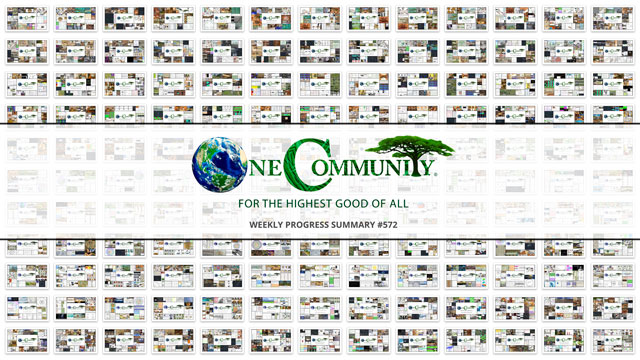
OUR MAIN OPEN SOURCE HUBS
Click on each icon to be taken to the corresponding Highest Good hub page.
One Community’s physical location will forward this movement as the first of many self-replicating teacher/demonstration communities, villages, and cities to be built around the world to teach and expand sustainable systems management. This is the March 4th, 2024 edition (#572) of our weekly progress update detailing our team’s development and accomplishments:
Sustainable Systems Management
One Community Progress Update #572
DONATE | COLLABORATE | HELP WITH LARGE-SCALE FUNDING
CLICK HERE IF YOU’D LIKE TO RECEIVE AN EMAIL EACH WEEK WHEN WE RELEASE A NEW UPDATE
YOU CAN ALSO JOIN US THROUGH SOCIAL MEDIA
ONE COMMUNITY WEEKLY UPDATE DETAILS
HIGHEST GOOD HOUSING PROGRESS
 One Community is developing sustainable systems management through Highest Good housing that is artistic and beautiful, more affordable, more space efficient, lasts longer, DIY buildable, and constructed with healthy and sustainable materials:
One Community is developing sustainable systems management through Highest Good housing that is artistic and beautiful, more affordable, more space efficient, lasts longer, DIY buildable, and constructed with healthy and sustainable materials:
-
-
- Learn about: Our Upcoming Crowdfunding Campaign
- Learn about sustainable systems management and the different village models: 7 Sustainable Village Models
- Visit the open source portals for the details of sustainable systems management for the first two: Earthbag Village OS Hub | Straw Bale Village OS Hub
-
This week, Vidhi Bansal (3D Visualization Artist) completed another week of assisting with the visualization and 4-dome cluster variation renders for the Earthbag Village. She focused on checking and properly scaling the people and vehicle. See below for some of the pictures.
Loza Ayehutsega (Civil Engineer/Assistant Civil Engineer), completed another week working on the Earth Dam risk assessment and dam break hazard assessment. She edited the report document and reviewed the part that was not completed, and the post-event recovery part is now added to the report document. Post-event recovery is a critical phase in disaster risk mitigation to restore affected communities, infrastructure, and ecosystems to pre-disaster conditions or better. Some of the examples are Assessment and Evaluation, Emergency Relief, Restoration of Basic Services, Reconstruction and Rehabilitation, Livelihood Recovery, Environmental Restoration, Policy and Institutional Reforms. Sustainable systems management of earthworks dams is a part of One Community’s open source creation process. See below for some of the pictures.
DUPLICABLE CITY CENTER PROGRESS
 One Community is developing sustainable systems management through a Duplicable and Sustainable City Center that is LEED Platinum certified/Sustainable, can feed 200 people at a time, provide laundry for over 300 people, is beautiful, spacious, and saves resources, money, and space:
One Community is developing sustainable systems management through a Duplicable and Sustainable City Center that is LEED Platinum certified/Sustainable, can feed 200 people at a time, provide laundry for over 300 people, is beautiful, spacious, and saves resources, money, and space:
-
-
- Learn about this building and its function as a component of our sustainable systems management for food, laundry, recreation and more: Duplicable City Center Open Source Hub
-
This week, Amiti Singh (Volunteer Architectural Designer) focused on finalizing all the files for the rooms she designed in Duplicable City Center. She reviewed material rates, product specifications, and updated product cataloging for the cost-analysis of all the rooms. She also updated Google Slides and DWG drawings for Room 7 and finalized changes in renders for the specified rooms. The Duplicable City Center will be a significant contributor to sustainable systems management for food, laundry, recreation and more. The collage below shows her work for the week.
Clarice Gaw Gonzalo (Architect) continued her work developing renders and the video walkthrough for the Duplicable City Center. She concentrated on refining lighting arrangements, incorporating people, and introducing clutter to enhance realism. She also adorned beds with clothing and populated spaces with diverse groups of interacting individuals. During the rendering process, Clarice experimented with various sun settings to optimize the entrance of light into each space. She then started the task of revising previous renders, identifying discrepancies within the original SketchUp models that necessitate further revision and time investment. The Duplicable City Center will be a significant contributor to sustainable systems management for food, laundry, recreation and more. Below are some demonstration images of her work.
Julio Marín Bustillos (Mechanical Engineer) focused on Finite Element Analysis (FEA) on the dome with the hub connector. However, due to the extensive size and complexity of the analysis, it demanded considerable effort. Consequently, he has begun researching alternative methods to streamline the analysis process and reduce the computational resources required. Replicable recreation, education, dining, and gathering spaces such as the Duplicable City Center are a big part of One Community’s sustainable systems management model. See the collage below for his work.
Justin Varghese (Mechanical Engineer) concluded his tasks by organizing all files related to City Center Hub Connector into categories such as CAD, FEA, and RSA, and uploading all relevant documents to Dropbox. He also included notes, links, and pictures to facilitate easy identification of the files. Additionally, Justin prepared a work breakdown structure (WBS) outlining pending tasks within the project. The Duplicable City Center will be a significant contributor to sustainable systems management for food, laundry, recreation and more. The collage below shows his work for the week.
HIGHEST GOOD FOOD PROGRESS
 One Community is developing sustainable systems management through Highest Good food that is more diverse, more nutritious, locally grown and sustainable, and part of our open source botanical garden model to support and share bio-diversity:
One Community is developing sustainable systems management through Highest Good food that is more diverse, more nutritious, locally grown and sustainable, and part of our open source botanical garden model to support and share bio-diversity:
-
-
- Learn about the sustainable systems management for these structures: Hoop House Hub | Aquapini & Walipini Open Source Hub
- See what we’ll be growing: Gardens & Hoop Houses | Large-scale Structures | Food Forest | TA
-
This week, a core team member made progress on the Highest Good Food Tools and Equipment document by incorporating and expanding the list by adding new power equipment entries, created detailed descriptions for each item, and ensured alphabetical order for easy reference. They reorganized the list by grouping similar tools and equipment together, further enhancing its user-friendliness. They also collaborated with team to discuss the alphabetization process for various tools, equipment, and materials lists. Sustainable systems management of food is a significant part of One Community’s open source plans. See their work in the collage below.
Charles Gooley (Web Designer) focused on the development of the Vegan Rice Recipes page, constructing several recipes including Healthy Braised Lentils with Kale, Yukon Gold Mashed Potatoes and Roasted Shallots with Beef Goulash, Brown Rice and Beef Curry, Vegan Lentil Chili, Potatoes Dauphinoise and Poached Asparagus, Leeks and Peas, Tempeh & Sweet Potato Buddha Bowl, Breakfast Wrap, Baked Brown Rice and Minced Beef with Sweet Potato Stew, Orzo Pasta and Black Bean Salad with Roasted Cauliflower, Chard and Herbs, Curried Tempeh Quinoa Breakfast Hash, Pesto Pasta with Grilled Chicken, Cherry Tomatoes and Arugula, Omelet Wraps, Adzuki Rice and Bean Bowls, and Sweet Potato & Peanut Curry. Placeholder images were utilized and are to be replaced with final images upon availability. Diverse food menus are a significant part of how One Community is designed for sustainable systems management of what we eat. See his work in the collage below.
Hayley Rosario (Sustainability Research Assistant) organized tools, equipment, and materials for the Highest Good Food project. During a collaborative session with a core team member, it was noted that a substantial portion of the items required grouping within the list. Responding to this insight, she revised the original list in the Highest Good Food Tools & Equipment document. Hayley initiated corresponding adjustments to the images and descriptions list. A need for a clear distinction between accessories and non-accessories prompted her to recreate the list in a separate document. Sustainable systems management of food is a significant part of One Community’s open source plans. See below for pictures related to her work.
HIGHEST GOOD EDUCATION PROGRESS
 One Community is developing sustainable systems management through Highest Good education that is for all ages, applicable in any environment, adaptable to individual needs, far exceeds traditional education standards, and more fun for both the teachers and the students. This component of One Community is about 95% complete with only the Open Source School Licensing and Ultimate Classroom construction and assembly details remaining to be finished. We’ll report on the final two elements to be finished as we develop them.
One Community is developing sustainable systems management through Highest Good education that is for all ages, applicable in any environment, adaptable to individual needs, far exceeds traditional education standards, and more fun for both the teachers and the students. This component of One Community is about 95% complete with only the Open Source School Licensing and Ultimate Classroom construction and assembly details remaining to be finished. We’ll report on the final two elements to be finished as we develop them.
With over 8 years of work invested in the process, the sections below are all complete until we move onto the property and continue the development and open sourcing process with teachers and students – a development process that is built directly into the structure of the education program and everything else we’re creating too:
- Sustainable systems management education overview: Education Open Source Hub
- Sustainable systems management: How to use the Education for Life Program
- Sustainable systems management: Lesson Plans for Life – Lesson Plans How-to
- Foundations of Outstanding Leaders, Teachers, and Communicators
- Curriculum for Life
- Teaching Strategies for Life
- Learning Tools and Toys for Life
- Evaluation and Evolution

Highest Good Education: All Subjects | All Learning Levels | Any Age – Click image for the open source hub
HIGHEST GOOD SOCIETY PROGRESS
 One Community is developing sustainable systems management through a Highest Good society approach to living that is founded on fulfilled living, the study of meeting human needs, Community, and making a difference in the world:
One Community is developing sustainable systems management through a Highest Good society approach to living that is founded on fulfilled living, the study of meeting human needs, Community, and making a difference in the world:
-
-
- Read the Highest Good society sustainable systems management overview: Highest Good Society
- Learn about the model for fulfilled living and sharing: A Day in the Life
- Learn about sustainable systems management with the 4 economic models: RBE | For-profit | Non-profit | Entrepreneurship
- Learn about our open source community sustainable systems management and collaboration software: The Highest Good Network
-
This week, the core team completed 57 hours managing One Community volunteer-work review not included above, emails, social media accounts, web development, new bug identification and bug-fix integration for the Highest Good Network software, and interviewing and getting set up new volunteer team members. We also shot and incorporated the video above that talks about sustainable systems management and how sustainable systems management is a foundation of the bigger picture of everything One Community is doing. The pictures below show some of this work. See below for pictures related to this.
Another core team member worked on the Highest Good Network, confirming and fixing PRs. The Highest Good Network software is how we’ll be managing and objectively measuring our process for sustainable systems management through our social architecture, construction, production, and maintenance processes. This week’s work included resolving the issue of moving time entries to another task (#486) and fixing the button placement problem in PR1775. However, several PRs remained unresolved, such as fixing minor formatting issues on the Dashboard and Profile Pages (PR1958), where the “Click for user class information” mouseover text still persists. Issues were discovered with an updated pop-up window for time off requests, including problems with changing dates and the inability to request time off for weeks before the current date. Other unresolved PRs involved updating People Reports and fixing the New Max Personal Record award. Alongside PR testing, They reported new issues, including references to deleted accounts within the application and incorrect working week dates. They checked the status of tested PRs and resolved all remaining issues in the “Murphy Bed Instructions” PDF file. See below for pictures related to their work.
Aaron Wang (Fundraising Assistant) continued to help One Community with working on fundraising. Demonstrating our systems of sustainable systems management requires we get fully funded. Aaron focused on refining his research regarding the connections and narratives behind each fund associated with Leonardo DiCaprio. He identified email contacts of individuals likely to have insights into Leonardo’s philanthropic endeavors, aiming to enhance the process of connecting with funders. You can view this work in the collage below.
Cody Media Productions (Video Editing Company) focused on refining the intro video for the weekly progress update YouTube videos and incorporating feedback from the previous rough cut. They continued their efforts on the intro video. Cody Media Productions reviewed the feedback from the previous rough cut and made the necessary adjustments. Additionally, they focused on incorporating titles and transitions into the video to enhance its visual appeal and coherence. Their agenda includes submitting a third rough edit video, marking significant progress toward the project’s completion. These videos will showcase the open-source components of One Community as the prototype for sustainable systems management. You can view this work in the collage below.
Jayson Conty (Video Editor) continued to help with working on video editing. He updated the weekly update video by incorporating a call to action to follow One Community on their social media platforms. Additionally, he replaced all low-resolution images with their higher-quality counterparts, introduced a housing overview segment at the outset of the video, and rectified minor spelling errors. These videos showcase the details of the components of our complete model for sustainable systems management. See the collage image below.
Ray Lee (Graphic Designer, Video Editor) helped this week by creating first-draft images for updating our website header to celebrate and acknowledge Women’s History Month and National Volunteer Week at One Community. See the images below to view this work-in-progress. See the collage image below.
ADMINISTRATION TEAM
The Administration Team’s summary, covering their work administrating and managing most of One Community’s ongoing sustainable systems management process was managed by Vriddhi Misra (Admin and Marketing Assistant) and includes Alyx Parr (Senior Support Specialist), Camilla Okello (Administrative Assistant), Catherine Liu (Administrative and Analytics Assistant, Team Manager), Meenakshi Velayutham (Sustainability Associate), Olawunmi “Ola” Ijisesan (Administrative and Management Support), Olivia Trojnar (Administrative Assistant), Purva Nantarajesh (Marketing Analyst), Ruiqi Liu (Administrative Assistant), and Xiaolai Li (Administrative Assistant). This week, Alyx streamlined the process of managing One Community MP3 files downloaded from YouTube, ensuring organization and clarity by renaming the files appropriately for easy identification. She also reset ‘Step 4′ for other team members. Camilla focused on optimizing her assigned blogs, addressing challenges with Jae’s assistance, particularly the double-posting issue, and resolving challenges on sites with previously used focus keywords. Catherine reviewed various teams and individual team members, organizing images and summaries and finalizing edits on texts and blog posts while researching keywords for a Google Ads campaign. Meenakshi continued administrative tasks, including checking the weekly summary page, tracking and creating bio announcements, reviewing cost analysis details, and proofreading social media web images. Ola focused on reviewing the PR Team’s work, optimizing SEO scores, managing weekly tasks, and creating folders for administrative team members. Olivia completed training for her Administrative Assistant role and initiated research on sustainable lighting options. Purva spent time creating collages, proofreading summaries, reviewing other administrators’ work, and optimizing previous blog posts for SEO. Ruiqi completed the four-step review process for multiple teams, created collage images, integrated SEO keywords into WordPress, refined and organized data, and adjusted quantities in various tables. Vriddhi focused on administration tasks related to the Duplicate City Center project, finalizing reports and weekly summaries, suggesting team changes, addressing reviewer feedback, and actively engaging in tutorials and feedback sessions to optimize SEO on blogs and improve page visibility. Xiaolai undertook tasks such as editing summaries, arranging documents and images, completing the 571 weekly reports, updating the report’s webpage, creating an administrator tutorial, and ensuring the financial sheet was updated and submitted for final review. You can see the work for the team in the image below.
ALPHA SOFTWARE DEVELOPMENT TEAM
The Alpha Team’s summary, covering their work on the Highest Good Network software, was managed by Sucheta Mukherjee (Software Developer) and includes Chengyan Wang (Software Engineer) and Yongjian Pan (Software Engineer). The Highest Good Network software is how we’ll be managing and objectively measuring our process for sustainable systems management through our social architecture, construction, production, and maintenance processes. This week, Sucheta focused on creating a revised pull request (PR2006+775) for the task ‘Create Summary Report Recipient Button.’ This involved creating a new branch from the development branch, copying code from the previous PR, and testing frontend functionality. However, there were issues sending emails from the backend server, leading to an examination of Google API credentials and attempts to create new access codes. The PR is submitted but awaiting review from an experienced member. PRs 1931 and 1985 were also reviewed during this time. Additionally, Chengyan saw advancements in the HGN Software Development project. A reusable React component, ListView, was developed to create list views with specific keywords and Redux actions. Challenges included a recursive Redux action that disrupted sorting logic, which was resolved to enhance component reusability. The week included final PR reviews, integration of a reusable list UI component, front-end improvements for ‘Add Reusable (Type),’ and collaboration with the backend team for unit parsing filtering. Testing and feedback gathering refined the Redux workflow and front-end improvements. PR #1956 issues were addressed, including a blank screen fix and sorting/filtering functionalities. Backend and branch updates were implemented to maintain project momentum and feature integration. Yongjian worked on a filter for a task, allowing administrators and owners to filter their teams’ specific data, including names, tangible time, progress, and total time for the current week’s progress work. See the Highest Good Society and Highest Good Network pages for more on how this relates to sustainable systems management. View some of the team’s work in the collage below.
BADGES BUGS SOFTWARE DEVELOPMENT TEAM
The Badges Bugs Team’s summary, covering their work on the Highest Good Network software, was managed by Shaofeng Li (Software Engineer) and includes Renan Luiz Santiago Martins César (Full-stack developer) and Xiao Zhang (Software Engineer). The Highest Good Network software is how we’ll be managing and objectively measuring our process for sustainable systems management through our social architecture, construction, production, and maintenance processes. This week, Shaofeng addressed a critical issue in the HGN Software Development project concerning the ’90 hours in one-week’ badge not being awarded correctly. He began by setting up a testing and debugging environment, including creating a video tutorial on using Postman for authorization and working closely with a colleague to obtain JWT tokens for testing. Shaofeng also assisted in onboarding teammates for badge testing, participated in a team meeting to discuss goals and task approaches, and made debugging efforts. By the week’s end, after another productive meeting to address code and git issues, he debugged the function and implemented a new method for awarding badges, significantly contributing to the project’s advancement. Xiao concentrated on enhancing the project’s efficiency and clarity by developing a function to manage the assignment of X hours within a single week, aiming to improve the codebase’s organization and readability. Meanwhile, Renan spent the week on professional development and project tasks, including watching a video on back-end testing techniques, learning new bug testing methods, and resolving issues causing a white screen in the HGN app. He verified logs in Azure, continued implementing disaster recovery measures within the Azure framework, made progress on bug fixes, and tackled task-related problems to smooth the coding process, making strides in adding new features to their project branch. See the Highest Good Society and Highest Good Network pages for more on how this relates to sustainable systems management. Look below for pictures of the team’s work.
BLUE STEEL SOFTWARE DEVELOPMENT TEAM
The Blue Steel Team’s summary, covering their work on the Highest Good Network software, was managed by Nathan Hoffman (Software Engineer, Team Manager) and includes Jingyi Jia (Software Engineer), Tzu Ning “Leo” Chueh (Software Engineer), Swathy Jayaseelan (Software Engineer), and Xiao Wang (Software Engineer). The Highest Good Network software is how we’ll be managing and objectively measuring our process for sustainable systems management through our social architecture, construction, production, and maintenance processes. This week, Nathan completed a review of the permissions spreadsheet, addressing identified issues and enhancing accuracy. He provided valuable support to Jay in resolving build errors, ensuring seamless development progress. Additionally, Nathan validated permission functionality based on the spreadsheet, implementing essential changes. Through revisiting Jay’s pull requests, he requested necessary modifications and added a task to the bugs document regarding permission checks for User Management buttons. In parallel, he investigated Trello pricing, suggesting its consideration for efficient organization of the Bugs Doc due to its free tier offering unlimited users and tasks. Furthermore, he spent time to reviewing the team’s summaries and providing constructive feedback on pull requests. Jingyi made progress on the “Add Rehireable/Not Rehireable box to Profile page” task, focusing on both frontend and backend components. On the front end, Jingyi introduced a checkbox adjacent to the “active” icon to toggle the rehireable status, with a confirmation popup ensuring user intent. In the backend, modifications were made to the model schema to default the “isRehireable” status to true, with new endpoints and a controller function seamlessly integrating this feature. Swathy focused on understanding the project and worked on unit testing for the People Table Component within the Reports section, ensuring the correct display and functionality of key features. Swathy focused on understanding the project and testing the People Table Component, creating comprehensive test cases to verify various functionalities. Tzu Ning examined network requests, enhanced error handling, and scrutinized authentication roles and rendering logic for a seamless user experience. Lastly, Xiao Wang significantly contributed through pull requests, enhancing the application’s reliability and user experience with features like heartbeat support (PR #1995) and a stable web socket connection (PR #768). He addressed text format issues, visibility toggles, and privacy improvements in subsequent PRs, demonstrating a commitment to both functionality and security. See the Highest Good Society and Highest Good Network pages for more on how this relates to sustainable systems management. The collage below shows some of this work.
CODECRAFTERS SOFTWARE DEVELOPMENT TEAM
The Code Crafters Team’s summary, covering their work on the Highest Good Network software, was managed by Anirudh Ghildiyal (Software Engineer) and includes Anirudh Dutt (Software Developer), Nahiyan Ahmed (Full Stack Software Developer), Ramya Ramasamy (Software Engineer), Shantanu Kumar (Software Developer) and Tapan Pathak (Software Engineer). The Highest Good Network software is how we’ll be managing and objectively measuring our process for sustainable systems management through our social architecture, construction, production, and maintenance processes. Anirudh D completed the implementation of displaying the count of the final days on the leaderboard, receiving approval comments on his PRs. Additionally, he created a utility function for his previous PR to get the initials. Nahiyan addressed optimization needs for the project report page by documenting a new issue and proposed a solution to reduce backend requests during initialization, publishing Pull Request 2013, and resolving issues on previous Pull Requests, numbered 1987 and 1931. Tapan completed task 667, addressing the issue of “Fix Badge Assignment not assigning badges correctly,” and began rectifying the problem of “Creating a new role without required roleName and permissions not handled gracefully in UI.” Shantanu resolved a merge conflict related to his previous efforts in optimizing the submit button’s efficiency, providing support for Masasa in handling the scroll issue_II. Ramya focused on addressing bug 1905, wrapping up the unit test case of BioFunction, reviewing and managing the final reviews for 6 pull requests and 2 additional regular reviews, as well as updating a unit test case of another author who has left the team. Anirudh G reviewed tasks sent for review by teammates Shantanu, Sophie, Ramya, and Nahiyan, providing positive feedback on the work done and updating teammates about the task review process. He ensured all test cases passed for a particular component and prepared to raise a PR, finalized a set of unit test cases for another component, and continued writing final edge cases for yet another component. Additionally, he worked on writing unit test cases for the UserTeamProjectContainer component and participated in the weekly standup meeting, facilitating follow-ups with teammates on their weekly work progress. See the Highest Good Society and Highest Good Network pages for more on how this relates to sustainable systems management. The collage below shows some of this work.
EXPRESSERS SOFTWARE DEVELOPMENT TEAM
The Expressers Team’s summary, covering their work on the Highest Good Network software, was managed by Demi Zayas (Full Stack Software Engineer) and includes Aishwarya Kalkundrikar (Full Stack Software Developer), Christy Guo (Software Engineer), Ilya Flaks (Software Engineer), Kevin Hinh (Software Engineer), Mohammad Abbas (Software Engineer), and Tareq Mia (Software Engineer). The Highest Good Network software is how we’ll be managing and objectively measuring our process for sustainable systems management through our social architecture, construction, production, and maintenance processes. Kevin focused on refining the BMdashboard timelog component, resolving a critical issue related to its functionality where the timer would cease to count when users minimized their browser or switched tabs. He identified the use of WebSockets in the existing timelog component, refactored his code, and established communication with the backend. Tareq helped with this sustainable systems management software as he reviewed and enhanced the map feature, documenting potential improvements, and reviewing a related pull request. He progressed to implementing the Reusables Single Update feature, completing frontend tasks, and transitioning to backend development. Christy focused on researching the integration of a D3 bar chart into the project’s reporting page and working on the frontend purchase form and backend routing components for the “Purchase Equipment” feature. Ilya finalized the “Consumables: Update Single” task, ensuring seamless integration with the existing system and addressing code quality with ESLint. He addressed a bug in another developer’s pull request. Aishwarya resolved an issue related to the failure to update existing records after submitting the purchase consumable form, attributing it to misconfigured mongoose/database settings. Mohammad helped with this sustainable systems management software as he focused on addressing a specific bug related to middle name querying functionality in the project’s member search bar, aiming to enable owners to search for a user using only their middle name. Demi focused on the 4.1.1 Tools List Default view, investing a significant amount of time in addressing a persistent bug affecting her progress. Demi also reviewed her teammates’ videos and code towards the end of the week, staying responsive to their requests throughout the workweek. See the Highest Good Society and Highest Good Network pages for more on how this relates to sustainable systems management. The collage below shows some of this work.
GIT-R-DONE SOFTWARE DEVELOPMENT TEAM
The Git-R-Done Team’s summary, covering their work on the Highest Good Network software, was managed by Sai Deepak Dogiparthi (Software Developer) and includes Chris Chen (Software Engineer Intern), Miguelcloid Reniva (Software Developer), Nidhi Galgali (Software Developer), Rhea Wu (Software Engineer) and Shuhua Liu (Full-Stack Developer). The Highest Good Network software is how we’ll be managing and objectively measuring our process for sustainable systems management through our social architecture, construction, production, and maintenance processes. Deepak focused on reviewing comments posted on the pull requests raised last week, with particular attention given to PRs 1976 and 1986. Following this, he developed a new functionality for the equipment details page in the frontend. Miguel focused on the implementation of the dropdown menu box, encountering challenges regarding sizing across different screen sizes. He found a more effective approach to ensure consistency. Additionally, he resolved styling discrepancies between columns and adjusted spacing between the cancel and submit buttons to enhance user experience. Rhea helped with this sustainable systems management software as she advanced the latest pull request related to the tasks: Phase 2 – 7.2.1 Issue Schema and 7.1.2 New Issue Routing. Shuhua focused on addressing the issue of processing Core Team members’ additional hours, particularly when more than five infringements were assigned. Nidhi gained proficiency in utilizing mock data for unit tests and addressed an error encountered in the test cases. She resolved the issue with the test cases, which included verifying the presence of the header in the BMDashboard, ensuring the proper functionality of the Dropdown component, validating the display of an error message for the ‘Go to Project Dashboard’ button when no project is selected, and confirming the accurate presentation of the designated number of project summaries on the BMDashboard. See the Highest Good Society and Highest Good Network pages for more on how this relates to sustainable systems management. The collage below shows some of this work.
GRAPHIC DESIGN TEAM
The Graphic Design Team’s summary was managed by Ruiqi Liu (Administrative Assistant) and includes Ashlesha Navale (Graphic Designer) and Nancy Mónchez (Graphic Designer). Ashlesha created a Volunteer Announcement, developing the bio image and announcement image, while also updating web content for two volunteer announcements. Additionally, she produced five impactful Social Media Images and curated a collection of nature-based and theme-based background images for further content creation. Nancy contributed to the redesign of social network images to enhance visual appeal. She exhibited data organization skills while managing an Excel list and produced two high-quality biographies for the website. She also reviewed and implemented edits and corrections on images from weeks 16 and 17. See the Highest Good Society pages for more on how this relates to sustainable systems management. The collage below shows some of this work.
MOONFALL’S SOFTWARE DEVELOPMENT TEAM
Moonfall Team’s summary, covering their work on the Highest Good Network software, was managed by Lu Wang (Software Engineer) and includes Abdelmounaim “Abdel” Lallouache (Software Developer), Cheng-Yun Chuang (Software Engineer), Haoji Bian (Software Engineer), Jiadong Zhang (Software Engineer) and Zubing Guo (Software Engineer). The Highest Good Network software is how we’ll be managing and objectively measuring our process for sustainable systems management through our social architecture, construction, production, and maintenance processes. Abdelmounaim completed the development of the new blue square scheduler, updated various dashboard modals, and resolved related issues while testing the changes. Cheng-Yun focused on implementing sorting buttons for recent edit projects, investigating code structure and sorting functionality across front-end and back-end repositories. Haoji made changes to the communication workflow within our platform. The email notification system was refined by removing certain reminders and introducing a prominent banner notification, urging users to select a profile picture from multiple options found on the website. Jiadong helped with this sustainable systems management software as he worked on updating the dashboard by replacing badges, enhancing backend functionality, and ensuring the accurate increment of badge counts for users, significantly improving the dashboard’s reliability. Lu focused on debugging and enhancing test coverage for critical components within the application, addressing various issues and developing test cases. Zubing wrapped up her work for ChatGPT integration, writing and recording to explain the issue encountered. See the Highest Good Society and Highest Good Network pages for more on how this relates to sustainable systems management. Look below for a collage of their work.
REACTONAUTS’ SOFTWARE DEVELOPMENT TEAM
Reactonauts’ Team’s summary, covering their work on the Highest Good Network software, was managed by Masasa Thapelo (Software Engineer) and includes Changhao Li (Software Engineer), Peterson Rodrigues (Full-Stack MERN Stack Developer), Shengwei Peng (Software Engineer), Shiwani Rajagopalan (Software Engineer) and Vikram Badhan (Software Engineer). The Highest Good Network software is how we’ll be managing and objectively measuring our process for sustainable systems management through our social architecture, construction, production, and maintenance processes. Changhao worked on unit test development for the TimeEntryForm, addressing async issues and network errors, and attended the weekly team meeting. Peterson identified and resolved a bug in the ‘HGN Phase I Bugs and Needed Functionalities’ document, specifically addressing issues with the ‘Tasks and Timelogs’ card on the Dashboard. Shengwei helped with this sustainable systems management software as he completed development tasks, creating pull requests for ‘Jae’s account only editable by Jae’s related account – enhancement’ and ‘Finish NEW USER function, stop blue square from being added.’ He also enhanced features with detailed messages for invalid tokens. Shiwani focused on two tasks, continuing the UserPermissionsPopup unit test and creating five test cases for the RolePermissions component. Vikram focused on unit testing for WeeklySummaryOptions.jsx and ToggleSwitchContainer.jsx files, collaborating with the team to enhance overall performance and stability while discussing strategies for improving test coverage and testing procedures. See the Highest Good Society and Highest Good Network pages for more on how this relates to sustainable systems management. Look below for pictures of this work.
SKYE’S SOFTWARE DEVELOPMENT TEAM
Skye’s summary, covering their work on the Highest Good Network software, was managed by Luis Arevalo (Front End Developer) and includes Jerry Ren (Full Stack Developer), John Mumbi (Developer), Roberto Contreras (Software Developer), Yao Wang (Software Engineer) and Zuhang Xu (Software Engineer). The Highest Good Network software is how we’ll be managing and objectively measuring our process for sustainable systems management through our social architecture, construction, production, and maintenance processes. Jerry engaged in various tasks including studying Redux component testing philosophy, identifying a bug in the NewRolePopUp component, and responding to comments on BE PR 665. He closed irrelevant FE PRs and continued working on the X-hours in X-weeks streak fix task. John enhanced the efficiency of the weekly reports page by completing tests to evaluate newly implemented functions, performing code cleanup, and establishing a tracking table for transparency. He also completed a follow-up on pull request 1908, enabling tracking of individuals with zero weekly hours for reporting purposes. Luis focused on implementing the drag and drop function for warning descriptions, demonstrating an example on a separate codebase before realizing it should be on a separate branch in the HGN codebase. Roberto addressed an open pull request concerning duplicate badge functionality, identified issues with frontend modifications causing discrepancies in badge counts, and collaborated with Luis on enhancing the warnings component. Yao focused on reviewing comments on PR 1895, testing bugs, and exploring new tasks. He also contributed to designing a new logic for detecting color status changes and worked on test PRs. Zuhang submitted PRs 1896 and 1940 for review, both of which were checked and merged with the latest development branch. See the Highest Good Society and Highest Good Network pages for more on how this relates to sustainable systems management. See the collage below for some of their work.
SOFTWARE PR REVIEW TEAM
The PR Review Team’s summary covering their work on the Highest Good Network software was managed by Olawunmi Ijisesan (Administrative and Management Support). The Highest Good Network software is a foundation of what we’ll be using to measure our results of sustainable systems management. This week’s active members of this team were: Aaron Persaud (Software Developer), Alex Brandt (Full Stack Developer), Bhuvan Dama (Full stack Developer), Carl Bebli (Software Developer), Clemar Nunes (Web Developer), Dhairya Mehta (Software Engineer), Diego Salas (Software Engineer), Gabriele Canova (Frontend Developer), KaiKane Lacno (Software Developer and Team Manager), Kurtis Ivey (Software Engineer), Malav Patel (Software developer), Meet Padhiar (Software Engineer), Navya Madiraju (Full Stack Developer), Nnamdi Ikenna-Obi (Software Engineer), Olga Yudkin (Software Engineer), Pratima Singh (Software Developer), Priyanka Sharma (Software Engineer), Raj Nada (Software Developer), Sarthak Jaiswal (Full stack Developer), Shengjie Mao (Software Engineer), Summit Kaushal (Backend Software Developer), Tim Kent (Full Stack Software Engineer), Wei-Hou Huang (Software Engineer), Xiaohan Meng (Software Engineer), Yaohong Xiang (Software Engineer), Yi Feng (Full-Stack Software Engineer), and Zijie “Cyril” Yu (Software Engineer). They reviewed all the Highest Good Network PRs (Pull Requests) shared in this week’s update. Learn more about how the Highest Good Network will measure and assist in sustainable systems management in the Highest Good Network open source hub. The collage below shows a compilation of the work from this team.
AND WE PRODUCED THIS WEEKLY UPDATES BLOG – CLICK HERE TO SUBSCRIBE
FOLLOW ONE COMMUNITY’S PROGRESS (click icons for our pages)
INVESTOR PAGES
GET INVOLVED
One Community Welcomes Ilya Flaks to the Software Development Team!
One Community welcomes Ilya Flaks to the Software Development Team as our newest Volunteer/Consultant!
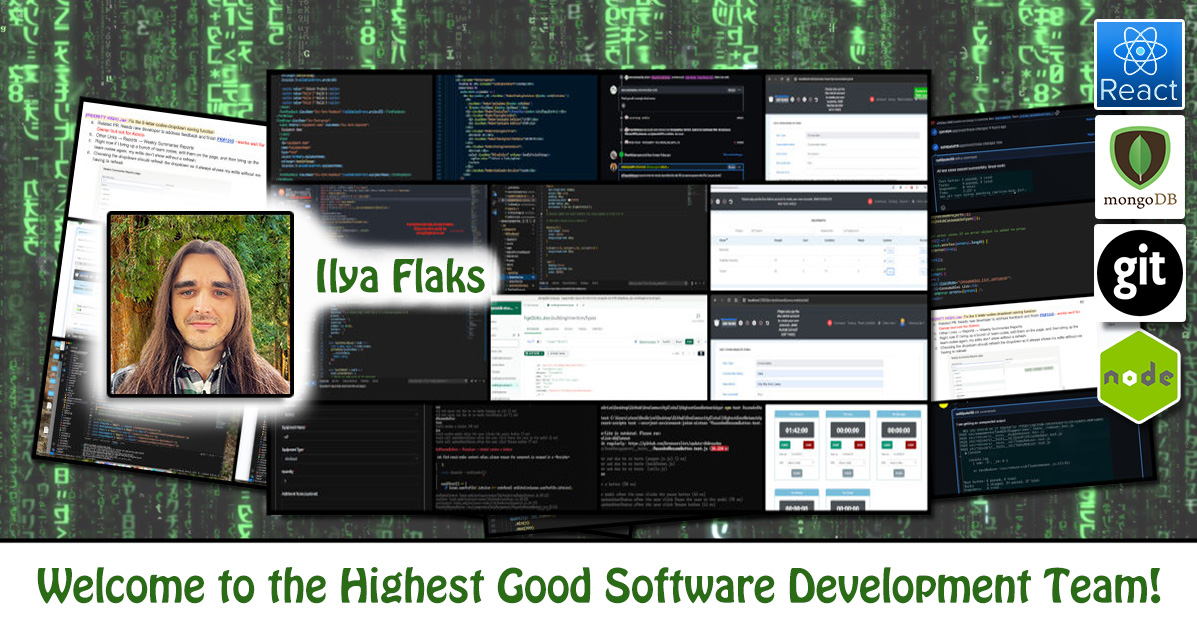
Although Ilya is relatively new to software engineering, he already has experience coding for non-profit organizations. He comes from a background of chemistry and biology and has worked as a flavor chemist in the food industry for over 10 years. He completed an MIT coding bootcamp in 2022 where he became proficient with the MERN stack. Ilya continued to learn on his own, mastering technologies such as GraphQL, MySQL, Next.js, Java Spring Boot, React Native and many more. Ilya is passionate about creating the best possible user experience and learning the latest technologies to achieve that goal. As a member of the One Community Highest Good Network software team, Ilya is working on adding new functionalities to the Building Management dashboard both on the back end and the front end and troubleshooting bugs in the existing codebase.
WELCOME TO THE TEAM ILYA!
FOLLOW ONE COMMUNITY’S PROGRESS (click icons for our pages)
INVESTOR PAGES
GET INVOLVED
One Community Welcomes Lu Wang to the Software Development Team!
One Community welcomes Lu Wang to the Software Development Team as our newest Volunteer/Consultant!

Lu is a software engineer specializing in PR reviews and test writing. With a keen eye for detail and a passion for quality assurance, Lu has made important contributions to the team’s codebase by reviewing and enhancing code quality through PR reviews. Additionally, Lu has played a key role in ensuring the reliability and functionality of the team’s software by writing comprehensive test suites. Lu’s dedication to ensuring the team’s code meets high standards of excellence has been instrumental in delivering robust and reliable code for the open source Highest Good Network software.
WELCOME TO THE TEAM LU!
FOLLOW ONE COMMUNITY’S PROGRESS (click icons for our pages)
INVESTOR PAGES
GET INVOLVED
One Community Welcomes Meenakshi Velayutham to the Administration Team!
One Community welcomes Meenakshi Velayutham to the Administration Team as our newest Volunteer/Consultant!
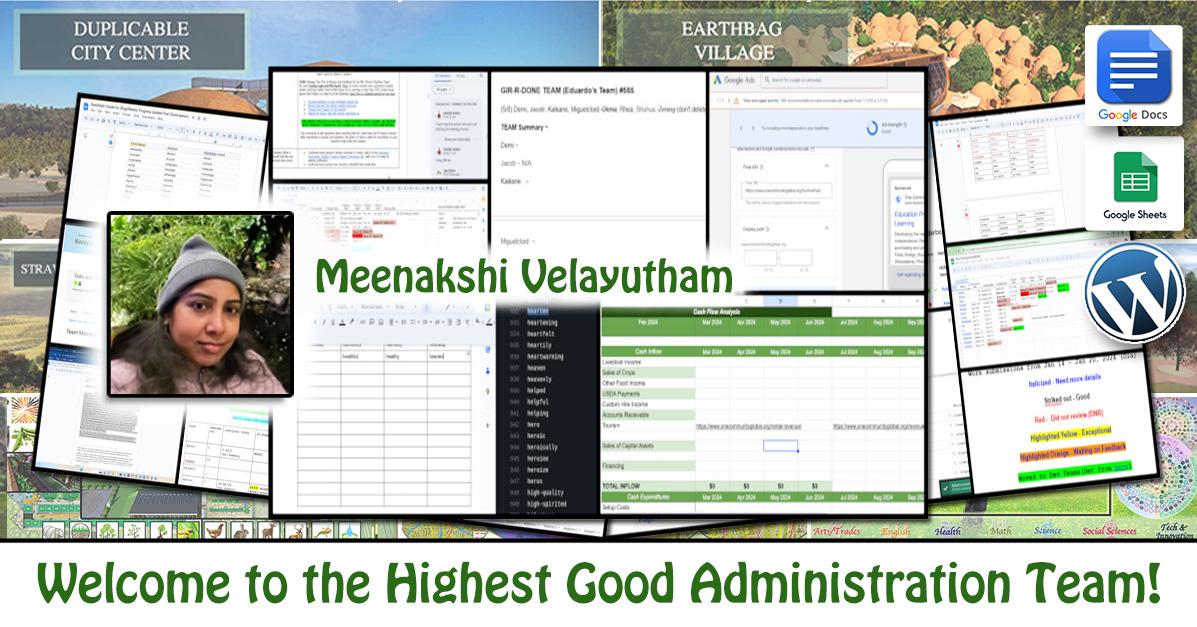
Meenakshi is an engineer with several years of professional experience in the Software Industry. She has also obtained a certification from UCSD in the areas of sustainable business practices. She brings a unique set of strong analytical, technical and purpose-driven skills, and has experience working in global, collaborative project teams. Meenakshi is passionate about sustainability and has worked on projects involving food security, packaging reduction and eco plastics, and carbon footprint reduction in communities. She also focused her studies on triple bottom line and B-Corp organizations that are involved with recycling and regeneration. She believes in efficiency with regards to use of resources, doing more with less, and contributing to sustainability with resources and infrastructure as a path to having both a positive impact on the environment and the economy. As a member of the One Community team, she is involved in supporting the core team with various workflow processes related to administration, web design and business plan cost analysis, and with review, analysis and content management of One Community’s various deliverables and publications.
WELCOME TO THE TEAM MEENAKSHI!
FOLLOW ONE COMMUNITY’S PROGRESS (click icons for our pages)
INVESTOR PAGES
GET INVOLVED
Holistic Community Creation – One Community Weekly Progress Update #571
At One Community, our all-volunteer team is committed to forwarding holistic community creation by integrating sustainable approaches to food, energy, housing, education, economics, and social architecture, all for “The Highest Good of All.” Our open-source, free-shared solutions aim to regenerate the planet, serving as a blueprint for global collaboration.
- Here’s our project overview
- Here’s our world-change methodology
- Here’s how this becomes self-replicating
- Here’s how we are open source and free-sharing all the do-it-yourself designs

OUR MAIN OPEN SOURCE HUBS
Click on each icon to be taken to the corresponding Highest Good hub page.
One Community’s physical location will forward this movement as the first of many self-replicating teacher/demonstration communities, villages, and cities to demonstrated holistic community creation around the world. This is the February 26th, 2024 edition (#571) of our weekly progress update detailing our team’s development and accomplishments:
Holistic Community Creation
One Community Progress Update #571
DONATE | COLLABORATE | HELP WITH LARGE-SCALE FUNDING
CLICK HERE IF YOU’D LIKE TO RECEIVE AN EMAIL EACH WEEK WHEN WE RELEASE A NEW UPDATE
YOU CAN ALSO JOIN US THROUGH SOCIAL MEDIA
ONE COMMUNITY WEEKLY UPDATE DETAILS
HIGHEST GOOD HOUSING PROGRESS
 One Community is forwarding holistic community creation through Highest Good housing that is artistic and beautiful, more affordable, more space efficient, lasts longer, DIY buildable, and constructed with healthy and sustainable materials:
One Community is forwarding holistic community creation through Highest Good housing that is artistic and beautiful, more affordable, more space efficient, lasts longer, DIY buildable, and constructed with healthy and sustainable materials:
-
-
- Learn about: Our “First Steps of Holistic Community Creation” Crowdfunding Campaign
- Learn about the different holistic community creation housing models: 7 Sustainable Village Models
- Visit the holistic community creation open source portals for the first two: Earthbag Village OS Hub | Straw Bale Village OS Hub
-
This week, Loza Ayehutsega (Civil Engineer/Assistant Civil Engineer) completed another week focused on reviewing and addressing requested changes and content additions related to Earth Dam risk assessment and dam break hazard assessment. This week’s focus was on post-event recovery and different types of dam failure. Earthworks are a big part of One Community’s holistic community creation model. You can see her work on dam assessment in the collage below.
Stacey Maillet (Graphic Designer) finished what looks like the final round or revisions to the the Earthbag Village (Pod 1) assembly instructions for the Murphy bed. This involved reviewing and integrating final feedback covering a few additions to the assembly process and changing some links. Sustainable and DIY replicable furniture is a big part of One Community’s holistic community creation model. See pics below.
DUPLICABLE CITY CENTER PROGRESS
 One Community is forwarding holistic community creation through a Duplicable and Sustainable City Center that is LEED Platinum certified/Sustainable, can feed 200 people at a time, provide laundry for over 300 people, is beautiful, spacious, and saves resources, money, and space:
One Community is forwarding holistic community creation through a Duplicable and Sustainable City Center that is LEED Platinum certified/Sustainable, can feed 200 people at a time, provide laundry for over 300 people, is beautiful, spacious, and saves resources, money, and space:
-
-
- Learn about this building and its function as part of holistic community creation: Duplicable City Center Open Source Hub
-
This week, Clarice Gaw Gonzalo (Architect) continued her work developing renders and the video walkthrough for the Duplicable City Center. She focused her efforts on the 4th-floor cupola, where she populated the space with a yoga instructor leading a class and integrated appropriate yoga equipment. In addition, she worked on the socialization and recreation loft, incorporating individuals engaging in interactive activities. She also enhanced an exterior view by introducing additional landscaping elements and vegetation for a more natural ambiance. Lastly, Clarice began rendering interior room designs, carefully incorporating people into scenes, and experimenting with lighting effects to achieve desired visual outcomes. Replicable recreation, education, dining, and gathering spaces as “Duplicable City Centers” are a big part of One Community’s holistic community creation model. You can see her renderings in the images below.
Justin Varghese (Mechanical Engineer) performed structural finite element analysis (FEA) of the City Center Hub Connector using Ansys software. Employing the software, he assessed the stress and deformation of the component under a 1000 lb load for materials hardwood and structural steel. The computed FEA model will serve as a basis for comparing other Hub Connector designs under similar loads, aiding in the selection of the optimal hub connector for the final design. Replicable recreation, education, dining, and gathering spaces as “Duplicable City Centers” are a big part of One Community’s holistic community creation model. The collage below shows his work for the week.
Julio Marín Bustillos (Mechanical Engineer) examined previous hub connector designs sourced from the website. He evaluated each design, noting its intricacies and nuances. Following this analysis, he augmented the existing information with a succinct yet informative description of the current design. In this description, he elaborated on the advantages inherent in the new design, elucidating its unique features and highlighting what distinguishes it from its predecessors. He underscored the potential performance enhancements expected from the new design iteration. However, Julio and his team acknowledge that further analysis is imperative to substantiate these expectations. Replicable recreation, education, dining, and gathering spaces as “Duplicable City Centers” are a big part of One Community’s holistic community creation model. The collage below shows his work for the week.
HIGHEST GOOD FOOD PROGRESS
 One Community is forwarding holistic community creation through Highest Good food that is more diverse, more nutritious, locally grown and sustainable, and part of our open source botanical garden model to support and share bio-diversity:
One Community is forwarding holistic community creation through Highest Good food that is more diverse, more nutritious, locally grown and sustainable, and part of our open source botanical garden model to support and share bio-diversity:
-
-
- Learn about the structures and how they relate to holistic community creation: Hoop House Hub | Aquapini & Walipini Open Source Hub
- See what we’ll be growing: Gardens & Hoop Houses | Large-scale Structures | Food Forest | TA
-
This last week, the core team made progress on the Highest Good Food Tools and Equipment document by incorporating additional power equipment, such as a tractor, skid steer, backhoe attachment, and other tools. They collaborated with the team to alphabetize the lists and categorize each item as either a tool, piece of equipment, or material. Food improvements are a significant part of how One Community is designed for holistic community creation. See their work in the collage below.
Charles Gooley (Web Designer) focused on the development of the Vegan Rice Recipes page, constructing several recipes including Healthy Vegan Gingerbread Quinoa Muffins, Cumin Brown Rice and Beef Curry with Kidney Bean Cucumber Salad, Italian-Style Roast Potato & Cabbage Wedges with Tomato & Lentils, Sweet Potato Apple and Noodle Breakfast Bake, Sweet n’ Spicy Rice and Chicken Bowls, Fusilli Pasta & Baked Chicken Thighs, Hearty Potato Breakfast Skillet, Lentil Sweet Potato Stew Teriyaki Beef and Vegetables with Brown Rice, Hash Brown Full Breakfast, Seasoned Rice, Sauteed Vegetables with Brown Sugar Roasted Ham, and Tuscan Spaghetti Squash and Pan Fried Tofu. Placeholder images were utilized until final images become available. Diverse food menus are a significant part of how One Community is designed for holistic community creation. See his work in the collage below.
Hayley Rosario (Sustainability Research Assistant) organized tools, equipment, and materials for the Highest Good Food project, arranging them in an initial list and subsequently alphabetizing both the list and corresponding images/descriptions. Additionally, she completed the task of incorporating resources not previously included in the EDITs document. In conclusion, Hayley identified and included relevant websites highlighting the benefits of school gardens at the end of the EDITs document. Food improvements are a significant part of how One Community is designed for holistic community creation. See below for pictures related to her work.
HIGHEST GOOD EDUCATION PROGRESS
 One Community is forwarding holistic community creation through Highest Good education that is for all ages, applicable in any environment, adaptable to individual needs, far exceeds traditional education standards, and more fun for both the teachers and the students. This component of One Community is about 95% complete with only the Open Source School Licensing and Ultimate Classroom construction and assembly details remaining to be finished. We’ll report on the final two elements to be finished as we develop them.
One Community is forwarding holistic community creation through Highest Good education that is for all ages, applicable in any environment, adaptable to individual needs, far exceeds traditional education standards, and more fun for both the teachers and the students. This component of One Community is about 95% complete with only the Open Source School Licensing and Ultimate Classroom construction and assembly details remaining to be finished. We’ll report on the final two elements to be finished as we develop them.
With over 8 years of work invested in the process, the sections below are all complete until we move onto the property and continue the development and open sourcing process with teachers and students – a development process that is built directly into the structure of the education program and everything else we’re creating too:
- Holistic community creation: Education Open Source Hub Overview
- How the components work together as part of holistic community creation: How to use the Education for Life Program
- Holistic community creation: Lesson Plans for Life – Lesson Plans How-to
- Holistic community creation: Foundations of Outstanding Leaders, Teachers, and Communicators
- Holistic community creation: Curriculum for Life
- Holistic community creation: Teaching Strategies for Life
- Holistic community creation: Learning Tools and Toys for Life
- Holistic community creation: Evaluation and Evolution

Highest Good Education: All Subjects | All Learning Levels | Any Age – Click image for the open source hub
HIGHEST GOOD SOCIETY PROGRESS
 One Community is forwarding holistic community creation through a Highest Good society approach to living that is founded on fulfilled living, the study of meeting human needs, Community, and making a difference in the world:
One Community is forwarding holistic community creation through a Highest Good society approach to living that is founded on fulfilled living, the study of meeting human needs, Community, and making a difference in the world:
-
-
- Read the Highest Good society overview: Highest Good Society
- Learn about the model for fulfilled living and sharing: A Day in the Life
- Learn about the 4 economic models: RBE | For-profit | Non-profit | Entrepreneurship
- Learn about our open source community collaboration and management software: The Highest Good Network
-
This week, the core team completed 57 hours managing One Community volunteer-work review not included above, emails, social media accounts, web development, new bug identification and bug-fix integration for the Highest Good Network software, and interviewing and getting set up new volunteer team members. We also shot and incorporated the video above that talks about holistic community creation and how holistic community creation is a foundation of the bigger picture of everything One Community is doing. The pictures below show some of this work. See below for pictures related to this.
Another core team member worked on Highest Good Network PRs testing, confirming fixed PRs, resolving the issue of moving time entries to another task (#486) and fixing the button placement problem in PR1775. However, several PRs remained unresolved, such as fixing minor formatting issues on the Dashboard and Profile Pages (PR1958), where the “Click for user class information” mouseover text still persists. Additionally, issues were discovered with an updated pop-up window for time off requests, including problems with changing dates and the inability to request time off for weeks before the current date. Other unresolved PRs involved updating People Reports and fixing the New Max Personal Record award. Alongside PR testing, they reported new issues, including references to deleted accounts within the application and incorrect working week dates. Furthermore, they checked the status of tested PRs and resolved all remaining issues in the “Murphy Bed Instructions” PDF file. The Highest Good Network software is how we’ll be managing and objectively measuring our process for holistic community creation through our social architecture, construction, production, and maintenance processes. DIY furniture, like the Murphy Bed designs, are a big part of One Community’s holistic community creation model too. See below for pictures related to their work.
Aaron Wang (Fundraising Assistant) continued to help One Community with working on fundraising. Holistic community creation requires we get fully funded. Aaron focused on refining his research regarding the connections and narratives behind each fund associated with Leonardo DiCaprio. He identified email contacts of individuals likely to have insights into Leonardo’s philanthropic endeavors, aiming to enhance the process of connecting with funders. You can view this work in the collage below.
Cody Media Productions (Video Editing Company) focused on refining the intro video for the weekly progress update YouTube videos and incorporating feedback from the previous rough cut. They continued their efforts on the intro video. Cody Media Productions reviewed the feedback from the previous rough cut and made the necessary adjustments. Additionally, they focused on incorporating titles and transitions into the video to enhance its visual appeal and coherence. Their agenda includes submitting a third rough edit video, marking significant progress toward the project’s completion. These videos will showcase the open-source components of One Community as the prototype for holistic community creation. You can view this work in the collage below.
ADMINISTRATION TEAM
The Administration Team’s summary, covering their work administrating and managing most of One Community’s ongoing holistic community creation process was managed by Catherine Liu (Administrative and Analytics Assistant, Team Manager) and includes Alyx Parr (Senior Support Specialist), Camilla Okello (Administrative Assistant), Olawunmi “Ola” Ijisesan (Administrative and Management Support), Olivia Trojnar (Administrative Assistant), Purva Nantarajesh (Marketing Analyst), Ruiqi Liu (Administrative Assistant), Vriddhi Misra (Admin and Marketing Assistant), and Xiaolai Li (Administrative Assistant). This week, Alyx sourced and downloaded several videos for Jae, while also crafting a bespoke video for Olivia’s appraisal and engaging in enriching activities to enhance blog content. She immersed herself in video content for inspiration, updated previous blog posts for relevancy, and expanded upon the Rank Math document to optimize the blog’s SEO performance. Alyx ensured the recognition and integration of team members’ contributions, such as Vrddhi, Catherine, and Richelle, into collective progress, while also converting select videos into MP3 format for Jae’s seamless access to preferred content. Camilla completed administrative tasks by updating her WordPress blog with recent content, and improving SEO scores for two blogs, “Facilitating the Evolution of Sustainability” and “Highest Good for All Progress”. Catherine reviewed various teams and individual members, organized images and summaries, and worked on blog post edits and the Keyword Campaign Structure page. Ola reviewed PR Review teams’ work, provided feedback, trained new volunteers, and organized workspace tasks, submitting weekly summaries and corresponding images. Olivia, in her first week as an Administrative Assistant, underwent training, reviewed weekly summaries, edited individual summaries, and learned to optimize group photos for blog posts. Purva focused on preparing her team’s summary and collages for the blog, doing SEO optimization on previous posts. Ruiqi completed the review process for multiple teams, created collage images, utilized weekly summaries for SEO keywords, integrated comments, and organized web pages and spreadsheets. Vriddhi finalized reports and weekly summaries, optimized SEO for blog posts, reviewed PDF documents, and addressed feedback for project accuracy. Xiaolai reviewed summaries, improved charts and tables for spreadsheets, added references and illustrations, and organized documents for the weekly report. These are the managers helping us manage the current process of creating One Community as the prototype for our model holistic community creation. You can see the work for the team in the image below.
ALPHA SOFTWARE DEVELOPMENT TEAM
The Alpha Team’s summary, covering their work on the Highest Good Network software, was managed by Sucheta Mukherjee (Software Developer) and includes Chengyan Wang (Software Engineer) and Yongjian Pan (Software Engineer). The Highest Good Network software is how we’ll be managing and objectively measuring our process for holistic community creation through our social architecture, construction, production, and maintenance processes. This week, Chengyan resolved a conversation in PR #1956 for the HighestGoodNetworkApp, aligning the One Community announcement bio with organizational values and ensuring compatibility with existing features. He reviewed PR #1977, ensuring unit tests for the SaveButton component met standards, and began addressing a bug in the reusable list view component. Chengyan completed the UI for a reusable purchase request form, integrated Redux workflow, and added a new backend controller function. Backend enhancements included implementing a function to fetch reusable types. He also initiated a feature branch for the development of a reusable Purchase Item Form and completed RESTful endpoints for purchasing reusable record backend functionalities. Chengyan reviewed PR comments, implemented bug fixes in ReusablesTable.jsx, and initiated a similar fix for material and consumable list views. Sucheta focused on optimizing the functionalities of adding and removing recipients for the weekly summary report. She discovered that the class-based component weeklySummaryReport.jsx was overloaded with functions passed into the functional components PasswordInputModal.jsx and WeeklySummaryRecipientsPopup.jsx, which could handle these functions independently. She rewrote the functions to execute within these components, eliminating unnecessary prop transfer and expediting the process. Sucheta implemented a new useEffect hook to fetch the list of recipients from the database on the first render of WeeklySummaryRecipientsPopup.jsx and when a recipient is deleted, while the effectiveness of the cron job in sending emails is still under assessment. Yongjian spent the week debugging the declaration of the badgeCollection issue and investigating red squiggly lines under the last semicolon of the badgeManagement.js file causing compile time errors. See the Highest Good Society and Highest Good Network pages for more on how this relates to holistic community creation. View some of this work in the collage below.
BADGES BUGS SOFTWARE DEVELOPMENT TEAM
The Badges Bugs Team’s summary, covering their work on the Highest Good Network software, was managed by Shaofeng Li (Software Engineer) and includes Renan Luiz Santiago Martins César (Full-stack developer) and Xiao Zhang (Software Engineer). The Highest Good Network software is how we’ll be managing and objectively measuring our process for holistic community creation through our social architecture, construction, production, and maintenance processes. This week, Renan spearheaded the initiation of various projects aimed at advancing disaster recovery protocols, including the creation of the DRslot, app services plan, and web app. Alongside these initiatives, Renan authored a pull request titled “Manager Account able to submit a summary for admin user” and took charge of refining specific areas within PR878. He established a branch, implemented modifications, completed coding for box-shadow, and started coding for badge competitions, incorporating unit tests before pivoting to pursue a new recommendation. In a parallel effort, Shaofeng used his efforts to the HGN Software Development project, concentrating on the integration and functionality of Badges PRs. Beginning with code review sessions for PRs 1830 and 703 on Sunday, he delved into the analysis of the code base related to streak badges and prepared for an upcoming team meeting while reviewing another badge component PR. Throughout the week, Shaofeng participated in team meetings, outlining necessary functions, and liaising with colleagues working on ‘Work in Progress’ badges, ensuring steady progress and merger of all Badges PRs by Friday, facilitating functionality, and engaging in productive dialogues with developers. Meanwhile, Xiao finalized work allocation and started the development of the badge component, with a specific emphasis on the streak badge. Progressing from this initial phase, Xiao drafted a strategy for bug fixes and outlined future maintenance plans. Additionally, he reorganized the checkXHrsForXWeeks function to enhance its efficiency and reliability. See the Highest Good Society and Highest Good Network pages for more on how this relates to holistic community creation. Look below for pictures of this work.
BLUE STEEL SOFTWARE DEVELOPMENT TEAM
The Blue Steel Team’s summary, covering their work on the Highest Good Network software, was managed by Nathan Hoffman (Software Engineer, Team Manager) and includes Xiao Wang (Software Engineer). The Highest Good Network software is how we’ll be managing and objectively measuring our process for holistic community creation through our social architecture, construction, production, and maintenance processes. This week, Nathan engaged in managing team communications via Slack, overseeing end-of-week reporting, and addressing inquiries. Simultaneously, he reviewed the permissions spreadsheet to ensure the accuracy of the remaining work data. Meanwhile, Xiao completed five significant pull requests (PRs) aimed at enhancing projects and fixing bugs. PR 1971 introduced a feature enabling the tangibility checkbox in the TimeEntryForm when accessed through the Timer, thereby enhancing user interaction. PRs 1983, 764, and 766 addressed a crucial issue, allowing users to change their passwords, thus improving system security and usability. Additionally, PR 1988 provided a temporary solution to an issue causing the wbs page to refresh unexpectedly, attributed to delayed responses from requests due to an increased number of tasks within the same work breakdown structure (wbs). This PR made the “Task Loading…” indicator more intuitive, preventing users from adding new tasks before the loading process is completed, while a permanent resolution is still under consideration. See the Highest Good Society and Highest Good Network pages for more on how this relates to holistic community creation. The collage below shows some of this work.
CODECRAFTERS SOFTWARE DEVELOPMENT TEAM
The Code Crafters Team’s summary, covering their work on the Highest Good Network software, was managed by Anirudh Ghildiyal (Software Engineer) and includes Anirudh Dutt (Software Developer), Nahiyan Ahmed (Full Stack Software Developer), Ramya Ramasamy (Software Engineer), Sophie Lei (Software Engineer), and Tapan Pathak (Software Engineer). The Highest Good Network software is how we’ll be managing and objectively measuring our process for holistic community creation through our social architecture, construction, production, and maintenance processes. Anirudh D implemented the initials formatting and color change logic to differentiate between individuals with identical first and last initials, raising a PR for the changes, which received approval comments. He also made progress on displaying the end date of a user, aiming to incorporate the details on the leaderboard. Ramya created unit test cases for the BioFunction component, fixing a UI bug related to the “Limit See All” feature, and addressing the bug concerning member location on the Work Breakdown Structure (WBS) page after adding members to the project. Sophie enhanced the user interface of a report page section, integrating CSS grid styles to improve table content alignment and refining search capabilities in the suggestion list functionality of the text box. Tapan participated in their first weekly team meeting, assuming a manager in a training role and addressing the task of fixing badge assignment issues by replicating the problem and testing it. Nahiyan focused on PRs 1967 and 1987, incorporating padding into the Projects and Teams report page and enriching the project report page’s information box with pertinent details while enhancing his skills in Redux. Anirudh G reviewed teammates’ summaries, pictures, and weekly videos, and briefed new team members about the workflow. He facilitated the weekly standup meeting, followed up on teammates’ work progress, and provided feedback on tasks submitted for review by Ramya and Nahiyan, ensuring the quality of the work done. Additionally, he coded unit test cases for the AddTeamsAutoComplete components, reviewed the code, and prepared to raise a PR. See the Highest Good Society and Highest Good Network pages for more on how this relates to holistic community creation. The collage below shows some of this work.
EXPRESSERS SOFTWARE DEVELOPMENT TEAM
The Expressers Team’s summary, covering their work on the Highest Good Network software, was managed by Demi Zayas (Full Stack Software Engineer) and includes Aishwarya Kalkundrikar (Full Stack Software Developer), Christy Guo (Software Engineer), Ilya Flaks (Software Engineer), Kevin Hinh (Software Engineer), Mohammad Abbas (Software Engineer), Shereen Punnassery (Full Stack Software Engineer), and Tareq Mia (Software Engineer). The Highest Good Network software is how we’ll be managing and objectively measuring our process for holistic community creation through our social architecture, construction, production, and maintenance processes. Shereen completed unit testing for the Save Changes Button on the user profile edit page and created a pull request for the Save Changes Button. She also worked on unit testing for the EditConfirm Modal in the UserProfile Modal component, resolving issues related to the rendering of the component for unit testing and ensuring that the test rendered the modal with the title text “Success!”. Ilya focused on advancing the “Consumables: Single Update” task for Phase II, concentrating on enhancing front-end validation and simplifying the code significantly compared to its counterpart on the “Materials” page. He integrated necessary Redux reducers and actions for API calls and dynamic page updates, developed a new route and controller on the backend for efficient POST request processing, and resolved an issue where the Consumables table was not updating in real-time after an update submission. Christy worked on enhancing the functionality of the Projects section in the Admin user’s Reports page by converting WBS names into active links, allowing for direct navigation to WBS details exclusively for users with appropriate permissions. She completed the task and created a pull request. Aishwarya addressed an issue in the equipment list view where clicking on a purchase record resulted in an error. she rectified this database collection issue. Aishwarya also started addressing an issue related to submitting purchase records for consumables, suspecting it to be a database issue following debugging. Kevin progressed with the development of the BMdashboard timelog component, integrating functionalities for the start, pause, stop, and clear buttons. The buttons now operate as intended, initiating the timer, updating start times, and modifying the UI accordingly. Demi advanced the frontend development of the tools list, with a particular focus on resolving a bug affecting page display. She also contributed to team coordination by assigning time and tasks to her teammates. Furthermore, she sustained progress on the backend development of the Tools List, ensuring a approach to both frontend and backend aspects of the project. Mohammad delved into various documents, acquiring insights into bug-fixing strategies for Phase 1 projects. Tareq reviewed documentation outlining Phase 1 Bugs and Features and Phase 2 features. He also finished background research, examined various pull requests for reference, and worked on the feature’s UI, focusing on the Update Reusable Modal. See the Highest Good Society and Highest Good Network pages for more on how this relates to holistic community creation. The collage below shows some of this work.
GIT-R-DONE SOFTWARE DEVELOPMENT TEAM
The Git-R-Done Team’s summary, covering their work on the Highest Good Network software, was managed by Rhea Wu (Software Engineer) and includes Miguelcloid Reniva (Software Developer), Sai Deepak Dogiparthi (Software Developer) and Shuhua Liu (Full-Stack Developer). The Highest Good Network software is how we’ll be managing and objectively measuring our process for holistic community creation through our social architecture, construction, production, and maintenance processes. Nidhi familiarized herself with Jest, React Testing Library, HGN Unit Testing Guide, and the Codebase Rules & Conventions. She started a test suite, with a specific focus on verifying the page structure for BMDashboard.jsx. She also wrote a test case to ensure the correct display of the heading for the BM Dashboard upon page rendering. Sai implemented a character countdown feature in the description text field and improved the project summary’s alignment and responsiveness, documented in pull requests PR1976 and PR1986. Shuhua finalized the implementation of editing and deleting functionalities for the All Inventory Types page, addressing merge conflicts, glitches, and delays before submitting both frontend and backend pull requests. Additionally, she added the Google Doc Icon to the Team Member Tasks Tab, following a similar process of merging changes and submitting pull requests for frontend and backend adjustments. See the Highest Good Society and Highest Good Network pages for more on how this relates to holistic community creation. The collage below shows some of this work.
GRAPHIC DESIGN TEAM
The Graphic Design Team’s summary was managed by Ruiqi Liu (Administrative Assistant) and includes Ashlesha Navale (Graphic Designer) and Nancy Mónchez (Graphic Designer). Ashlesha crafted two Volunteer Announcements, complete with bio images and announcement images, while also updating web content for both. In addition, she contributed to the digital presence by designing five Social Media Images and curated a collection of nature-based and theme-specific background images. Nancy focused on elevating the design aesthetics for social networks, introducing a more serious style and incorporating neutral colors. She implemented changes to the typography, opting for a different font type, resulting in slightly cleaner aesthetics compared to previous weeks. See the Highest Good Society pages for more on how this relates to holistic community creation. The collage below shows some of this work.
MOONFALL’S SOFTWARE DEVELOPMENT TEAM
Moonfall Team’s summary, covering their work on the Highest Good Network software, was managed by Navneeth Krishna (Software Engineer) and includes Abdelmounaim “Abdel” Lallouache (Software Developer), Cheng-Yun Chuang (Software Engineer), Jiadong Zhang (Software Engineer), Lu Wang (Software Engineer), Tzu Ning “Leo” Chueh (Software Engineer) and Zubing Guo (Software Engineer). The Highest Good Network software is how we’ll be managing and objectively measuring our process for holistic community creation through our social architecture, construction, production, and maintenance processes. Abdelmounaim worked on replacing the existing blue square scheduler with a new one, ensuring smoother functionality. He also added a check to prevent users from adding reasons if the duration exceeds the allowed limit, taking into account the number of blue squares they have and the reasons already scheduled. Cheng-Yun worked on implementing sorting buttons for the most recent edit projects, focusing on investigating code structure and sorting functionality in both front-end and back-end repositories. Jiadong integrated frontend and backend components for updating the badge system on the dashboard, allowing the display of unread badge counts and implementing functionality to reset counts upon user interaction. Lu focused her efforts on debugging and improving test coverage for critical components within the application, specifically targeting the EditTaskModal and ImportModal files. Navneeth completed a review of suggestions related to the “Add google doc link to weekly summaries email Admins get” task and actively participated in reviewing pull requests, addressing issues, and managing Team Moonfall. Tzu Ning confirmed the functionality of the handleTeamCodeChange function and worked on fixing the saving function for the 5-letter-codes-dropdown, addressing issues with permissions for editing and aiming to enable team code editing with an owner account. Zubing focused on figuring out the problem of PR build failing when running npm tests. She tried to test for the WeeklySummary component, wrapping the component with a Provider from redux and creating mock stores. See the Highest Good Society and Highest Good Network pages for more on how this relates to holistic community creation. Look below for a collage of their work.
REACTONAUTS’ SOFTWARE DEVELOPMENT TEAM
Reactonauts’ Team’s summary, covering their work on the Highest Good Network software, was managed by Masasa Thapelo (Software Engineer) and includes Changhao Li (Software Engineer), Peterson Rodrigues (Full-Stack MERN Stack Developer), Shengwei Peng (Software Engineer), Shivansh Sharma (Software Developer), Shiwani Rajagopalan (Software Engineer), Vikram Badhan (Software Engineer) and Yixiao Jiang (Software Engineer). The Highest Good Network software is how we’ll be managing and objectively measuring our process for holistic community creation through our social architecture, construction, production, and maintenance processes. Changhao concentrated on fixing previous PR revisions, adding new unit tests, and combining unit tests for the ‘TimeEntryForm’ in a new PR. Masasa took charge of overseeing the weekly summary. He also resolved bugs related to the visualization of weekly summaries and team functionalities. Peterson selected and resolved a bug documented in the “HGN Phase I Bugs and Needed Functionalities” Google Docs document, specifically addressing issues with the leave reason field in the HGN software’s user profile section. Shengwei generated a new pull request (PR1981 + PR761), and merged it into the development branch. Following that, he addressed the task of creating a modal to view and refresh existing “setup invitation” and resolving the issue of email sending for refresh invitation feature. Shivansh worked on completing the added security check for delete team and delete user functionality. Shiwani created a unit test for the UserPermissionsPopup component and continued work on unit tests for the WBSItem and ProjectReport components. She submitted pull requests for review on components WBSItem (PR#1969) and ProjectReport (PR#1978). Vikram’s contributions involved configuring local frontend and backend environments, reviewing pull requests, and addressing a functionality issue with the “90-hour in one week” badge in the HGN application. Yixiao resolved issues, focusing on writing the unit test file for Protectorate and making adjustments before the pull request submission. See the Highest Good Society and Highest Good Network pages for more on how this relates to holistic community creation. Look below for pictures of this work.
SKYE’S SOFTWARE DEVELOPMENT TEAM
Skye’s summary, covering their work on the Highest Good Network software, was managed by Luis Arevalo (Front End Developer) and includes Jerry Ren (Full Stack Developer), Jiarong Li (Software Engineer), John Mumbi (Developer), Roberto Contreras (Software Developer), Yao Wang (Software Engineer) and Zuhang Xu (Software Engineer). The Highest Good Network software is how we’ll be managing and objectively measuring our process for holistic community creation through our social architecture, construction, production, and maintenance processes. Jerry proposed an alternative approach for Redux store instance creation after encountering unexpected failures, and added unit tests for tooltip hover messages and badge assignment actions. Additionally, he refined his approach based on insights from an article and utilizing Redux Dev Tools for error-free rendering. Jiarong compared code, and debugged to understand the codebase, transitioning the Weekly Summaries Report file to a functional component, with the collaborative effort addressing rendering issues and identifying the next steps for data fetching adjustments. John implemented functionality in pull request 1960, focusing on generating visual representations of individual contributions within a project based on committed hours, utilizing Recharts to create a pie chart visualization. Luis focused on completing the add/delete warnings component, implementing the functionality to add/delete and send new warning descriptions. He submitted an updated UI to Jae for review and addressed Jae’s requested fixes. Roberto focused on enhancing projects, resolving issues and addressing edge cases in pull requests. He assisted with refactoring, uncovering and rectifying bugs in both backend and frontend repositories, including a memory leak on the user profile page. Yao completed the task of implementing different color displays for varying logged hours and finalized pull request #1990 for review. Zuhang addressed the challenges presented in PR 1896, resolved the merge conflicts between PRs 1896 and 1940. See the Highest Good Society and Highest Good Network pages for more on how this relates to holistic community creation. See the collage below for some of their work.
SOFTWARE PR REVIEW TEAM
The PR Review Team’s summary covering their work on the Highest Good Network software was managed by Olawunmi Ijisesan (Administrative and Management Support). The Highest Good Network software is a foundation of what we’ll be using to measure our results of holistic community creation. This week’s active members of this team were: Aaron Persaud (Software Developer), Alex Brandt (Full Stack Developer), Carl Bebli (Software Developer), Clemar Nunes (Web Developer), Cooper Bjorkelund (Frontend developer), Dhairya Mehta (Software Engineer), Diego Salas (Software Engineer), Gabriele Canova (Frontend Developer), Jingyi Jia (Software Engineer), KaiKane Lacno (Software Developer and Team Manager), Kurtis Ivey (Software Engineer), Lixing Chris Chen (Software Engineer Intern), Meet Padhiar (Software Engineer), Navya Madiraju (React.js/MongoDB Full Stack Developer), Nnamdi Ikenna-Obi (Software Engineer), Olga Yudkin (Software Engineer), Pratima Singh (Software Developer), Priyanka Sharma (Software Engineer), Shengjie Mao (Software Engineer), Summit Kaushal (Backend Software Developer), Swathy Jayaseelan (Software Engineer), Tim Kent (Full Stack Software Engineer), Wei-Hou Huang (Software Engineer), Weiyao Li (Software Engineer), Xiaohan Meng (Software Engineer), Yi Feng (Full-Stack Software Engineer), and Zijie “Cyril” Yu (Software Engineer). They reviewed all the Highest Good Network PRs (Pull Requests) shared in this week’s update. Learn more about how the Highest Good Network will measure and assist in holistic community creation in the Highest Good Network open source hub. The collage below shows a compilation of the work from this team.
AND WE PRODUCED THIS WEEKLY UPDATES BLOG – CLICK HERE TO SUBSCRIBE
FOLLOW ONE COMMUNITY’S PROGRESS (click icons for our pages)
INVESTOR PAGES
GET INVOLVED
Improving Life for Everyone – One Community Weekly Progress Update #570
One Community is dedicated to improving life for everyone through sustainable approaches to food, energy, housing, education, economics, and social architecture. Our all-volunteer team is committed to creating a model that becomes self-replicating, creating global collaboration through teacher/demonstration hubs. Guided by the principle of “The Highest Good of All,” we open source and free-share our complete process, evolving sustainability and regenerating our planet.
- Here’s our project overview
- Here’s our world-change methodology
- Here’s how this becomes self-replicating
- Here’s how we are open source and free-sharing all the do-it-yourself designs

OUR MAIN OPEN SOURCE HUBS
Click on each icon to be taken to the corresponding Highest Good hub page.
One Community’s physical location will forward this movement of improving life for everyone as the first of many self-replicating teacher/demonstration communities, villages, and cities to be built around the world. This is the February 19th, 2024 edition (#570) of our weekly progress update detailing our team’s development and accomplishments:
Improving Life for Everyone
One Community Progress Update #570
DONATE | COLLABORATE | HELP WITH LARGE-SCALE FUNDING
CLICK HERE IF YOU’D LIKE TO RECEIVE AN EMAIL EACH WEEK WHEN WE RELEASE A NEW UPDATE
YOU CAN ALSO JOIN US THROUGH SOCIAL MEDIA
ONE COMMUNITY WEEKLY UPDATE DETAILS
HIGHEST GOOD HOUSING PROGRESS
 One Community is improving life for everyone through Highest Good housing that is artistic and beautiful, more affordable, more space efficient, lasts longer, DIY buildable, and constructed with healthy and sustainable materials:
One Community is improving life for everyone through Highest Good housing that is artistic and beautiful, more affordable, more space efficient, lasts longer, DIY buildable, and constructed with healthy and sustainable materials:
-
-
- Learn about: Our Upcoming Crowdfunding Campaign
- Learn about the different village models and how they help with improving life for everyone: 7 Sustainable Village Models
- Visit the open source portals for the first two: Earthbag Village OS Hub | Straw Bale Village OS Hub
-
This week, the core team continued work on the Earthbag Village (Pod 1) compression testing. We updated the “What is it” section of the “Aircrete Engineering and Research: Compression Testing, Mix Ratios, R-value, and More” page and worked with California Baptist University to produce marketing materials to recruit a new compression testing team. Aircrete is a sustainable material that has the potential for improving life for everyone choosing it for their DIY construction processes. See the pictures below for examples related to this work.
Stacey Maillet (Graphic Designer) continued working on the final edits and revisions to the Earthbag Village (Pod 1) assembly instructions for the Murphy bed. Stacey also reviewed and integrated feedback covering links and minor additions to the assembly process. DIY plans like this are part of our open source foundation for improving life for everyone. Screenshots below relate to this work.
DUPLICABLE CITY CENTER PROGRESS
 One Community is improving life for everyone through a Duplicable and Sustainable City Center that is LEED Platinum certified/Sustainable, can feed 200 people at a time, provide laundry for over 300 people, is beautiful, spacious, and saves resources, money, and space:
One Community is improving life for everyone through a Duplicable and Sustainable City Center that is LEED Platinum certified/Sustainable, can feed 200 people at a time, provide laundry for over 300 people, is beautiful, spacious, and saves resources, money, and space:
-
-
- Learn about this building and its contribution to improving life for everyone: Duplicable City Center Open Source Hub
-
This week, Amiti Singh (Volunteer Architectural Designer) made progress with the mood-boarding and cost-analysis process for Room 7 Duplicable City Center, focusing on integrating art deco furniture with colorful lighting to create a vibrant color palette. She gathered products based on design specifications and measurements for visualization, subsequently developing a mood board presentation for both renders and real-life product/texture attributes to be incorporated. The City Center is a big part of improving life for everyone who will living in the One Community teacher/demonstration hubs. The collage below shows her work for the week.
Clarice Gaw Gonzalo (Architect) focused on the bedrooms within the building for the Duplicable City Center, concentrating on adding objects to create a lived-in atmosphere. She also populated the main area, incorporating people overlooking the space. In addition, she did research to find free models of specific types of people to enhance the render. Currently, Clarice is revising a few missing elements in the SketchUp master file, including issues with shelving. The City Center is a big part of improving life for everyone who will living in the One Community teacher/demonstration hubs. You can see her renderings in the images below.
Justin Varghese (Mechanical Engineer) focused on the structural finite element analysis (FEA) of the City Center Hub Connector. He assigned contacts and materials to the components and is currently awaiting the software to compute/solve the FEA model. Upon completion, the results will be utilized for comparing different designs of the Hub Connector, aiding in the determination of the optimal hub connector for the final design. The City Center is a big part of improving life for everyone who will living in the One Community teacher/demonstration hubs. The collage below shows his work for the week.
HIGHEST GOOD FOOD PROGRESS
 One Community is improving life for everyone through Highest Good food that is more diverse, more nutritious, locally grown and sustainable, and part of our open source botanical garden model to support and share bio-diversity:
One Community is improving life for everyone through Highest Good food that is more diverse, more nutritious, locally grown and sustainable, and part of our open source botanical garden model to support and share bio-diversity:
-
-
- Learn about the structures and how they contribute to improving life for everyone through healthier and more diverse food options: Hoop House Hub | Aquapini & Walipini Open Source Hub
- See what we’ll be growing as examples of improving life for everyone through fresher and more diverse food: Gardens & Hoop Houses | Large-scale Structures | Food Forest | TA
-
This week, a core team member made progress on the Highest Good Food Tools and Equipment document, reviewing and enhancing individual tool descriptions, ensuring clarity. Additionally, they incorporated relevant photos and coordinated details with another volunteer’s document for consistency. Furthermore, they addressed feedback received on the Highest Good Food document, ensuring its continued alignment with project goals. Food improvements are a significant part of how One Community is designed for improving life for everyone. See their work in the collage below.
Charles Gooley (Web Designer) continued on the development of the Vegan Rice Recipes page, focusing on recipe construction. The following recipes were developed: Potato with Avocado and Veggie Sandwich, Gratin Potatoes, Stir-Fried Pasta and Chicken Thighs, Avocado Spread on Sweet Potato Toast, Garlic Pasta with Beef and Broccoli, Herb Rice with Roasted Vegetables and Chickpeas, Chickpea Scramble Breakfast Bowl, Brown Rice and Baked Tempeh Bowls, Spaghetti and Buffalo Chicken, Quinoa Pancakes, Chicken Thighs with Brown Rice and Wilted Greens, and Vegan Mushroom Pasta with Spinach. Placeholder images were utilized until final images are available for replacement. Diverse food menus are a significant part of how One Community is designed for improving life for everyone. See his work in the collage below.
Hayley Rosario (Sustainability Research Assistant) organized tools, equipment, and materials for the Highest Good Food project, arranging them in an initial list and subsequently alphabetizing both the list and corresponding images/descriptions. Additionally, she completed the task of incorporating resources not previously included in the EDITs document. In conclusion, Hayley identified and included relevant websites highlighting the benefits of school gardens at the end of the EDITs document. Food improvements are a significant part of how One Community is designed for improving life for everyone. See below for pictures related to her work.
HIGHEST GOOD EDUCATION PROGRESS
 One Community is improving life for everyone through Highest Good education that is for all ages, applicable in any environment, adaptable to individual needs, far exceeds traditional education standards, and more fun for both the teachers and the students. This component of One Community is about 95% complete with only the Open Source School Licensing and Ultimate Classroom construction and assembly details remaining to be finished. We’ll report on the final two elements to be finished as we develop them.
One Community is improving life for everyone through Highest Good education that is for all ages, applicable in any environment, adaptable to individual needs, far exceeds traditional education standards, and more fun for both the teachers and the students. This component of One Community is about 95% complete with only the Open Source School Licensing and Ultimate Classroom construction and assembly details remaining to be finished. We’ll report on the final two elements to be finished as we develop them.
With over 8 years of work invested in the process, the sections below are all complete until we move onto the property and continue the development and open sourcing process with teachers and students – a development process that is built directly into the structure of the education program and everything else we’re creating too:
- Program Overview and how our education programs are designed for improving life for everyone: Education Open Source Hub
- How the components work together for improving life for everyone in the education program: How to use the Education for Life Program
- Improving life for everyone through Lesson Plans for Life – Lesson Plans How-to
- Improving life for everyone through Foundations of Outstanding Leaders, Teachers, and Communicators
- Improving life for everyone through Curriculum for Life
- Improving life for everyone through Teaching Strategies for Life
- Improving life for everyone through Learning Tools and Toys for Life
- Improving life for everyone through Evaluation and Evolution

Highest Good Education: All Subjects | All Learning Levels | Any Age – Click image for the open source hub
HIGHEST GOOD SOCIETY PROGRESS
 One Community is improving life for everyone through a Highest Good society approach to living that is founded on fulfilled living, the study of meeting human needs, Community, and making a difference in the world:
One Community is improving life for everyone through a Highest Good society approach to living that is founded on fulfilled living, the study of meeting human needs, Community, and making a difference in the world:
-
-
- Read the Highest Good society overview to learn how this is improving life for everyone: Highest Good Society
- Learn about the model for fulfilled living and sharing as a foundation of improving life for everyone: A Day in the Life
- Learn about the 4 economic models and how they contribute to improving life for everyone: RBE | For-profit | Non-profit | Entrepreneurship
- Learn about our open source community collaboration and management software for improving life for everyone: The Highest Good Network
-
This week, the core team completed 57 hours managing One Community volunteer-work review not included above, emails, social media accounts, web development, new bug identification and bug-fix integration for the Highest Good Network software, and interviewing and getting set up new volunteer team members. We also shot and incorporated the video above that talks about improving life for everyone and how improving life for everyone is a foundation of the bigger picture of everything One Community is doing. The pictures below show some of this work.
Another core team member worked on Highest Good Network PRs testing, confirming fixed PRs such as making it clear when a new AI Prompt is available, fixing the blue square hover box on phones, addressing custom permissions in the project management tab, and ensuring that login emails are not case-sensitive. However, the PR aiming to make Jae’s accounts only editable by each other was not resolved. On the Main environment, they were able to update secured Jae Sabol’s accounts, including requesting time off and assigning badges. Additionally, the blue square scheduler functionality fix is pending deployment. Other tasks included setting up test accounts for further PR testing and recording a new request regarding missing box shadow style. See below for pictures related to their work.
Aaron Wang (Fundraising Assistant) continued to help One Community with working on fundraising. Improving life for everyone requires we get fully funded. Aaron researched organizations funded by Gordon and Betty Moore, Tom Secunda, and Arnold Schwarzenegger. He uncovered the details of each donation, focusing on the timing, the amount of the donation, and the involvement of key individuals, including those from the recipient organizations. You can view this work in the collage below.
Cody Media Productions (Video Editing Company) focused on refining the intro video for the weekly progress update YouTube videos, and incorporating feedback from the previous rough cut. They continued editing the intro video, focusing on incorporating additional elements, transitions, and effects. They worked on enhancing the overall quality and coherence of the video, striving to meet the project’s requirements and objectives. Additionally, Cody Media Productions delivered the second rough cut of the video. These videos will showcase the open-source components of One Community as the prototype for improving life for everyone. You can view this work in the collage below.
ADMINISTRATION TEAM
The Administration Team’s summary, covering their work administrating and managing most of One Community, was managed by Catherine Liu (Administrative and Analytics Assistant, Team Manager) and includes Alyx Parr (Senior Support Specialist), Meenakshi Velayutham (Sustainability Associate), Olawunmi “Ola” Ijisesan (Administrative and Management Support), Purva Nantarajesh (Marketing Analyst), Ruiqi Liu (Administrative Assistant) and Xiaolai Li (Administrative Assistant). This week, Alyx executed Rank Math strategies, and evaluated Vriddhi, Camilla and Purva’s work, giving them constructive feedback. Catherine reviewed Admin, Blue Steel, and Alpha teams, along with individual team members, as part of the weekly review process. She organized images and summaries, consolidating them in the WordPress Editors to finalize edits while cross-referencing her work with the final webpage to identify and rectify errors. Additionally, Catherine edited assigned blog posts and provided feedback to new joiners. Meenakshi focused on administrative tasks, including verifying the weekly summary page for contributor inclusion, ensuring members’ summaries aligned with their work due to a bug, and tracking bio announcements. She also worked on cost analysis details for Earthbag Village development structures, resolving feedback and integrating review feedback. Ola reviewed new volunteer trainees, organizing Google Docs for administrative tasks, responding to feedback, updating PR review tables, creating collages, and ensuring the final reviewed work was archived. Purva initiated her involvement by familiarizing herself with administrative tasks, reviewing others’ work, and compiling collages for integration into WordPress with optimized SEO terms. Ruiqi completed reviews for Code Crafters Git-R-Done, Graphic Design, and Expresser teams, providing feedback and creating collage images for each team. Additionally, she incorporated SEO keywords into WordPress, managed spreadsheet comments, researched goat and sheep supplements, and recalculated monthly expenses for improved transparency. Xiaolai revised the weekly report, refreshed the website, contributed to training, updated wind energy-related tables and charts, and evaluated progress summaries and images for development. These are the managers helping us manage the current process of creating One Community as the prototype for our model improving life for everyone. You can see the work for the team in the image below.
ALPHA SOFTWARE DEVELOPMENT TEAM
The Alpha Team’s summary, covering their work on the Highest Good Network software, was managed by Sucheta Mukherjee (Software Developer) and includes Chengyan Wang (Software Engineer) and Yongjian Pan (Software Engineer). The Highest Good Network software is how we’ll be managing and objectively measuring our process for improving life for everyone through our social architecture, construction, production, and maintenance processes. This week, Sucheta focused on understanding the structure of a class component and state management within it, creating a new branch to prevent merge conflicts, and copying over existing code from a related PR. She tested email timing and tried to understand cronjob functionality for manual runs. In a team meeting, Sucheta discussed PR challenges and encouraged seeking help from experienced volunteers. Chengyan aided Cheng-Yun by resolving a bug in unit test PR#1750 and refactored the Chengyan-Phase2-Reusables-List backend for efficiency. Addressing feedback, he fixed an Elasticsearch link issue in PR#1925. UI development for reusable item management started, with a focus on Redux integration, completing the input section UI, and progressing on the table section UI. Chengyan tested and contributed to API development, creating endpoints for retrieving/deleting reusable items and optimizing database seeding. His week included participation in a team meeting and frontend development initiation for the reusables list, setting the stage for backend integration and user interaction enhancements. Yongjian debugged compilation errors in PR #826, experimenting with code commenting to isolate issues. See the Highest Good Society and Highest Good Network pages for more on how this relates to improving life for everyone. View some of this work in the collage below.
BADGES BUGS SOFTWARE DEVELOPMENT TEAM
The Badges Bugs Team’s summary, covering their work on the Highest Good Network software, was managed by Shaofeng Li (Software Engineer) and includes Renan Luiz Santiago Martins César (Full-stack developer) and Xiao Zhang (Software Engineer). The Highest Good Network software is how we’ll be managing and objectively measuring our process for improving life for everyone through our social architecture, construction, production, and maintenance processes. This week, Renan enhanced the personal dashboard’s access restrictions for team members within the HGNAPP project, introducing logic to limit access to managers, creating and committing to a new branch, and improving the user experience with toast notifications and clearer error messages. Additionally, he explored disaster recovery in Azure, creating deployment slots and building Azure repositories to resolve final integration issues. Shaofeng reviewed Pull Requests to improve software functionality, documented and managed software bugs, and facilitated team meetings to discuss project advancement. He encompassed code refinement, enhanced modularity, and clarity, and fostered teamwork and project collaboration. Xiao was immersed in a new team environment, establishing a meeting schedule and reviewing pull requests, while also understanding and debugging the badge component’s codebase. See the Highest Good Society and Highest Good Network pages for more on how this relates to improving life for everyone. Look below for pictures of this work.
BLUE STEEL SOFTWARE DEVELOPMENT TEAM
The Blue Steel Team’s summary, covering their work on the Highest Good Network software, was managed by Nathan Hoffman (Software Engineer, Team Manager) and includes Shiqing Pan (Full-Stack Software Developer) and Xiao Wang (Software Engineer). The Highest Good Network software is how we’ll be managing and objectively measuring our process for improving life for everyone through our social architecture, construction, production, and maintenance processes. This week, Nathan navigated several challenges through a series of pull requests: PR 1994 served as a hotfix, restricting “postWbs” access to the projects page; PR 1947 aligned route permissions with the permissions spreadsheet; addressing an initial fix and subsequent reversion, a new PR (1950) provided additional fixes and clarified instructions. Beyond pull requests, he participated in the review process, incorporating requested changes and seeking clarification. He handled Slack messages, checked and responded to PRs, and collected essential weekly data through screenshots and videos. Additionally, Nathan addressed inquiries on Slack regarding the relocation of PermissionsConst.js helper functions and the potential introduction of assistant managers. Shiqing addressed a bug preventing users, particularly volunteers, from viewing tasks without a team affiliation. After consulting a senior colleague, she investigated the issue and resolved the bug, submitting a pull request for further review. Additionally, Shiqing performed unit testing for Teams.js within the Teams component, focusing on functionalities such as displaying teams, operating the TeamMembersPopup, and implementing filters and sorting options. Xiao tackled a critical issue stemming from a previous merge that disrupted weekly summary updates for users. Diagnosing the problem as a halted cron job, Xiao implemented a direct database solution, eliminating the need for external processes. In addition to this fix, he contributed three pull requests (PRs): PR 1952 introduced a hotfix adding a save button to the volunteering time tab on the user profile page; PR 748 reformatted code in userhelper.js on the backend for improved readability and maintainability; and PR 1957 fixed a UI issue by addressing the tangibility checkbox in the TimeEntry form accessed from the TimeLog page. Xiao also supported the peer review process, aiding colleague Jae in identifying potential issues in another PR and contributing to ongoing codebase improvement. See the Highest Good Society and Highest Good Network pages for more on how this relates to improving life for everyone. The collage below shows some of this work.
CODECRAFTERS SOFTWARE DEVELOPMENT TEAM
The Code Crafters Team’s summary, covering their work on the Highest Good Network software, was managed by Anirudh Ghildiyal (Software Engineer) and includes Anirudh Dutt (Software Developer), Nahiyan Ahmed (Full Stack Software Developer), Ramya Ramasamy (Software Engineer), and Sucheta Mukherjee (Software Developer). The Highest Good Network software is how we’ll be managing and objectively measuring our process for improving life for everyone through our social architecture, construction, production, and maintenance processes. Nahiyan focused on enhancing the projects tab on the user profile page, implementing various functionality improvements, including automatic cursor focus, disabling buttons during project deletion, and refining visibility and styling aspects. Ramya worked on phase 1 tasks and phase 2 documentation, reviewing and addressing bugs on the WBS page and front-end reported during reviews. Shantanu resolved a dependency conflict, reviewed pull requests for unit tests, addressed icon formatting issues, and worked on resolving merge conflicts related to task completion buttons, contributing to overall project progress. Anirudh D implemented initials formatting and advanced color logic to differentiate between individuals with identical initials. He collaborated with Navneeth to address the issue of colors remaining the same for certain individuals. Anirudh G followed up with Anirudh D on his tasks and continued the final code review of unit test cases for various components, iterating through edge cases for thorough testing. He compiled his work for the week, submitting the weekly summary and uploading pictures to Dropbox, reviewing peers’ feedback on pull requests, and making necessary updates. Additionally, Anirudh G also reworked unit test cases for the AddTeamsAutoComplete component and provided support to new team members, helping them resolve issues and briefing them on workflow. See the Highest Good Society and Highest Good Network pages for more on how this relates to improving life for everyone. The collage below shows some of this work.
EXPRESSERS SOFTWARE DEVELOPMENT TEAM
The Expressers Team’s summary, covering their work on the Highest Good Network software, was managed by Demi Zayas (Full Stack Software Engineer) and includes Aishwarya Kalkundrikar (Full Stack Software Developer), Ilya Flaks (Software Engineer), Kavya Alla (Software Engineer), Kevin Hinh (Software Engineer), and Shereen Punnassery (Full Stack Software Engineer). The Highest Good Network software is how we’ll be managing and objectively measuring our process for improving life for everyone through our social architecture, construction, production, and maintenance processes. Ilya addressed issues related to submitting forms with inputs consisting only of spaces by implementing additional validation checks on the front end. He also identified and fixed a bug within his branch that was causing the /consumables; page to render incorrectly, committing the necessary corrections. Demi focused on back-end functionality, building a significant portion of the required code and routing. She paid special attention to developing API calls, ensuring coverage of all necessary routing aspects. Shereen completed unit testing for the PauseAndResume Button on the user management page and initiated testing for the SaveButton in the UserProfile component. Aishwarya addressed an Equipment List View issue after submitting a PR, rectifying a missing file, and progressing with the Purchase Request Form for consumables despite challenges with GET and POST methods. Kavya refined the UpdateTool’s CSS file, improving presentation, functionality, and UpdateTool.jsx file, contributing to the project’s interactivity and operational efficiency. Kevin advanced the BMdashboard timelog component, integrating UI for start and pause buttons. See the Highest Good Society and Highest Good Network pages for more on how this relates to improving life for everyone. The collage below shows some of this work.
GIT-R-DONE SOFTWARE DEVELOPMENT TEAM
The Git-R-Done Team’s summary, covering their work on the Highest Good Network software, was managed by Rhea Wu (Software Engineer) and includes Miguelcloid Reniva (Software Developer), Sai Deepak Dogiparthi (Software Developer) and Shuhua Liu (Full-Stack Developer). The Highest Good Network software is how we’ll be managing and objectively measuring our process for improving life for everyone through our social architecture, construction, production, and maintenance processes. Rhea advanced the latest pull request related to the tasks: Phase 2 – 7.2.1 Issue Schema and 7.1.2 New Issue Routing. She made adjustments based on PR comments and submitted the latest PR #755 with updated files, aiming to resolve conflicts. Miguel focused on enhancing the CSS styling to achieve a more structured column layout, ensuring consistency and improved visual appeal. He also addressed the positioning of submit and cancel buttons for optimal user experience and incorporated dummy data for frontend functionality testing. Additionally, Miguel implemented a dropdown menu for the Tool/Equipment number column to enhance user accessibility and interaction. Shuhua made progress on integrating Google Doc icons and links for team members within the Tasks Tab, implementing user permissions to ensure only authorized users can view the icons. She refactored both the Weekly Summaries Reports page and the Team Member Tasks page by developing and employing a reusable component for the Google Doc icon, addressing an existing warning related to the input value for overall system stability. Deepak transitioned into the development team and worked with PR reviewing. He started working on a feature within the Phase 2 WBS, adding a character countdown to the description input field in the dashboard/equipment/add form. See the Highest Good Society and Highest Good Network pages for more on how this relates to improving life for everyone. The collage below shows some of this work.
GRAPHIC DESIGN TEAM
The Graphic Design Team’s summary was managed by Ruiqi Liu (Administrative Assistant) and includes Ashlesha Navale (Graphic Designer) and Nancy Mónchez (Graphic Designer). Ashlesha worked on creating two Volunteer Announcements. She created announcement images for both of them. She also created and updated web content for both the volunteer announcements. Besides, she created five Social Media Images and researched and curated a collection of nature-based background images and different theme-based images for creating Social Media Images. Nancy undertook the task of redesigning social networks, adhering to the established styles from the previous week, and maintaining the neutrality of the predominant color scheme. Additionally, she introduced a new font in the latest publication to initiate the batch with a fresh typographic approach. She also keeps consistent in design elements and user experience, ensuring seamless integration of the new features and enhancements. See the Highest Good Society pages for more on how this relates to improving life for everyone. The collage below shows some of this work.
MOONFALL’S SOFTWARE DEVELOPMENT TEAM
Moonfall Team’s summary, covering their work on the Highest Good Network software, was managed by Navneeth Krishna (Software Engineer) and includes Abdelmounaim “Abdel” Lallouache (Software Developer), Cheng-Yun Chuang (Software Engineer), Haoji Bian (Software Engineer), Jiadong Zhang (Software Engineer), Lu Wang (Software Engineer), Tzu Ning “Leo” Chueh (Software Engineer) and Zubing Guo (Software Engineer). The Highest Good Network software is how we’ll be managing and objectively measuring our process for improving life for everyone through our social architecture, construction, production, and maintenance processes. Abdelmounaim focused on several key tasks related to the blue square scheduler. He replaced the existing blue square scheduler with a new one, integrating a field for the period of leave. Additionally, Abdelmounaim implemented a validation function within the scheduler modal and incorporated a list of scheduled reasons. Cheng-Yun implemented sorting buttons for inventory and member sections in recent edit projects. Focused on understanding both front-end and back-end repositories, Cheng-Yun delved into code structures and sorting functionalities. Haoji focused on user interface enhancements and branch management. He updated the UI to provide a more intuitive and visually appealing experience for email subscription confirmation processes. Alongside these frontend improvements, Haoji resolved conflicts within our branches, ensuring that our development and main branches are synchronized. Jiadong remained on developing API functionalities for dashboard badge management. After implementing the reset badge count API and the post badge API, he improved the functionality and usability of the badge management system. Lu focused on debugging the add more corner test cases for the test files ImportTask and EditBadgePopup. Navneeth added new bugs from deprecated functionality and reviewed pull requests 1588, 1901, 1915, and 1920. These reviews included a detailed examination of unit tests within the thunk implementations for the TaskEditSuggestions component. Navneeth participated in developing the “Create Weekly Summary Email for Admins” task, ensuring strict adherence to designated design criteria outlined in the HGN Phase I Bugs and Needed Functionalities document. Tzu Ning tackled dropdown component issues on the Projects Reports page. Tzu Ning identified areas requiring modification, implemented specific link validation for Google Docs links, and refined the regular expression for the Media Folder to allow a broader range of permissible URLs. Zubing focused on figuring out the problem of PR build failing when running npm tests. She tried to test for the WeeklySummary component, wrapping the component with a Provider from redux and creating mock stores. See the Highest Good Society and Highest Good Network pages for more on how this relates to improving life for everyone. Look below for a collage of their work.
REACTONAUTS’ SOFTWARE DEVELOPMENT TEAM
Reactonauts’ Team’s summary, covering their work on the Highest Good Network software, was managed by Masasa Thapelo (Software Engineer) and includes Changhao Li (Software Engineer), Shengwei Peng (Software Engineer), Shivansh Sharma (Software Developer), Shiwani Rajagopalan (Software Engineer), Vikram Badhan (Software Engineer) and Yixiao Jiang (Software Engineer). The Highest Good Network software is how we’ll be managing and objectively measuring our process for improving life for everyone through our social architecture, construction, production, and maintenance processes. Changhao focused on developing unit tests for the TimeEntryForm, addressing bugs in previous tests and merging two testing files, requesting additional time for bug fixes. Masasa worked on managing and optimizing team hours, ensuring that necessary adjustments were made to teammates’ schedules. Additionally, he spent time enhancing the sorting algorithm for user management. Shengwei resolved issues in a pull request related to account editability, troubleshooted a blank page problem on the dev server, and addressed tasks related to dashboard formatting and setup links. Shivansh focused on resolving complexities related to badge assignments, specifically targeting streaks within the dashboard interface. Shiwani focused on unit testing for WBSItem and ProjectReports components, creating 10 test cases for the ProjectsReport component. Her tests covered various aspects, such as rendering, project name display, getProjectDetail functionality, error messages validation, and scrutiny of fetchAllMembers and fetchAllWBS functionalities. Vikram concentrated on configuring local frontend and backend environments, reviewing five pull requests, and addressing a bug related to the “90-hour in one week” badge. Yixiao completed unit tests for the TaskEditSuggestion service, addressing conflicts in the form pull request. See the Highest Good Society and Highest Good Network pages for more on how this relates to improving life for everyone. Look below for pictures of this work.
SKYE’S SOFTWARE DEVELOPMENT TEAM
Skye’s summary, covering their work on the Highest Good Network software, was managed by Luis Arevalo (Front End Developer) and includes John Mumbi (Developer), Yao Wang (Software Engineer) and Zuhang Xu (Software Engineer). The Highest Good Network software is how we’ll be managing and objectively measuring our process for improving life for everyone through our social architecture, construction, production, and maintenance processes. John participated in two significant pull requests (PRs). In PR 1910, he focused on developing functionality to display users with zero committed hours, implementing features and refining the user interface for effective presentation of this information. In PR 1908, John worked on enhancing the project by integrating a pie chart that offers detailed insights into a specific team’s commitment, particularly highlighting the number of hours committed. Yao undertook a new task centered on displaying different font colors for varying weekly work completion rates. Initiating a new branch, Yao made progress by enabling the display of different colors corresponding to different completion rates. Luis focused on completing the add/delete warnings component. He worked on connecting the frontend and backend, facilitating the deletion, addition, and retrieval of data. Additionally, he integrated a toggle button to activate or deactivate warnings. Zuhang resolved the issues outlined in PR 1896. Key improvements included ensuring that the right portion of the page contracts during browser window resizing, rather than the left. See the Highest Good Society and Highest Good Network pages for more on how this relates to improving life for everyone. See the collage below for some of their work.
SOFTWARE PR REVIEW TEAM
The PR Review Team’s summary covering their work on the Highest Good Network software was managed by Olawunmi Ijisesan (Administrative and Management Support). The Highest Good Network software is a foundation of what we’ll be using to measure our results of improving life for everyone. This week’s active members of this team were: Aaron Persaud (Software Developer), Alex Brandt (Full Stack Developer), Carl Bebli (Software Developer), Clemar Nunes (Web Developer), Cooper Bjorkelund (Frontend developer), Dhairya Mehta (Software Engineer), Diego Salas (Software Engineer), Jingyi Jia (Software Engineer), KaiKane Lacno (Software Developer and Team Manager), Kurtis Ivey (Software Engineer), Lixing Chris Chen (Software Engineer Intern), Meet Padhiar (Software Engineer), Mohammad Abbas (Software Engineer), Nnamdi Ikenna-Obi (Software Engineer), Olga Yudkin (Software Engineer), Peterson Rodrigues (Full-Stack MERN Stack Developer), Shengjie Mao (Software Engineer), Summit Kaushal (Backend Software Developer), Swathy Jayaseelan (Software Engineer), Tapan Pathak (Software Engineer), Tareq Mia (Software Engineer), Tim Kent (Full Stack Software Engineer), Wei-Hou Huang (Software Engineer), Xiaohan Meng (Software Engineer) and Zijie “Cyril” Yu (Software Engineer). They reviewed all the Highest Good Network PRs (Pull Requests) shared in this week’s update. Learn more about how the Highest Good Network will measure and assist in improving life for everyone in the Highest Good Network open source hub. The collage below shows a compilation of the work from this team.
AND WE PRODUCED THIS WEEKLY UPDATES BLOG – CLICK HERE TO SUBSCRIBE
FOLLOW ONE COMMUNITY’S PROGRESS (click icons for our pages)
INVESTOR PAGES
 One Community
One Community



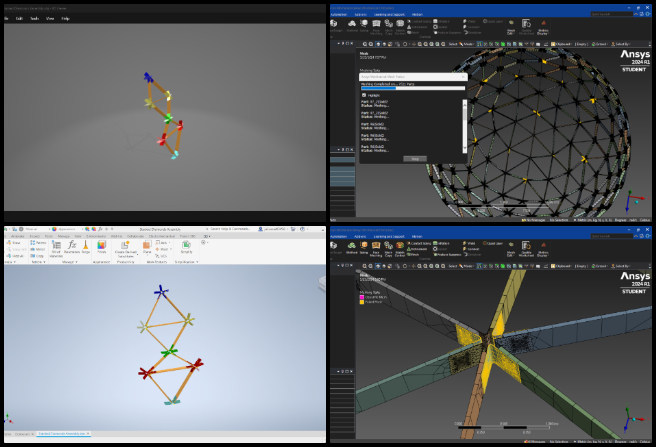



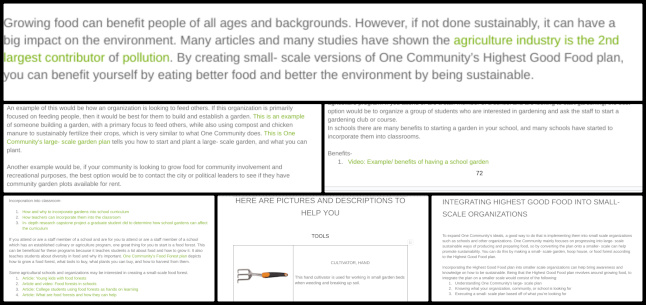

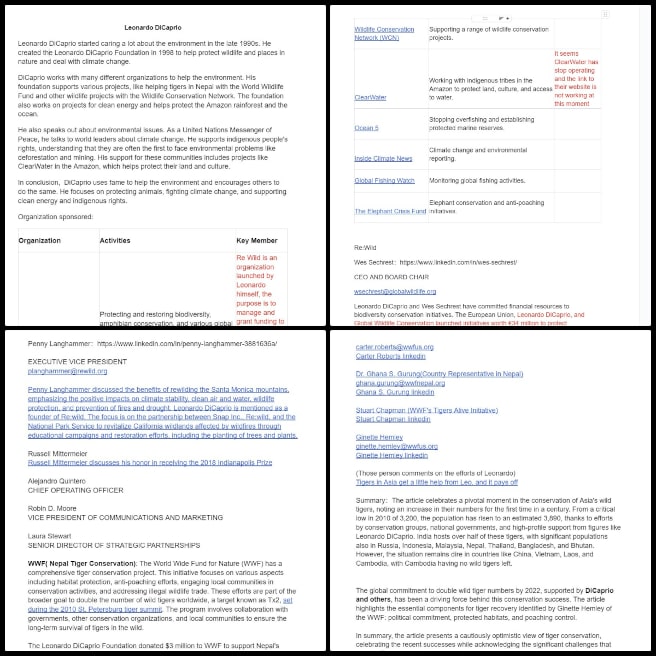
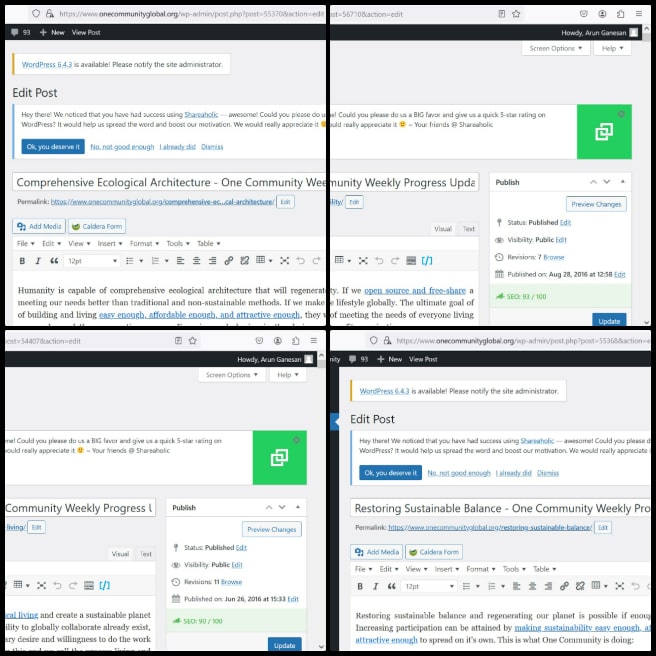
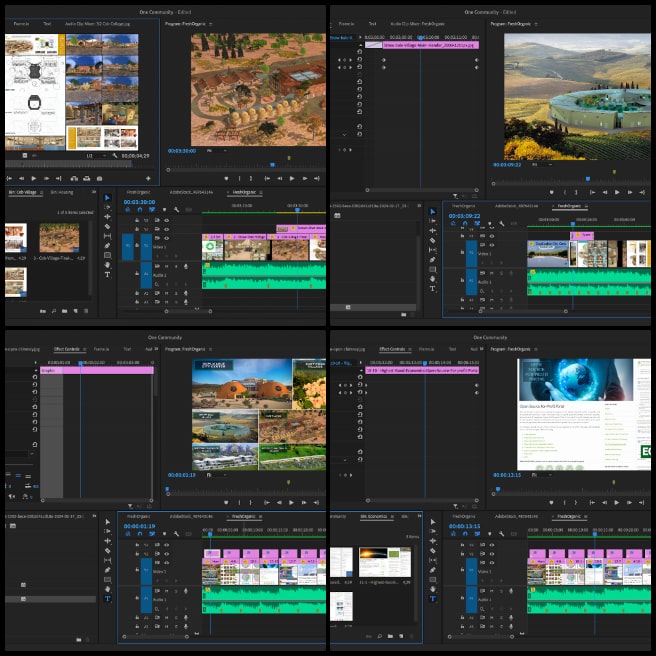


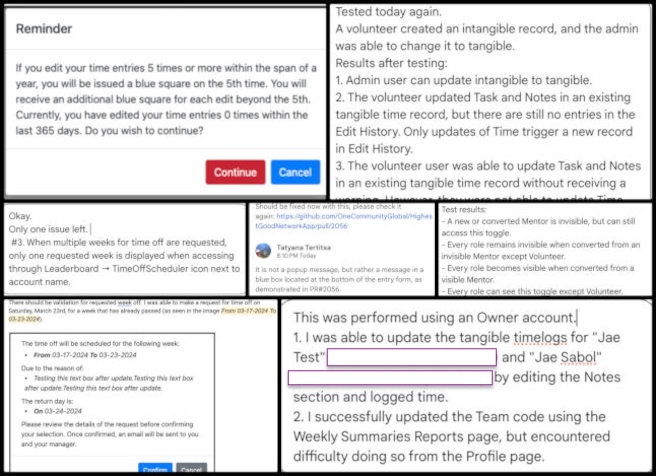

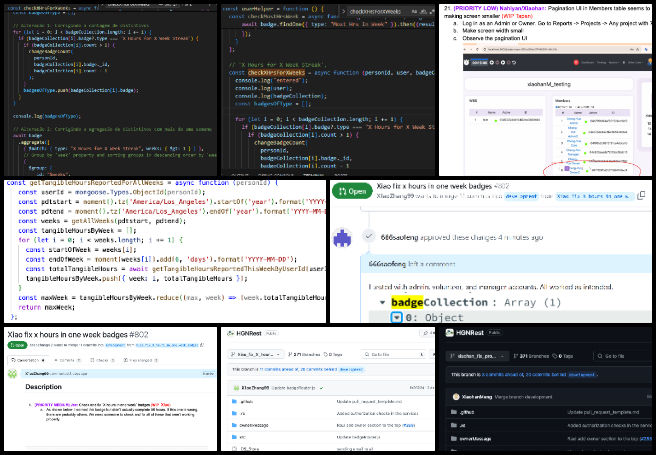








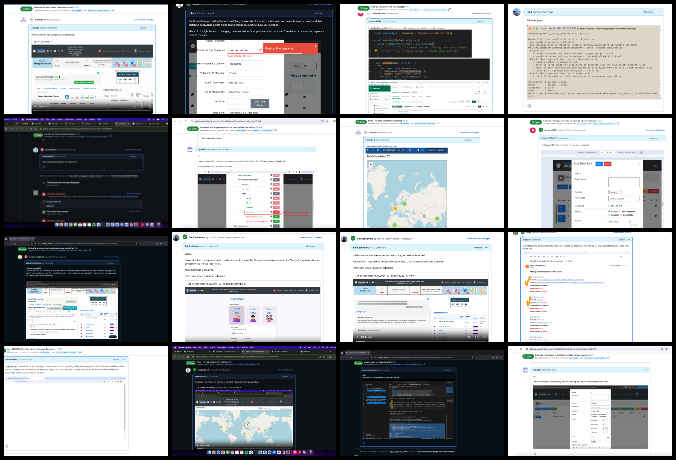



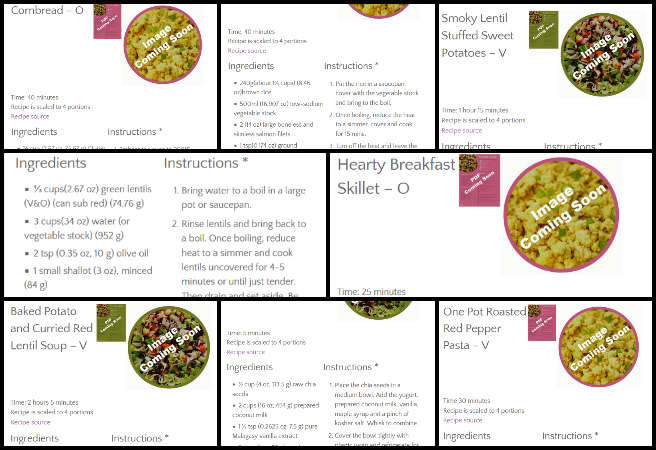

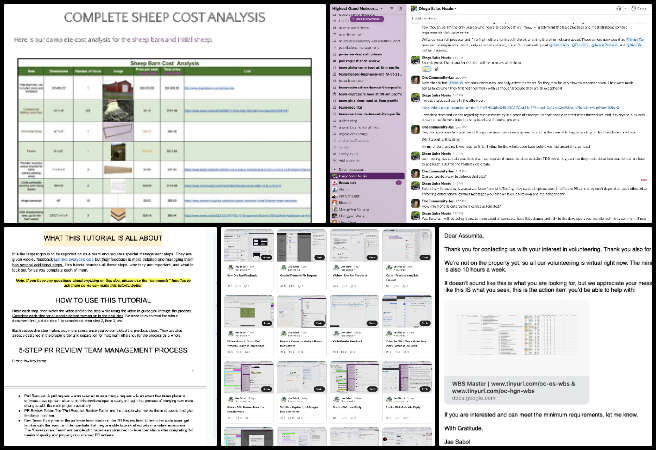





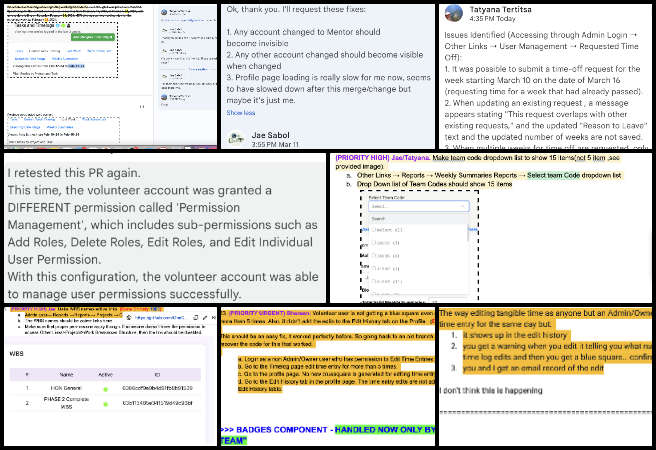


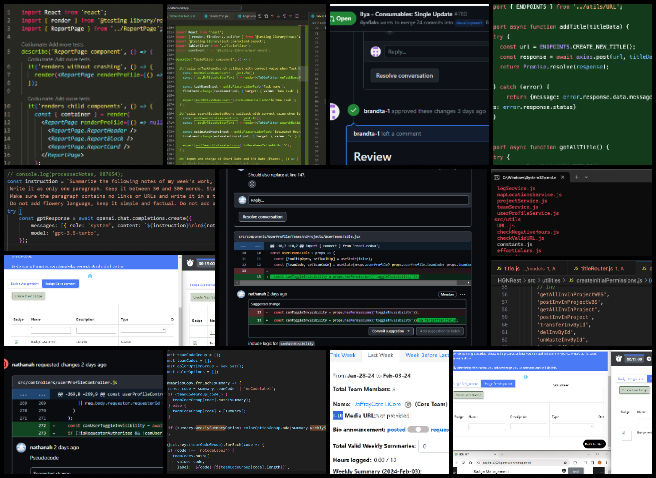

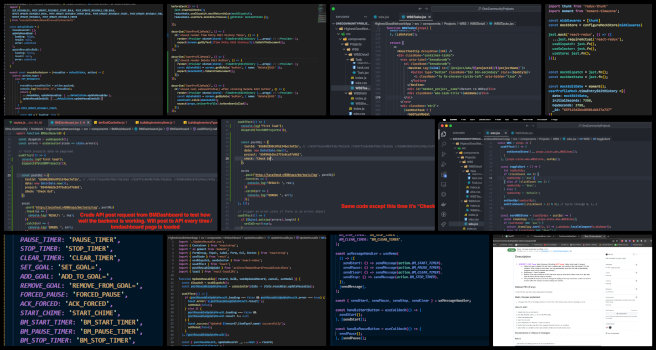
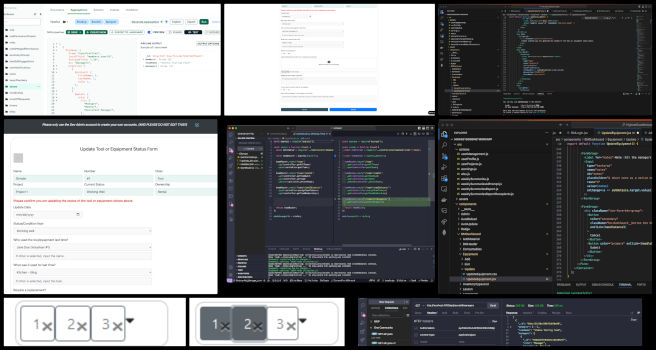

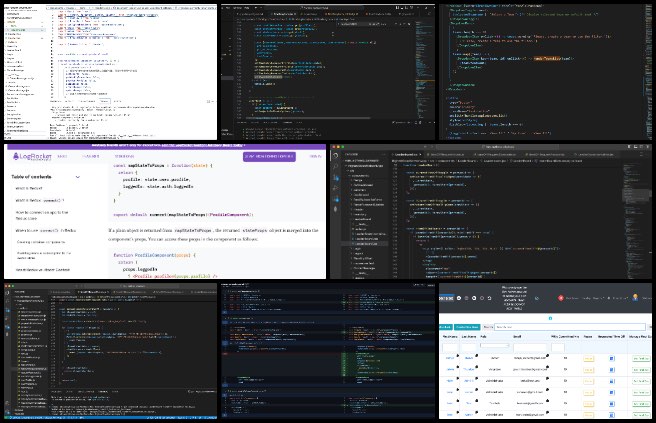


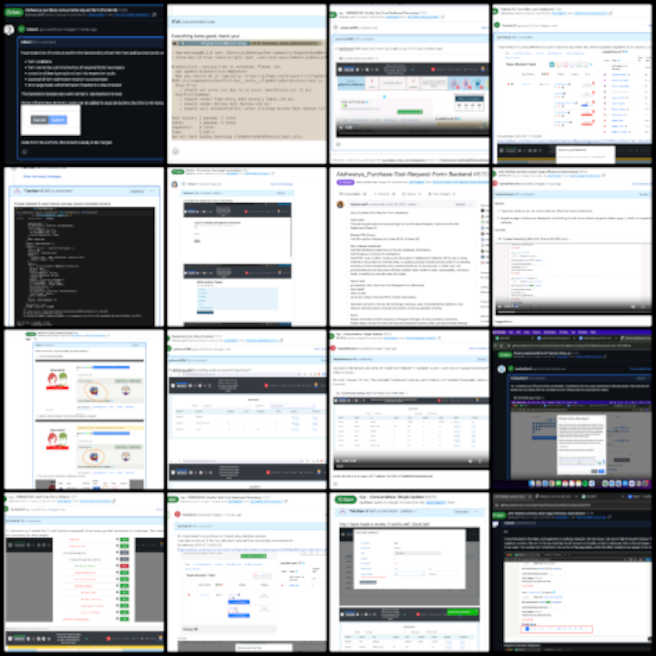
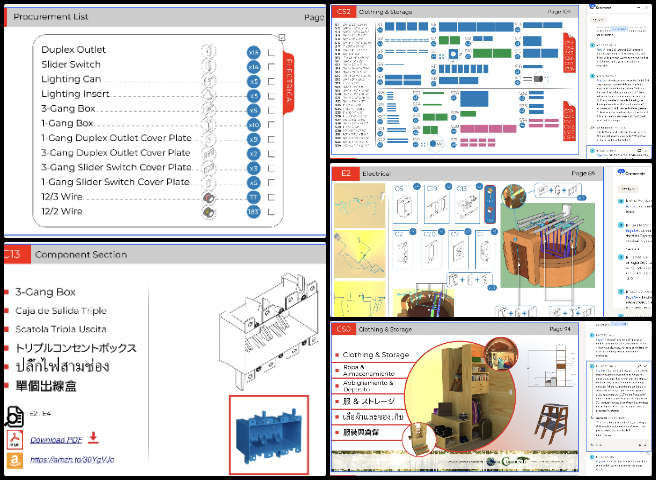









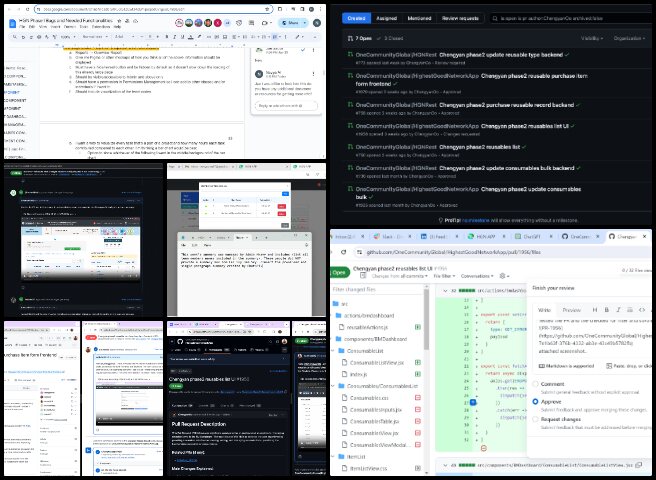
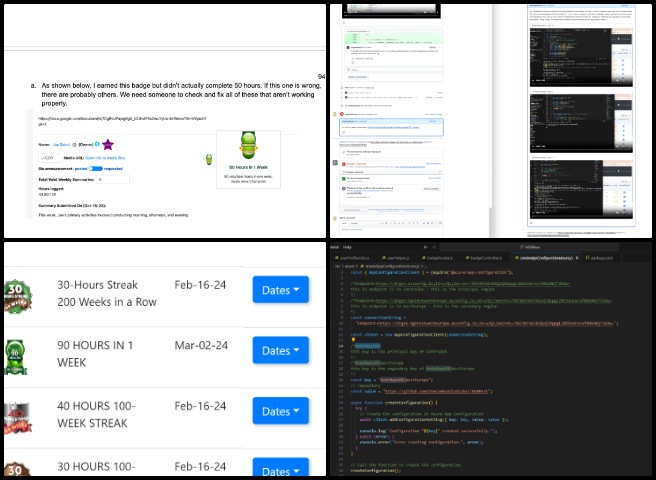







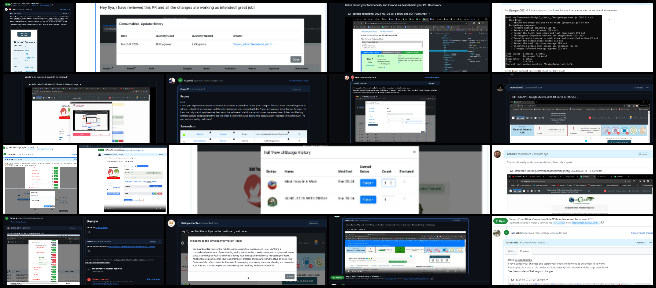
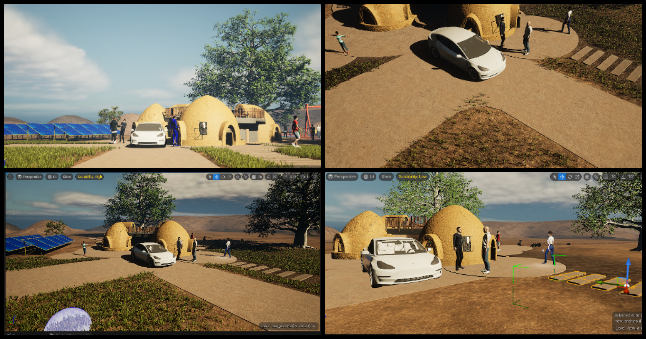






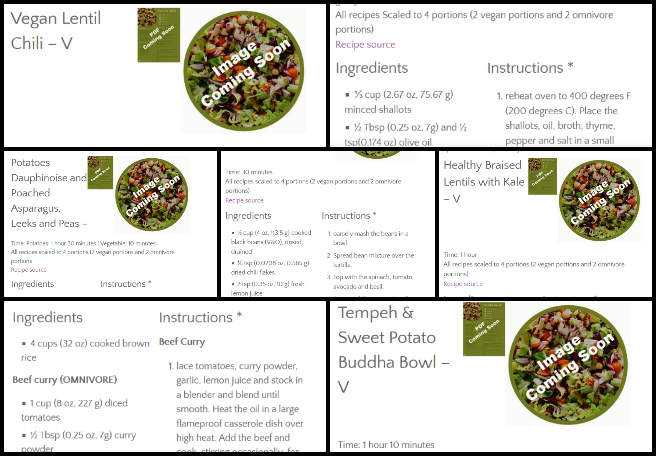














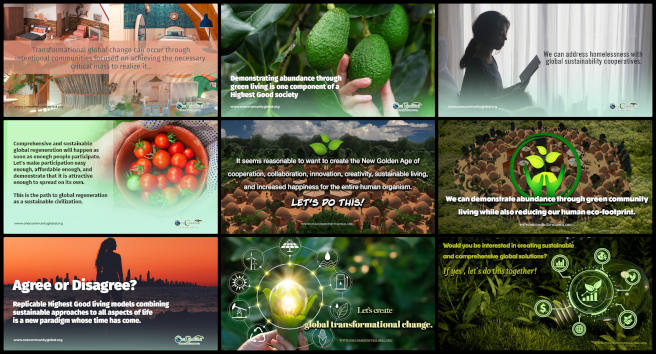





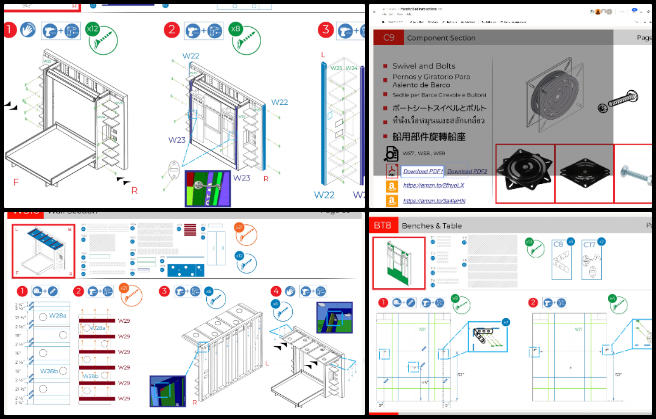


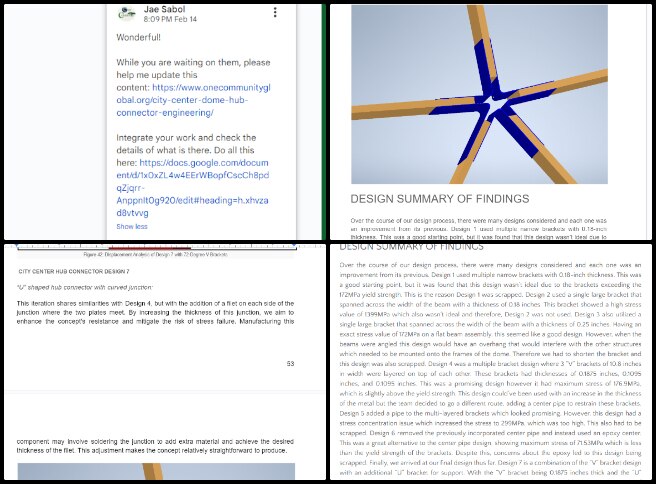

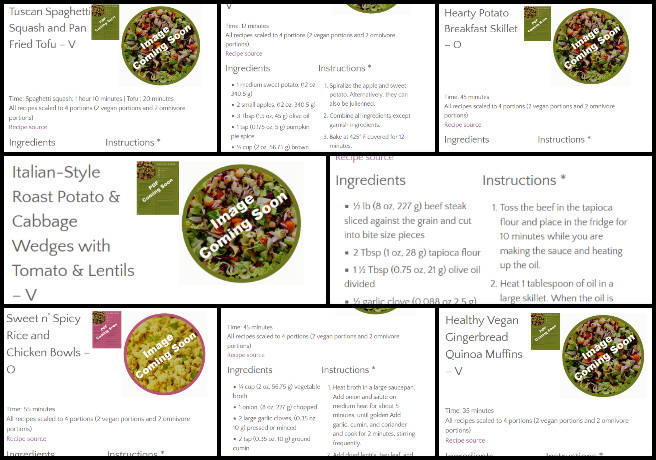


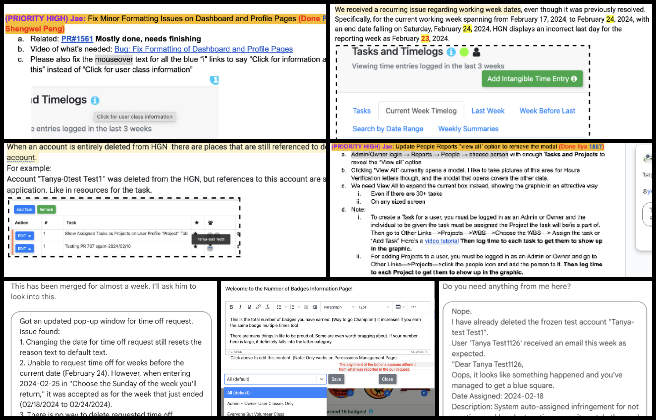



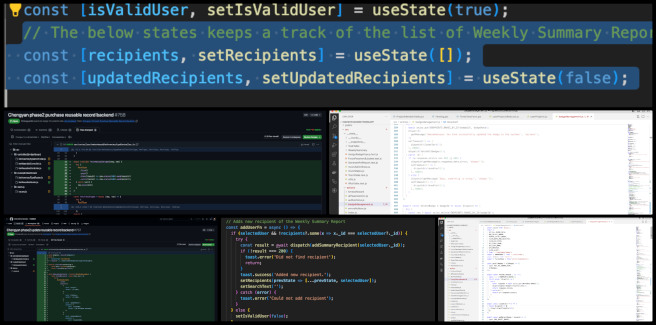



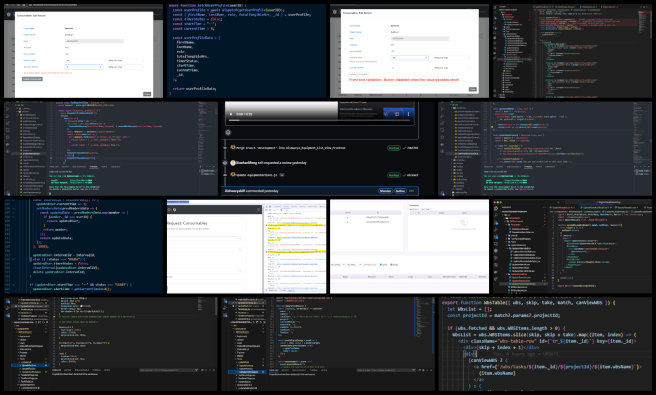
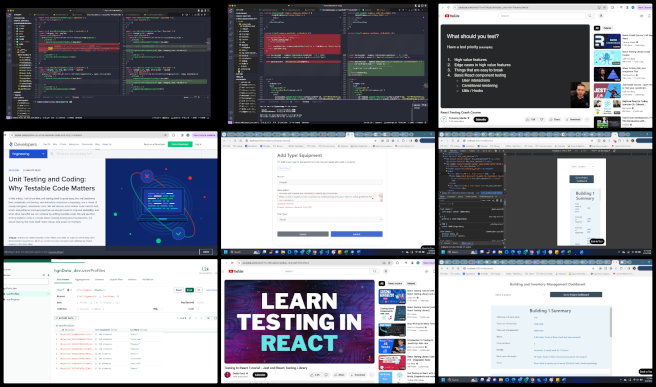




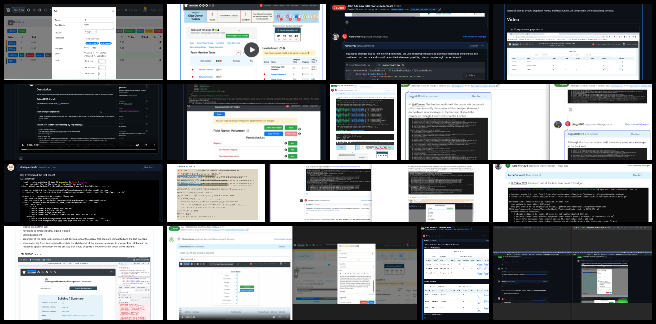
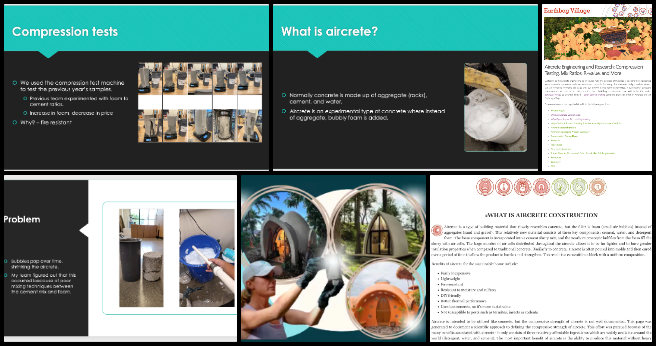



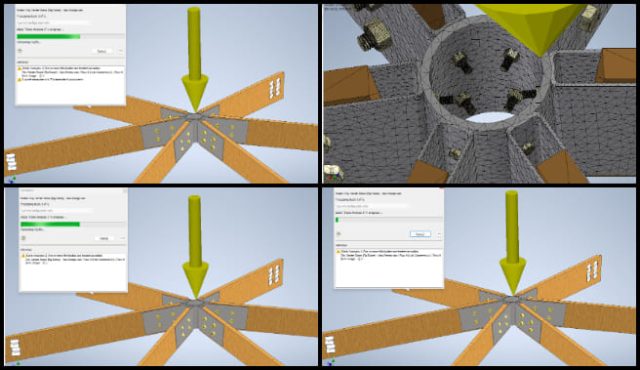



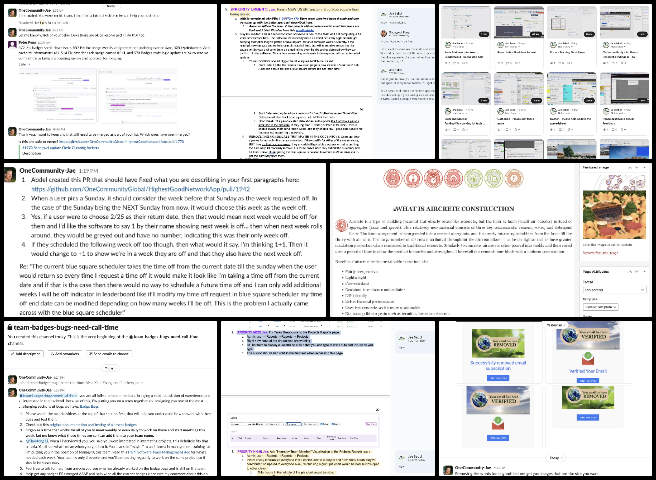









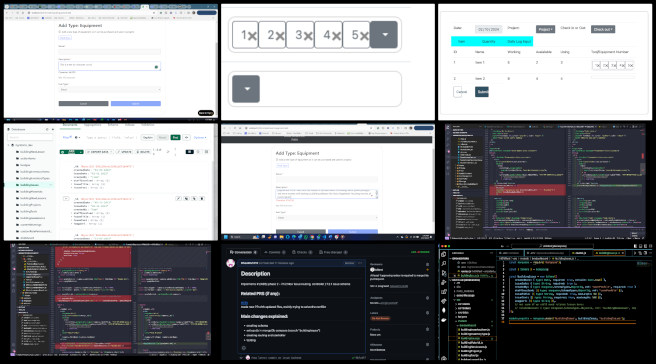

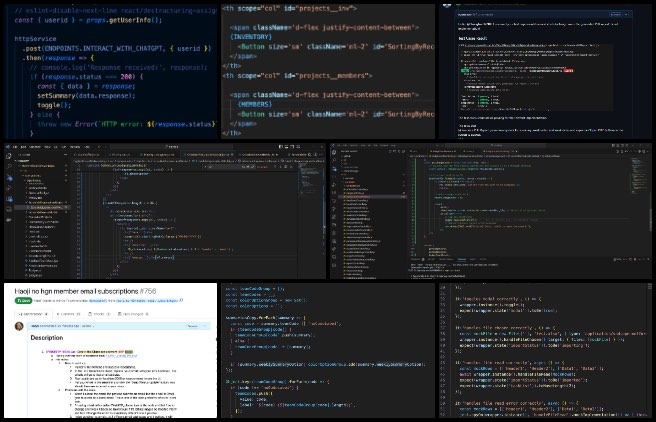


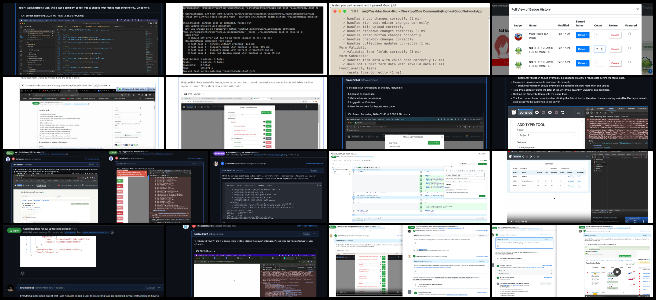
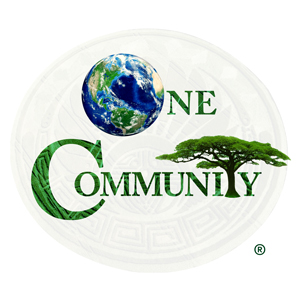


Connect with One Community